TRENDNET TEW823824 AC1750 Dual Band Wireless Router, AC1750 Dual Band Wireless Router with StreamBoostTM Technology User Manual
TRENDNET, Inc. AC1750 Dual Band Wireless Router, AC1750 Dual Band Wireless Router with StreamBoostTM Technology
TRENDNET >
User Manual.pdf
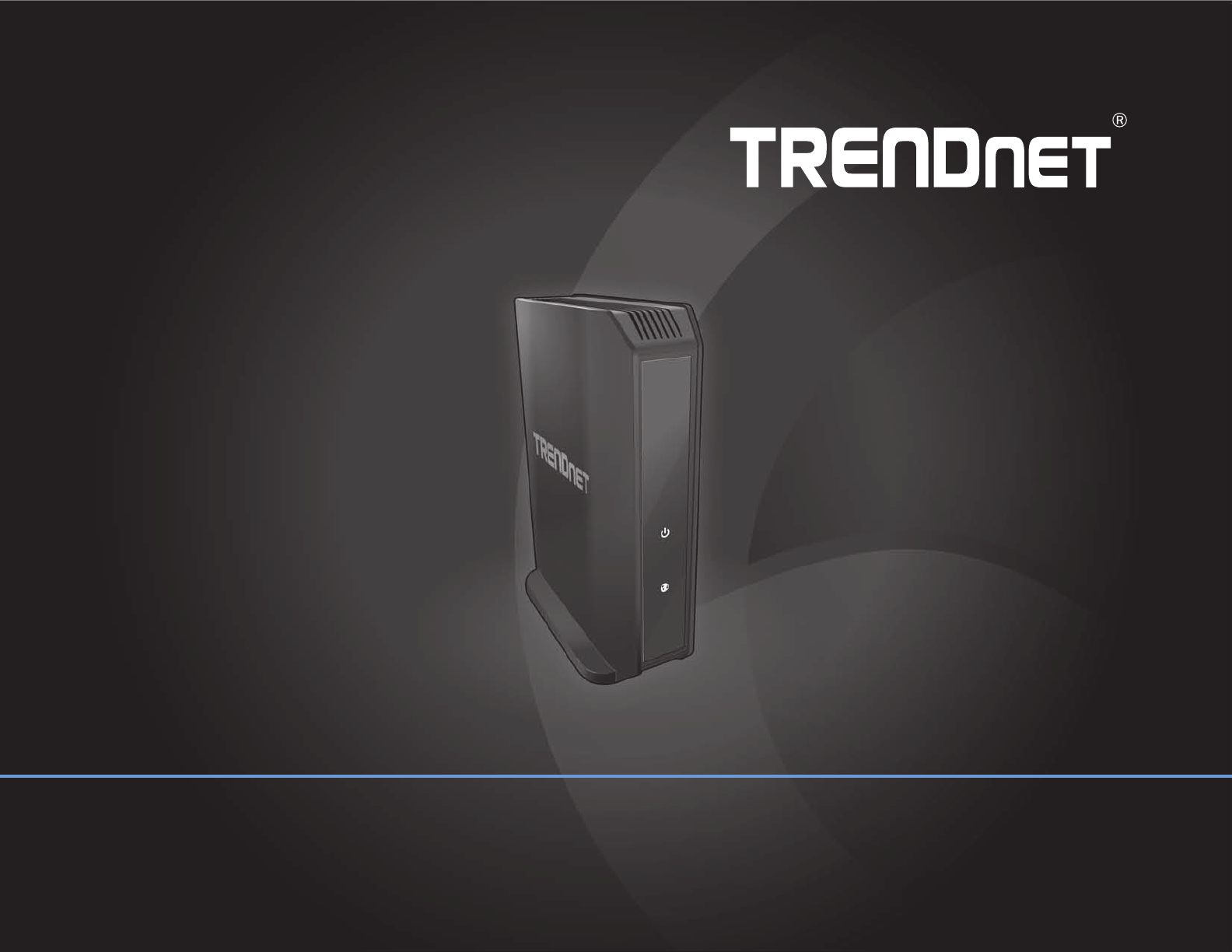
TEW-823DRU
User’s Guide
AC 1750 Dual Band Wireless Router

TRENDnet User’s Guide
Table of Contents
2
© Copyright 2014 TRENDnet. All Rights Reserved.
Table of Contents
Product Overview ........................................................................ 4
Features .................................................................................................... 4
Package Contents ..................................................................................... 4
Hardware Overview .................................................................................. 5
Front View ..................................................................................................... 5
Rear View ...................................................................................................... 5
Wireless Consideraons ........................................................................... 6
Connecon Performance .............................................................................. 6
Security Checklist .......................................................................................... 6
Installaon ..................................................................................6
Connect the Power ................................................................................... 6
Connect the Computer ............................................................................. 6
Check the Installaon ............................................................................... 7
Inial Setup .................................................................................7
Congure the Computer ........................................................................... 7
Windows 7/8/8.1 .......................................................................................... 7
Windows XP/2000 ........................................................................................ 7
Windows Vista .............................................................................................. 7
MAC OS 10.4/10.5/10.6 ............................................................................... 7
Setup Wizard ............................................................................................ 8
Basic Router Sengs ...................................................................8
Log in to Management Page ..................................................................... 8
Management Page Structure.................................................................... 9
Wireless Sengs .................................................................................... 10
Guest Network ....................................................................................... 12
Parental Control ..................................................................................... 12
Wireless Networking and Security .............................................14
Tips to Improve Wireless Recepon ....................................................... 14
Device Orientaon ...................................................................................... 15
Choose the Security Type for Wireless Network .................................... 15
Wireless Encrypon Types .......................................................................... 15
Connect Wireless Devices using WPS ..................................................... 18
Hardware Push Buon (PBC) Method (recommended) ............................. 18
PBC (Soware/Virtual Push Buon) ........................................................... 18
PIN (Personal Idencaon Number) ......................................................... 19
Connect Wireless Devices Using MAC Filter ........................................... 19
Advanced Wireless Sengs .................................................................... 20
Mulple SSID Connecons .......................................................................... 20
Wireless Bridging Using WDS ..................................................................... 21
Advanced Sengs ...................................................................................... 23
Advanced Router Sengs .......................................................... 24
Congure Manually the Internet Connecon ......................................... 24
Clone a MAC address .............................................................................. 25
Change the IP Address ............................................................................ 25
Congure the DHCP Server .................................................................... 26
Congure DHCP Reservaon .................................................................. 26
Add Stac Routes ................................................................................... 27
Enable Dynamic Roung......................................................................... 28
Enable/Disable UPnP .............................................................................. 29
Idenfy Your Network on the Internet ................................................... 29
Congure IPv6 Sengs ........................................................................... 30

TRENDnet User’s Guide
Table of Contents
3
© Copyright 2014 TRENDnet. All Rights Reserved.
Create Schedules .................................................................................... 30
Congure Access Control Rules .............................................................. 31
Block a specic service or mulple services ............................................... 31
Block All Services ......................................................................................... 32
Congure Inbound Filter Rules ............................................................... 32
Congure Firewall Sengs ..................................................................... 33
DMZ ............................................................................................................ 33
Virtual Server .............................................................................................. 33
Special Applicaons .................................................................................... 34
Gaming ....................................................................................................... 35
ALG .............................................................................................................. 36
Enable Remote Access ............................................................................ 37
Allow/Deny Ping Requests from the Internet ......................................... 37
Congure Quality of Service Sengs ..................................................... 38
Using External USB Storage .......................................................40
Congure File Sharing Server ................................................................. 40
Congure FTP Server .............................................................................. 41
Maintenance .............................................................................42
Change Login Password .......................................................................... 42
Set the Date and Time ............................................................................ 42
Backup System Sengs .......................................................................... 43
Load System Sengs .............................................................................. 43
Reset to Factory Defaults ....................................................................... 44
Reboot the System ................................................................................. 44
Update System Firmware ....................................................................... 44
View Wireless Client List......................................................................... 45
View System Informaon ....................................................................... 45
IPv6 Status .................................................................................................. 47
View Events Log ...................................................................................... 47
Appendix ................................................................................... 48
Regulatory and Safety Informaon......................................................... 48
Federal Communicaon Commission Interference Statement .................. 48
Europe – EU Declaraon of Conformity ..................................................... 48
Specicaons .......................................................................................... 50
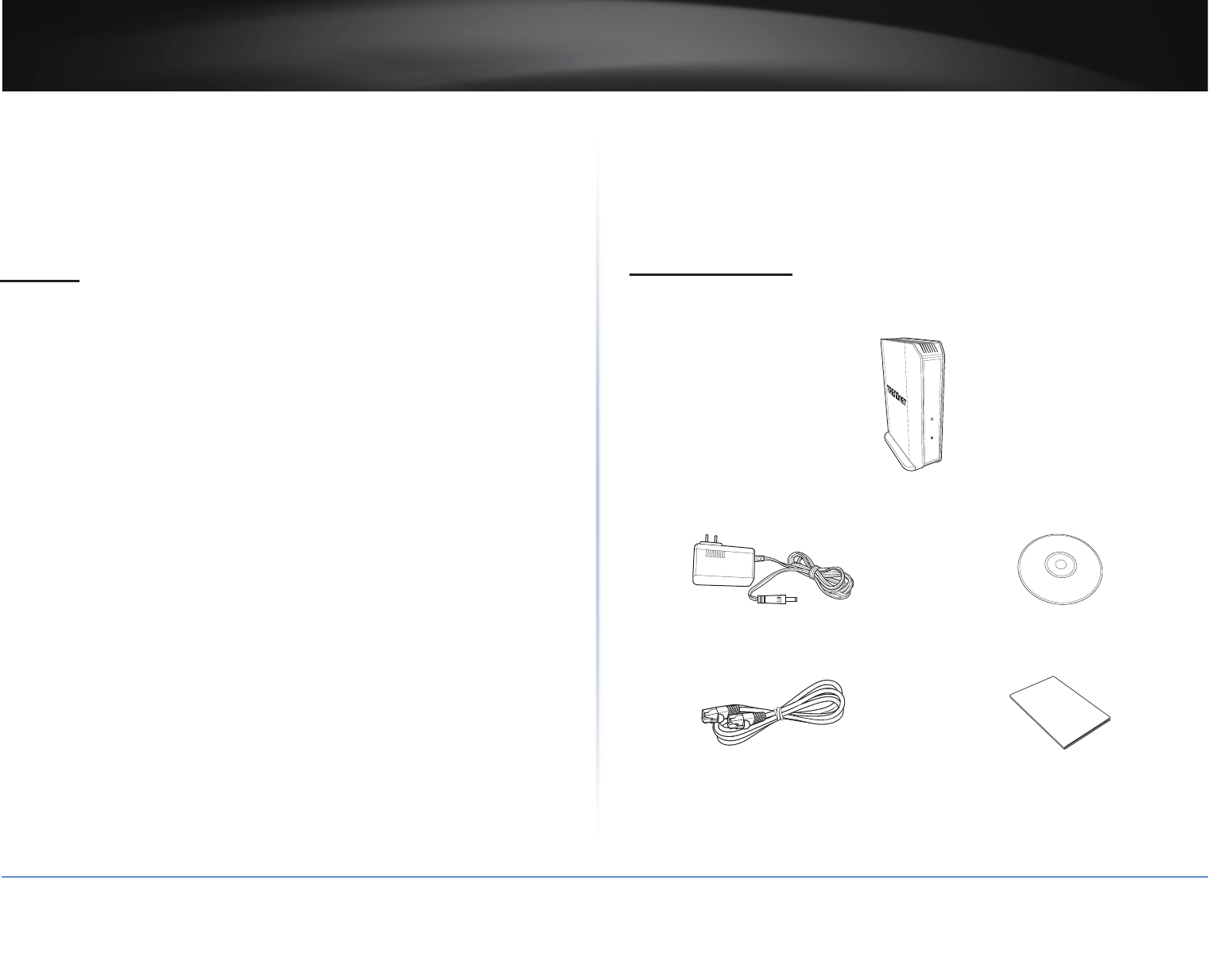
TRENDnet User’s Guide
TEW-823DRU
4
© Copyright 2014 TRENDnet. All Rights Reserved.
Product Overview
TRENDnet’s AC1750 Dual Band Wireless Router, model TEW-823DRU, produces the ulmate
wireless experience with gigabit wireless speeds. Manage two wireless networks—the
1300 Mbps Wireless AC band for the fastest wireless available and the 450 Mbps Wireless
N band to connect common wireless devices. The TEW-823DRU can easily handle the
demands of mulple HD streams in a busy connected home.
Features
9Compable with IEEE 802.11ac technology provides 3TX/3RX wireless speed up to
1300Mbps data rate.
9Compable with IEEE 802.11n high rate standard to provide wireless speed of 450Mbps
data rate.
9Compable with IEEE 802.11g high rate standard to provide wireless speed of 54Mbps
data rate.
9Simultaneously transmit both 2.4 GHz and 5 GHz wireless networks.
9IEEE 802.11b/g/n/ac Infrastructure operang modes.
94 x 10/100/1000Mbps Gigabit Ethernet port for LAN with Auto MDI-X funcon.
91 x 10/100/1000Mbps Gigabit Ethernet WAN port for ADSL / Cable Modem with Auto
MDI-X funcon.
9Supports Mulple Input Mulple Output(MIMO) technology with 3TX/3RX(11a/b/g/n/
ac).
9Allow auto fallback data rate for opmized reliability, throughput and transmission
range.
9Supports enhance security for WPA-PSK, WPA2-PSK, WPA and WPA2.
9Advance wireless security of up to WPA2-RADIUS.
9Web-based conguraon tools and management via WEB Browser.
9Supports Wi-Fi Mulmedia(WMM).
9Supports WPS (Wi-Fi Protected Setup Specicaon Windows).
9Supports PPPoE / PPTP / L2TP protocol for ADSL.
9Supports NAT for share 1 IP address to all LAN user.
9Supports DHCP Server / Client.
9Supports Firewall protecon, Virtual server mapping, Special applicaon seng.
9Supports UPnP.
9Supports stascs informaon.
9Supports IPv6 (Internet Protocol v6).
9Supports Wireless Distribuon System (WDS) for wireless network bridging.
9Plug in a USB ash or storage drive to share content across the network.
Package Contents
Check if your package contains the following items. If any item is missing or appears
damaged, contact your dealer.
TEW-823DRU Router
Power adapter (12V, 2A) CD-ROM with User’s Guide
Quick Start Guide
RJ-45 Ethernet cable (1.5m / 5.) Mul- Language Quick Installaon Guide
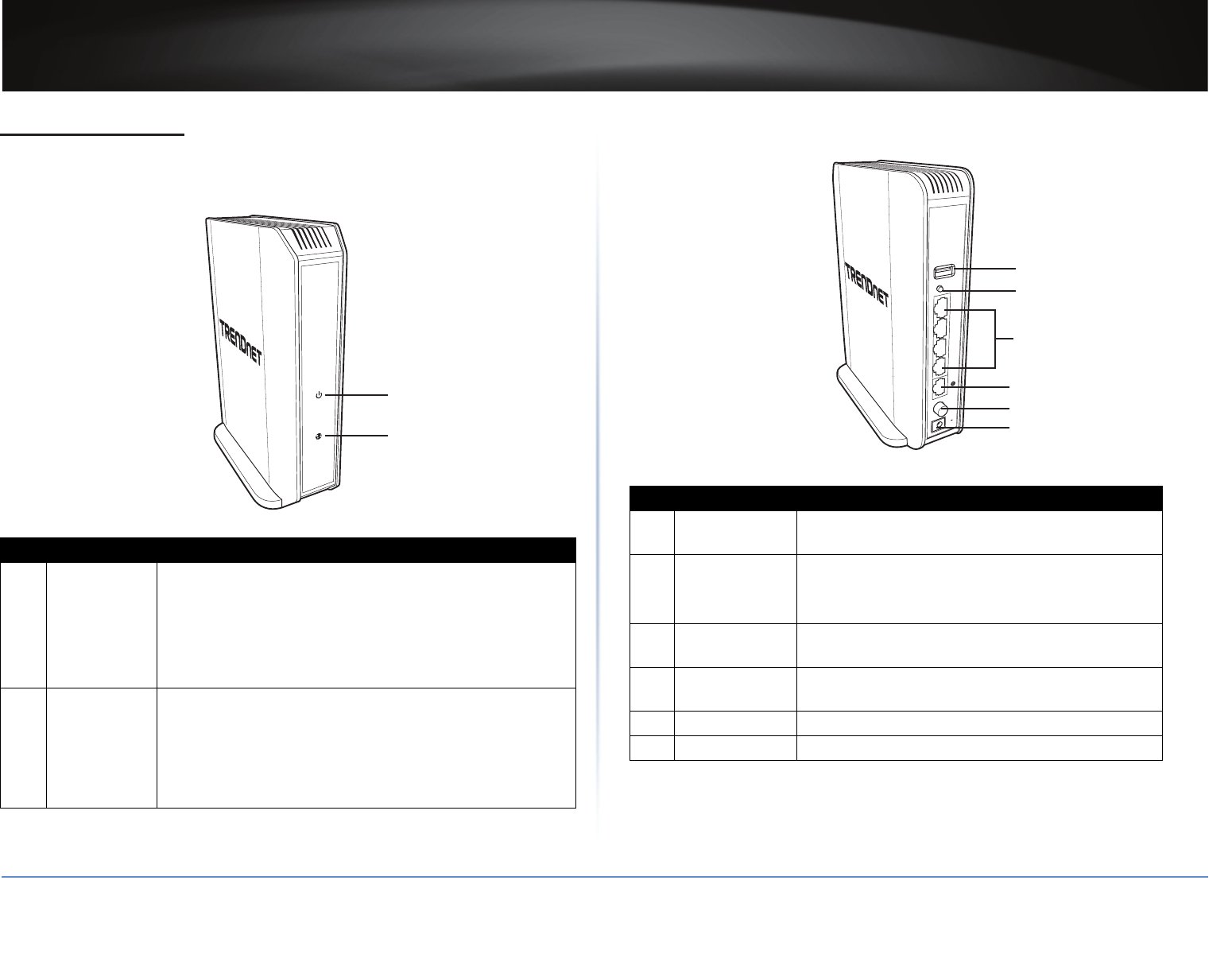
TRENDnet User’s Guide
TEW-823DRU
5
© Copyright 2014 TRENDnet. All Rights Reserved.
Hardware Overview
Front View
1
2
No.: Item Descripon
1 Power LED
Lights up when the router is powered on.
• Solid GREEN: Normal operaon.
• Blinking GREEN: WPS is acvated.
• O: No power.
ÍNote: The LED will stop blinking and remains solid GREEN
automacally aer the WPS process is completed.
2
Internet port
(Link/Acvity)
LED
Lights up to indicate Internet connecon status.
• Solid GREEN: Router is physically connected to the modem
network or Ethernet port with a network or Ethernet cable.
• Blinking GREEN: Data is transmied or received through
the Internet port of the router.
• O: No acve Internet connecon.
Rear View
POWER
4
3
2
1
USB
WPS
TEW-823DRU
12V 2A
1
2
3
4
5
6
No.: Item Descripon
1 USB 2.0 port Connect USB storage devices to share over the
network via FTP or Windows® SMB/CIFS, Samba.
2
WPS (Wi-Fi
Protected Setup)
buon
Press to acvate WPS.
ÍNote: The Power LED will blink when WPS is
acvated.
3 LAN ports 1~4 Connect the Ethernet cables from the router LAN ports
to your wired network devices.
4 Internet port Connect an Ethernet cable from the router Internet
port to your modem.
5 Power switch Push to switch the router on or o.
6 DC-in port Connect the supplied DC power input connector here.
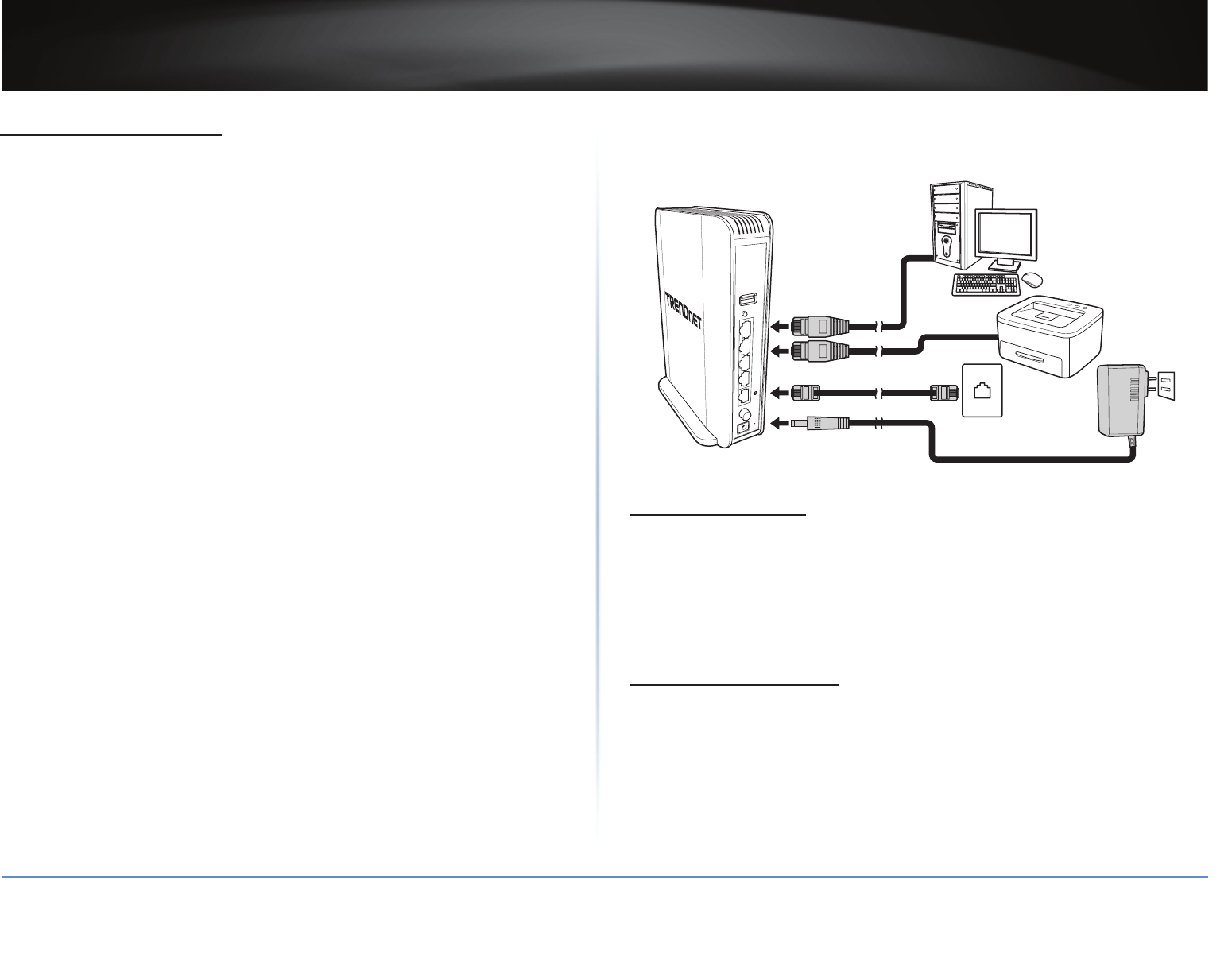
TRENDnet User’s Guide
TEW-823DRU
6
© Copyright 2014 TRENDnet. All Rights Reserved.
Wireless Consideraons
Connecon Performance
A number of factors aect the performance of wireless connecon. Consider the following
guidelines to ensure high-range and stable connecvity.
9Keep the router and other wireless devices away from obstrucons, such as walls or
buildings. Each obstrucon can reduce the range of a wireless device.
9Keep the router and other wireless devices away from devices that produce radio
frequency (RF) noise, such as microwave ovens or radios.
9Keep the router and other wireless devices away from any device operang on the
2.4GHz frequency, such as cordless phones or remote controls.
9Antenna orientaon aects the wireless signal. Determine the best orientaon and
adjust the antenna posion of your device.
Security Checklist
Wireless networks are easy to install and convenient to use. However, wireless network
signals can also be intercepted easily. To prevent unauthorized users from connecng to
your wireless network, follow the guidelines below.
9Change the default wireless network name.
Your device has a default Service Set Idener (SSID) which is the wireless network
name. Change the SSID with a unique name to idenfy your network. The SSID can be
up to 32 characters in length.
9Change the default password.
Your device has a default password. You have to enter this password to change your
network sengs. Change the password to prevent unauthorized user from intruding
into your network and changing the sengs.
9Enable MAC address ltering.
Your device supports Media Access Control (MAC) address ltering. You can assign a
MAC address on each computer that you want to connect to your wireless network.
When MAC address ltering is enabled, only the computers with the specied MAC
addresses are allowed access.
9Enable encrypon
Your device supports Wired Equivalent Privacy (WEP), and Wi-Fi Protected Access
(WAP/WPA2) encrypon. To ensure a high level of security, enable the highest
security encrypon and use strong passphrases, avoid using words that can be found
in the diconary.
Installaon
Make sure that all devices are powered o before starng installaon.
POWER
4
3
2
1
USB
WPS
TEW-823DRU
12V 2A
Connect the Power
1 Connect the power adapter to the power port of your router.
2 Plug the power adapter to a power outlet.
3 Push the Power buon to turn your router on.
ÍNote: Use only the supplied power adapter. Using other power adapters may cause
damage to the device.
Connect the Computer
1 Connect one end of the RJ-45 cable to the LAN port of your router.
2 Connect the other end of the RJ-45 cable to the LAN port of the computer.

TRENDnet User’s Guide
TEW-823DRU
7
© Copyright 2014 TRENDnet. All Rights Reserved.
Check the Installaon
To ensure that all devices are properly connected, check the LED indicators on the front of
your router. For basic installaon, the following LED must be lit:
9Power LED
9Internet port LED
The lighted LED indicators vary depending on the type of connecon that you make. Refer
to “Front View” on page 5 for more informaon about the LED indicators.
Inial Setup
Congure the Computer
ÍNote: The following procedures on conguring the network sengs can be used as
general guidelines. It is strongly recommended that you consult your computer or
operang system manufacturer directly for assistance on the proper procedure for
conguring the network sengs.
Windows 7/8/8.1
1 Open Control Panel and click Network and Sharing Center.
2 Click Change Adapter Sengs and right-click the Local Area Connecon icon.
3 Click Properes > Internet Protocol Version 4 (TCP/IPv4).
4 Click Obtain an IP address automacally and click OK.
Windows XP/2000
1 Open Control Panel and double-click the Network Connecon icon.
2 Right-click the Local Area Connecon icon and then click Properes.
3 Click Internet Protocol (TCP/IP) > Properes.
4 Click Obtain an IP address automacally and click OK.
Windows Vista
1 Open Control Panel and click Network and Internet.
2 Click Manage Network Connecons and right-click the Local Area Connecon icon >
Properes.
3 Click Internet Protocol Version (TCP/IPv4) > Properes.
4 Click Obtain an IP address automacally and click OK.
MAC OS 10.4/10.5/10.6
1 From the Apple, drop-down list, select System Preferences.
2 Click the Network icon.
3 From the Locaon drop-down list, select Automac.
4 Select and view your Ethernet connecon. Do one of the following:
ͫIn MAC OS 10.4, from the Show drop-down list, select Built-in Ethernet and select
the TCP/IP tab.
ͫ In MAC OS 10.5/10.6, in the le column, select Ethernet.
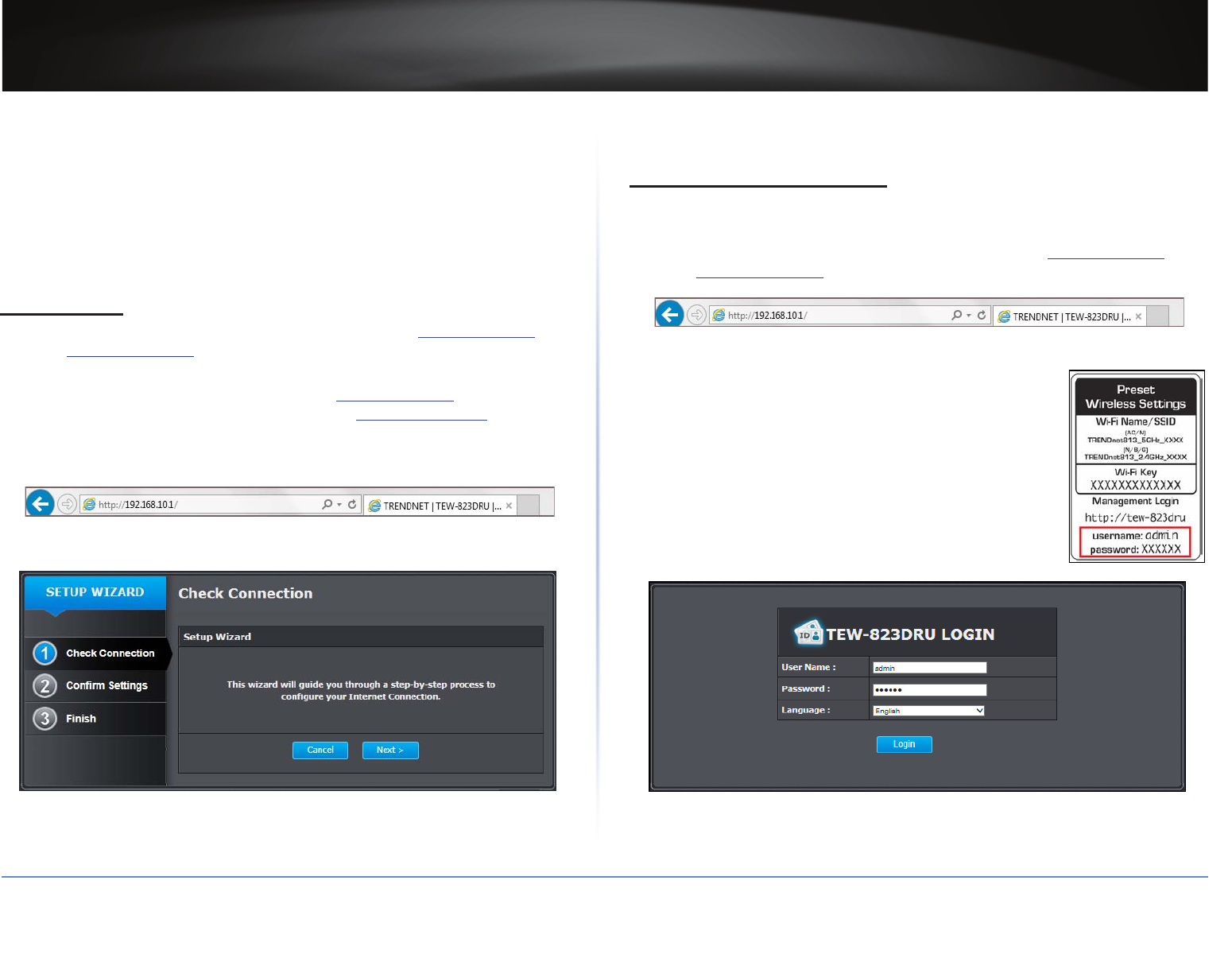
TRENDnet User’s Guide
TEW-823DRU
8
© Copyright 2014 TRENDnet. All Rights Reserved.
5 Congure TCP/IP to use DHCP. Do one of the following:
ͫIn MAC 10.4, from the Congure IPv4, drop-down list, select Using DHCP and click
the Apply Now buon.
ͫIn MAC 10.5, from the Congure drop-down list, select Using DHCP and click the
Apply buon.
6 Restart your computer.
ÍNote: If you are experiencing dicules, please contact your computer or operang
system manufacturer for assistance.
Setup Wizard
1 Open your web browser and enter the URL/domain name hp://tew-823dru or IP
address hp://192.168.10.1. The wizard will automacally appear.
ÍNote: If you have already congured your router before, the wizard will no longer
appear automacally. In your web browser, enter hp://tew-823dru or you can access
the router management using the default IP address hp://192.168.10.1. Your router
will prompt you for a user name and password. Enter your user name and password
and click Advanced > Setup > Wizard.
2 Follow the on-screen instrucons to congure your Internet Connecon.
Basic Router Sengs
Log in to Management Page
ÍNote: You can access your through the use of your Internet web browser, such as
Internet Explorer®, Firefox®, Chrome™, Safari®, Opera™.
1 Open your web browser and enter the URL/domain name hp://tew-823dru or IP
address hp://192.168.10.1.
2 Enter the user name, password, and select your preferred language.
ÍNote:
ͳThe default user name is “admin”.
ͳFor security purposes, the router is precongured with a
unique password. You can nd the Password on a scker on
the side of the router and on the label on the boom of the
router.
ͳUser name and password are case sensive.
3 Click Login.
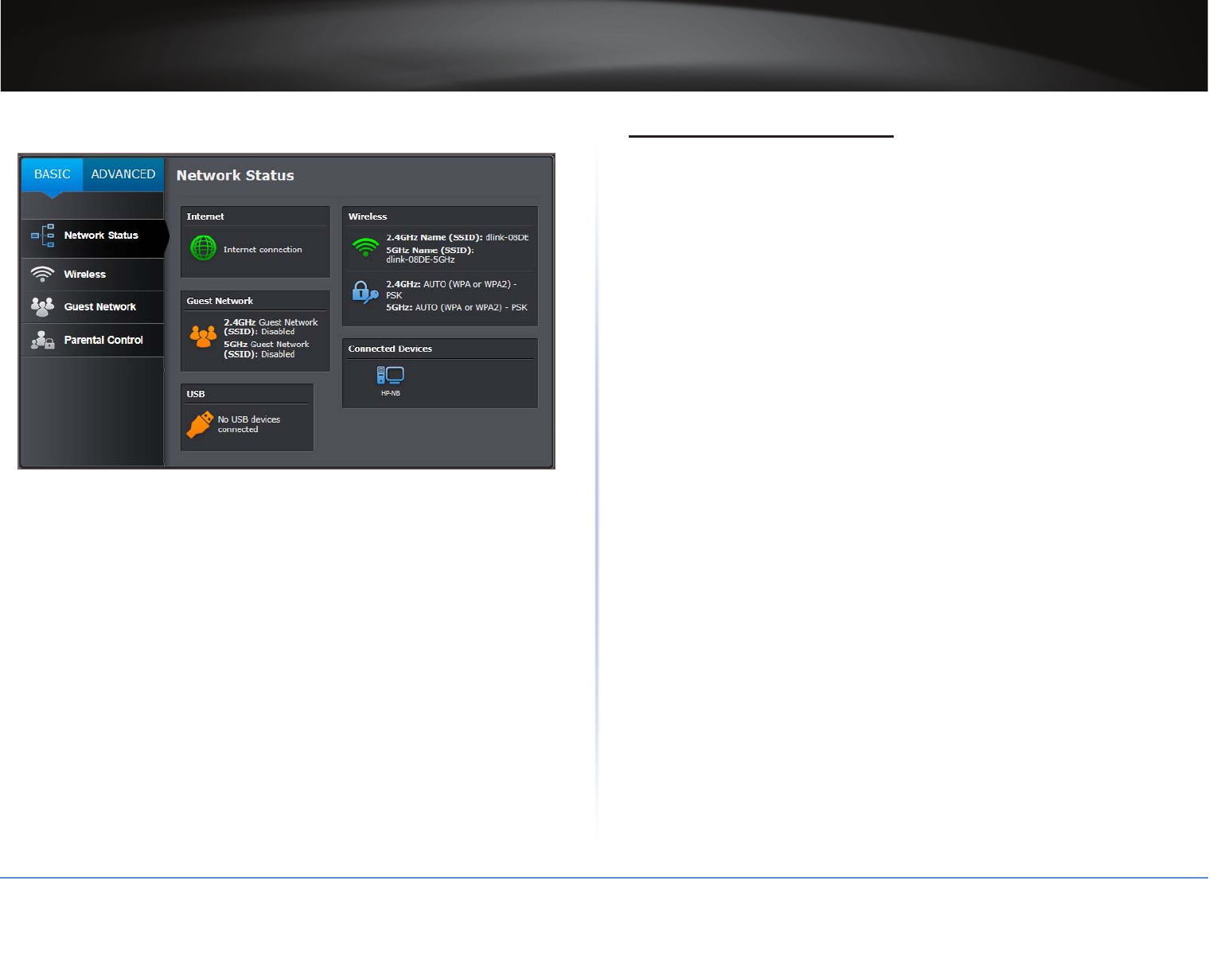
TRENDnet User’s Guide
TEW-823DRU
9
© Copyright 2014 TRENDnet. All Rights Reserved.
The management page opens. Management Page Structure
Basic
• Network Status
• Wireless
2.4GHz Sengs &
Security
5GHz Sengs &
Security
• Guest Network
• Parental Control
MAC/IP Address
Filter
Website Filter
Advanced
• Administrator
Status Informaon
IPv6 Status
Informaon
System Log
Advanced Network
(UPnP)
Sengs Management
(Export/Import
conguraon / Reset
to factory default /
Reboot)
Time and Date
Sengs
• Setup
LAN Sengs (IP
Address Sengs /
DHCP Server Seng /
DHCP Reservaon)
WAN Sengs
Roung
IPv6 Sengs
Schedule
Firmware
Management
(Administrator
Password / Dynamic
DNS / Remote
Management)
Advanced (connued)
QoS
Wizard
• Wireless 2.4GHz
WDS
Advanced
Mulple SSID
MAC Filter (Wireless)
WPS
Staon List
• Wireless 5GHz
WDS
Advanced
Mulple SSID
MAC Filter (Wireless)
WPS
Staon List
• Security
Access Control (IP
Protocol Filter)
Inbound Filter
• Firewall
DMZ
Virtual Server
Special Applicaons
Gaming
ALG
• USB
File Sharing Server
FTP Server
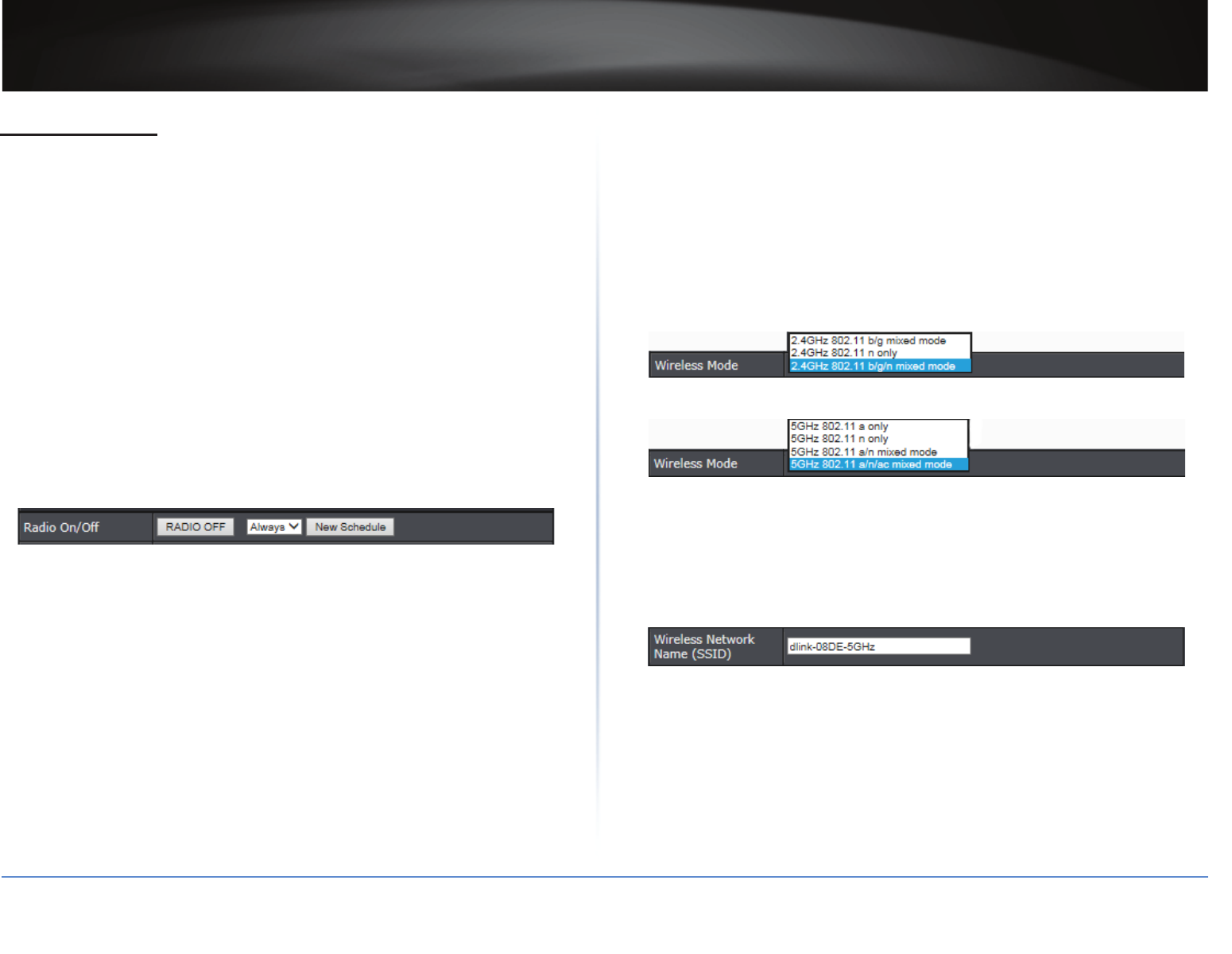
TRENDnet User’s Guide
TEW-823DRU
10
© Copyright 2014 TRENDnet. All Rights Reserved.
Wireless Sengs
Basic > Wireless (2.4GHz or 5GHz)
ÍNote: Refer to “Choose the Security Type for Wireless Network” on page 15 for
informaon on choosing the security type for wireless network.
This secon allows you to congure the basic sengs required for your wireless network
such as your wireless network name (SSID) and Wi-Fi key.
1 Log into your router management page (refer to “Log in to Management Page” on page 8).
2 Click on Basic > Wireless tab.
3 Modify any of the sengs in Wireless 2.4GHz or Wireless 5GHz secon and click Apply
to save the changes.
ͫRadio On/O: Click the radio on/o buon to enable/disable the wireless radio.
ÍNote: It is recommended to keep wireless radios enabled.
New Schedule: Click New Schedule to select the pre-dened schedule to apply.
The lter will only be acve during the me period dened in the pre-dened
schedule.
ÍNote: Before applying scheduling, please ensure your Time sengs are congured
correctly and you have dened a schedule. Please refer to “Set the Date and Time”
on page 42 and “Create Schedules” on page 30 to create a schedule.
ͫWireless Mode: Select the appropriate transmission mode. When applying the
Wireless Mode seng, please keep in mind the following:
ͳ Wireless devices that support 802.11n are backwards compable and can connect
wirelessly at 802.11g or 802.11b.
ͳ Wireless devices that support 802.11ac are backwards compable and can
connect wirelessly at 802.11n or 802.11a.
ͳ Connecng at 802.11b or 802.11g will limit the capability of your 802.11n
supported wireless devices from obtaining higher performance and data rates.
ͳ Connecng at 802.11a or 802.11n will limit the capability of your 802.11ac
supported wireless devices from obtaining higher performance and data rates.
ͳAllowing 802.11b or 802.11g devices to connect to an 802.11n capable wireless
network may degrade the wireless network performance below the higher
performance and data rates of 802.11n.
ͳAllowing 802.11a or 802.11n devices to connect to an 802.11ac capable wireless
network may degrade the wireless network performance below the higher
performance and data rates of 802.11ac.
ͳWireless devices that only support 802.11n or 802.11a will not be able to connect
to a wireless network that is set to 802.11ac only mode.
ͳWireless devices that only support 802.11b or 802.11g will not be able to connect
to a wireless network that is set to 802.11n only mode.
ͳWireless devices that only support 802.11b will not be able to connect to a
wireless network that is set to 802.11g only mode.
ͳWireless devices that only support 802.11a will not be able to connect to a
wireless network that is set to 802.11n only mode.
Wireless 2.4GHz
Wireless 5GHz
ͫWireless Network Name (SSID): Enter the wireless name (SSID) for your wireless
network.
ÍNote: This acronym stands for Service Set Idener and is the name of your
wireless network. It dierenates your wireless network from others around you.
By default, the router’s wireless name is unique to the device. If you choose to
change the SSID, change it to a name that you can easily remember.
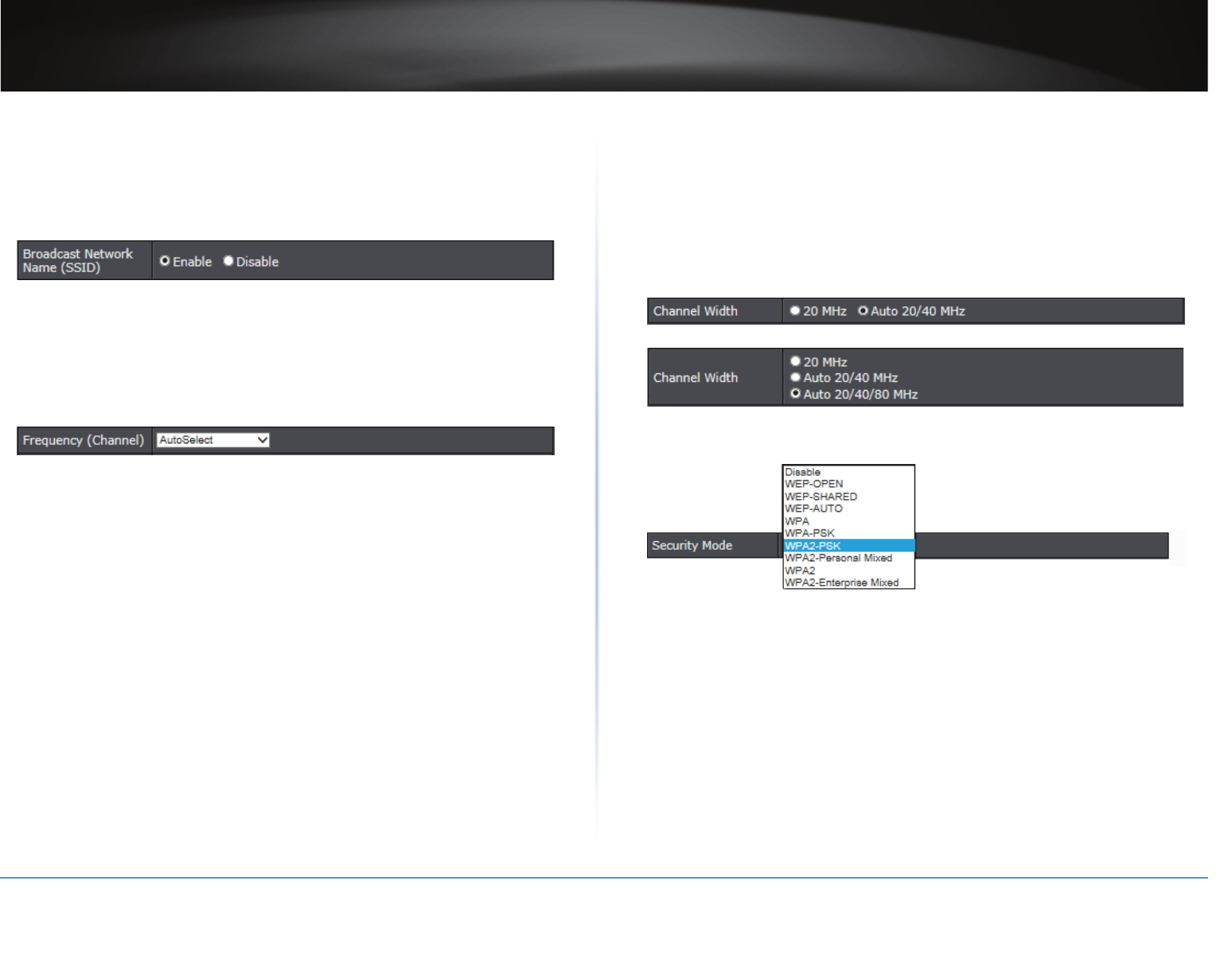
TRENDnet User’s Guide
TEW-823DRU
11
© Copyright 2014 TRENDnet. All Rights Reserved.
ͫBroadcast Network Name (SSID)
ͳEnable: Allows wireless devices to search and discover your wireless network
name (also called SSID) broadcasted by your router.
ͳDisable: Turns o the ability for wireless devices to nd your network. It is sll
possible for wireless devices to be congured to connect to your wireless network.
Disabling this seng will disable WPS funconality.
ͫEnable Auto Channel Scan: Check this opon to set your router to scan for which
wireless channels to use automacally.
ͫFrequency (Channel): Selecng the Auto opon will set your router to scan for the
appropriate wireless channel to use automacally. Click the drop-down list and select
the desired Channel for wireless communicaon. The goal is to select the Channel
that is least used by neighbouring wireless networks.
ͫChannel Width: Select the appropriate channel width for your wireless network. This
seng only applies to 802.11n and 802.11ac.
ͳFor greater 802.11n performance, select Auto 20/40MHz.
ͳFor greater 802.11ac performance, select Auto 20/40/80MHz.
It is recommended to use the default channel width sengs.
ÍNote: Please note that the default sengs may provide more stability than the
higher channel bandwidth sengs such as Auto 20/40/80MHz for connecvity in
busy wireless environments where there are several wireless networks in the area.
ͳ20MHz: This mode operates using a single 20MHz channel for wireless devices
connecng at 802.11n on both 2.4GHz and 5GHz. This seng may provide more
stability than 20/40MHz (Auto) for connecvity in busy wireless environments
where there are several neighbouring wireless networks in the area.
ͳAuto 20/40MHz (11n) or Auto 20/40/80MHz (11ac): When this seng is acve,
this mode is capable of providing higher performance only if the wireless devices
support the channel width sengs. Enabling Auto 20/40MHz or Auto 20/40/80
MHz typically results in substanal performance increases when connecng an
802.11ac/n wireless client.
4 In Security secon, click Security Mode drop-down list to select your wireless security
type.
For more informaon on security, refer to “Choose the Security Type for Wireless Network”
on page 15.
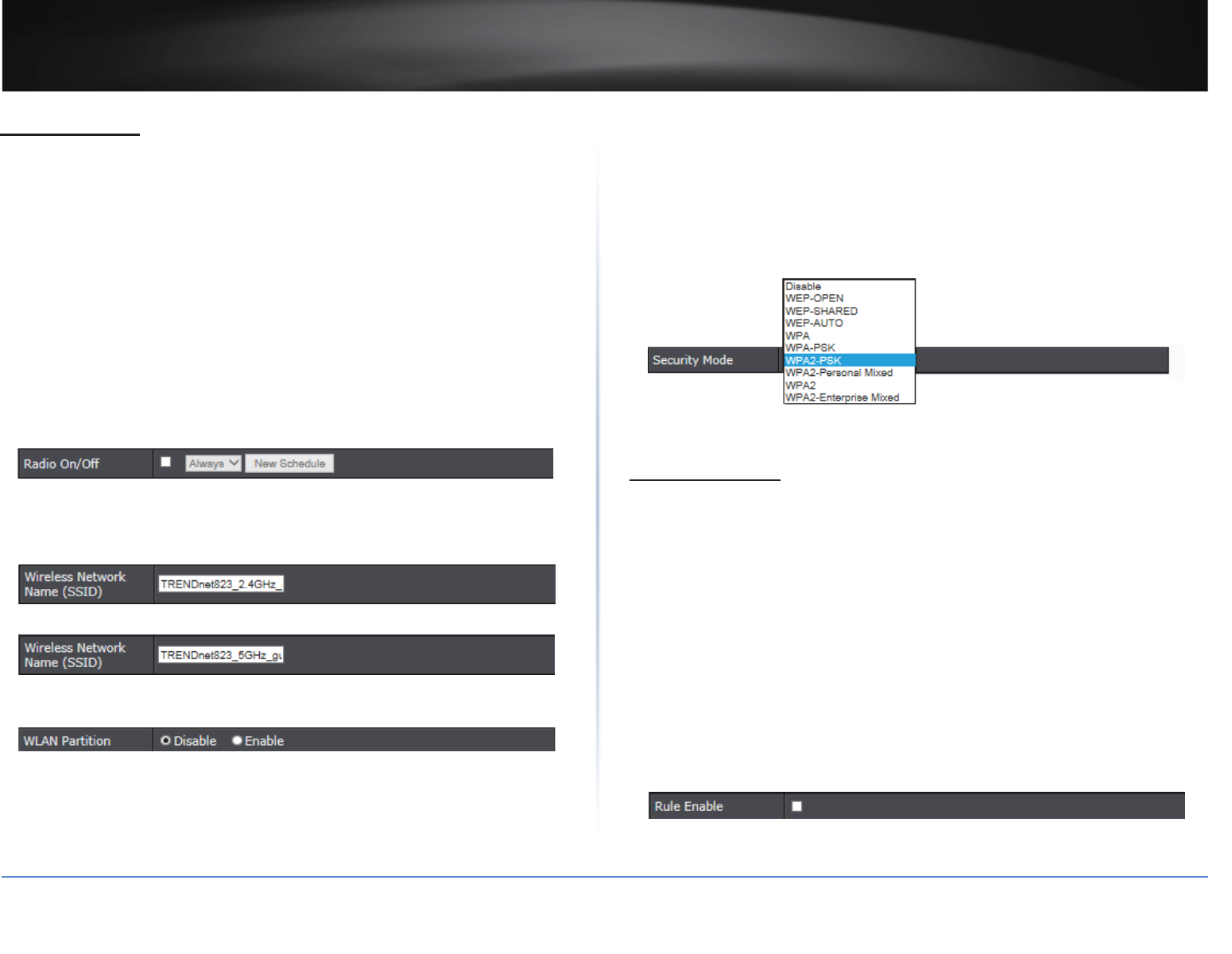
TRENDnet User’s Guide
TEW-823DRU
12
© Copyright 2014 TRENDnet. All Rights Reserved.
Guest Network
Basic > Guest Network (2.4GHz or 5GHz)
Creang an isolated and separate wireless guest network (2.4GHz or 5GHz) allows wireless
clients to connect to your network for Internet access only and keep your local LAN network
safe by restricng guest access to your LAN network resources such as shared documents and
media les on your computers, network storage, and printers.
1 Log into your router management page (refere to “Log in to Management Page” on page 8).
2 Click on Basic > Guest Network tab.
3 Modify any of the sengs in Guest Network - 2.4GHz or Guest Network - 5GHz secon
and click Apply to save the changes.
ͫRadio On/O: Check this opon to enable the wireless guest network.
New Schedule: Click New Schedule to select the pre-dened schedule to apply. The
lter will only be acve during the me period dened in the pre-dened schedule.
ÍNote: Before applying scheduling, please ensure your Time sengs are congured
correctly and you have dened a schedule. Please refer to “Set the Date and Time”
on page 42 and “Create Schedules” on page 30 to create a schedule.
ͫWireless Network Name (SSID): Enter the wireless name (SSID) for your wireless
network.
Wireless 2.4GHz
Wireless 5GHz
ͫWLAN Paron: When this opons is enabled, wireless client devices connected to
your guest network(s) will be restricted from accessing other guests.
ͫInternet Access Only: When this opon is checked, wireless client devices connected
to your guest network(s) will be restricted from accessing your private LAN and
wireless clients connected to your primary wireless network, Internet access only. If
unchecked, allows wireless client devices connected your guest network(s) complete
access to your private LAN, primary wireless network, and Internet.
4 In Security secon, click Security Mode drop-down list to apply a dierent wireless
security type and key to the guest network.
For more information on security, refer to “Choose the Security Type for Wireless Network” on page 15.
Parental Control
Basic > Parental Control
Parental control sengs allow you to set up restricons/lters specically who is allowed
or denied access to your network for a specied period of me and restricted access to
web content.
1 Log into your router management page (refer to “Log in to Management Page” on page 8).
2 Click on Basic > Parental Control tab.
3 Add an access rule.
Access Rule (MAC/IP Filter)
Every network device has a unique, 12-digit MAC (Media Access Control) address.
Every network device must be assigned or congured with a specic IP address in
order to communicate with your network which is typically assigned by your router
DHCP server automacally. Using access rules, you can deny specic computers and
other devices from using this router’s wired or wireless network by specifying the
MAC address or IP address.
ͫRule Enable: Check the checkbox to enable the access rule.
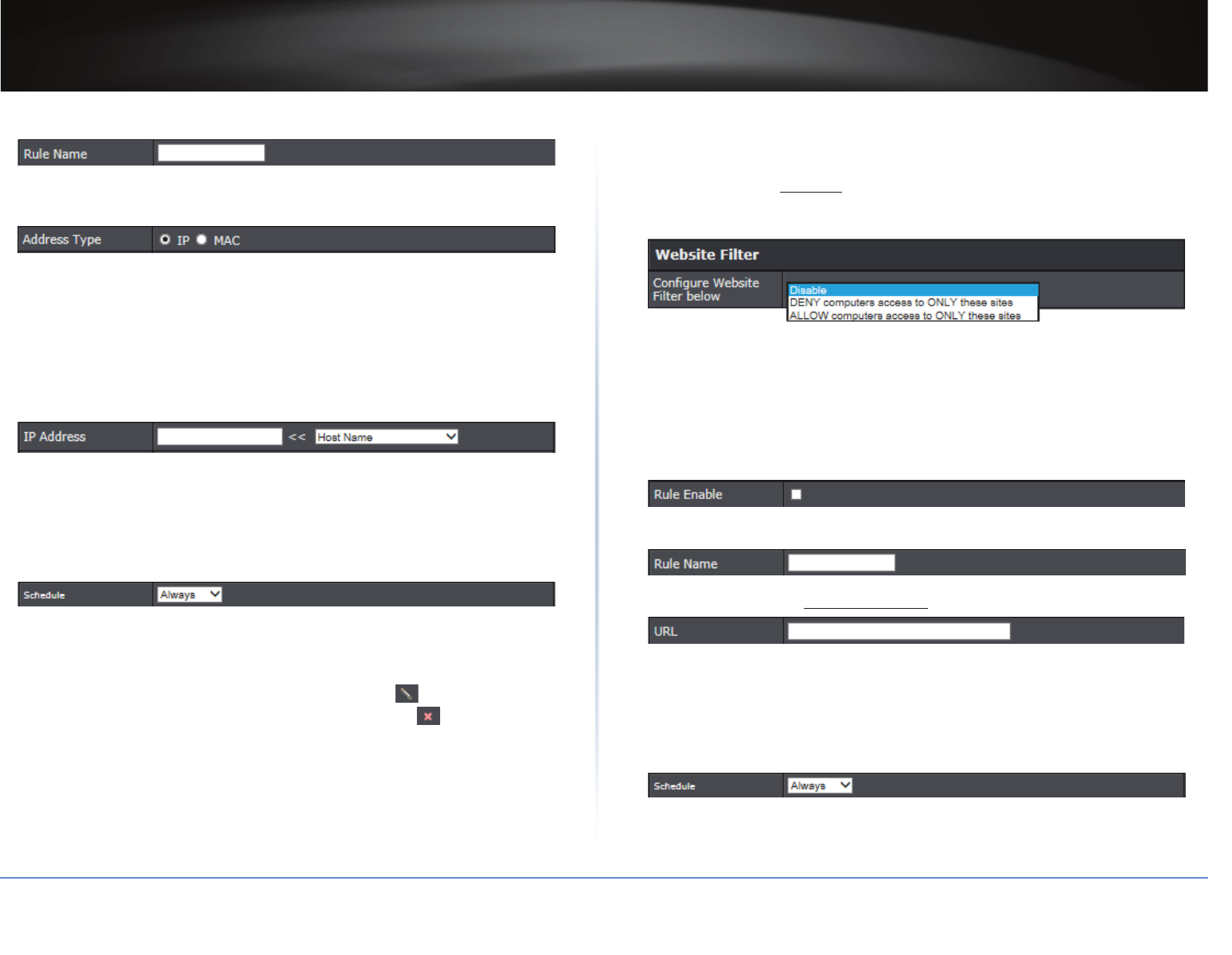
TRENDnet User’s Guide
TEW-823DRU
13
© Copyright 2014 TRENDnet. All Rights Reserved.
5 In Website Filter secon, congure the website lter.
Website Filter
You may want to block computers or devices on your network access to specic
websites (e.g. www.xxxxxxxxx.com, etc.), also called domains or URLs (Uniform
Resource Locators). You may also apply a schedule when these websites are allowed
or denied.
ͫDisable: Disables website ltering.
ͫDENY computers access to ONLY these sites: Only Deny computers/devices access to
the listed websites and allow access to others.
ͫALLOW computers access to ONLY these sites: Only Allow computers/devices access
to the listed websites and deny access to others.
6 Do the following to add a web pages URL lter rule.
ͫRule Enable: Check the checkbox to enable the access rule.
ͫRule Name: Enter the rule name.
ͫURL: Enter a URL (ex. www.xxxxxxxx.com) to apply for the lter or block.
ͫSchedule (Oponal): Select the pre-dened schedule to apply. The lter will only be
acve during the me period dened in the pre-dened schedule.
ÍNote: Before applying scheduling, please ensure your Time sengs are congured
correctly and you have dened a schedule. Please refer to “Set the Date and Time”
on page 42 and “Create Schedules” on page 30 to create a schedule.
7 Click Add to add the access rule to the Access Rule List. Wait of the rule to be added.
ͫRule Name: Enter the rule name.
ͫAddress Type: Select which Address Type to apply the lter. (MAC Address or IP
Address).
Note: If your device is not listed, please refer to your computer or device
documentaon to nd the MAC address.
ͫIP Address/MAC Address: Manually enter the MAC Address or IP Address in the
eld.
ÍNote: If the network device is connected to your router, you can also click the drop-
down list to choose one of the network devices (MAC Address/IP Address) detected
by your router.
ͫSchedule (Oponal): Click to select the pre-dened schedule to apply. The lter will
only be acve during the me period dened in the pre-dened schedule.
ÍNote: Before applying scheduling, please ensure your Time sengs are congured
correctly and you have dened a schedule. Please refer to “Set the Date and Time”
on page 42 and “Create Schedules” on page 30 to create a schedule.
4 Click Add to add the access rule to the Access Rule List. Wait of the rule to be added.
Note:
ͳClicking Reset will discard your sengs and clear all elds.
ͳIn the Access Rule List, you can edit a rule by clicking in the Edit column next
to the rule you would like to edit. To delete the rule, click in the Delete column
next to the rule you would like to delete.

TRENDnet User’s Guide
TEW-823DRU
14
© Copyright 2014 TRENDnet. All Rights Reserved.
Note:
ͳClicking Reset will discard your sengs and clear all elds.
ͳIn the URL Filter Rule List, you can edit a rule by clicking in the Edit column
next to the rule you would like to edit. To delete the rule, click in the Delete
column next to the rule you would like to delete.
Wireless Networking and Security
Tips to Improve Wireless Recepon
There are a number of factors that can impact the range of wireless devices. Follow these
ps to help improve your wireless connecvity:
• Keep the number of obstrucons to a minimum. Each obstrucon can reduce
the range of a wireless device. Posion the wireless devices in a manner that will
minimize the amount of obstrucons between them.
ͫFor the widest coverage area, install your router near the center of your home, and
near the ceiling, if possible.
ͫ Avoid placing the router on or near metal objects (such as le cabinets and metal
furniture), reecve surfaces (such as glass or mirrors), and masonry walls.
ͫ Any obstrucon can weaken the wireless signal (even non-metallic objects), so the
fewer obstrucons between the router and the wireless device, the beer.
ͫ Place the router in a locaon away from other electronics, motors, and uorescent
lighng.
ͫ Many environmental variables can aect the router’s performance, so if your wireless
signal is weak, place the router in several locaons and test the signal strength to
determine the ideal posion.
• Building materials can havea inuence on your wireless signal. In an indoor
environment, try to posion the wireless devices so that the signal passes through
less dense material such as dry wall. Dense materials like metal, solid wood, glass or
even furniture may block or degrade the signal.
• Antenna orientaon can have inuence on your wireless signal. Use the wireless
adapter’s site survey tool to determine the best antenna orientaon for your wireless
devices.
• Interference from devices that produce RF (radio frequency) noise can have inuence
on your signal. Posion your wireless devices away from anything that generates RF
noise, such as microwaves, radios and baby monitors.
If possible, upgrade wireless network interfaces (such as wireless cards in computers) from
older wireless standards to 802.11n or 802.11ac. If a wirelessly networked device uses an
older standard, the performance of the enre wireless network may be slower. If you are
sll experiencing low or no signal consider reposioning the wireless devices, installing
addional access points or wireless extenders.
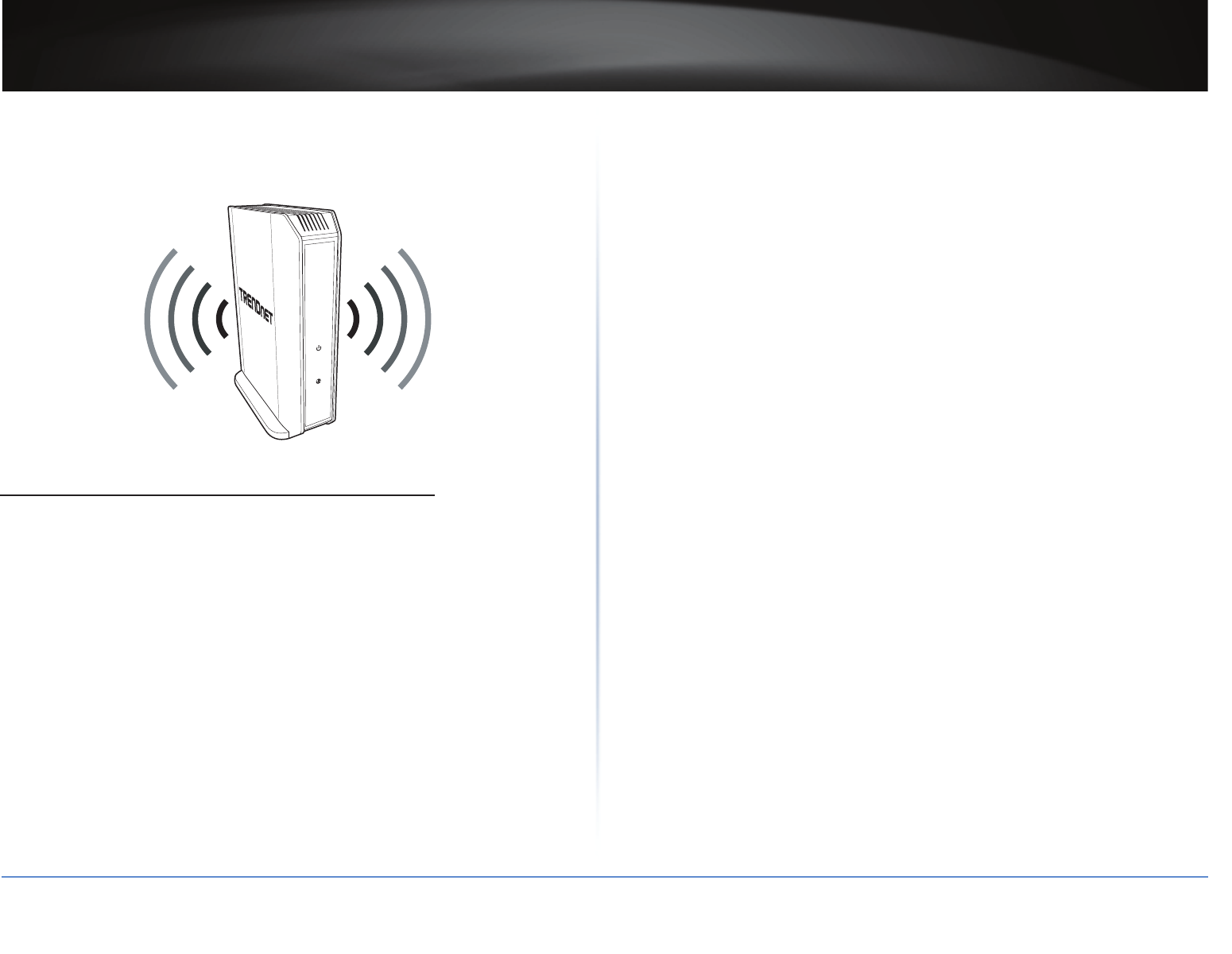
TRENDnet User’s Guide
TEW-823DRU
15
© Copyright 2014 TRENDnet. All Rights Reserved.
Device Orientaon
The antenna conguraon has been opmized for performance and connecvity when
wireless client devices are located on either side of the router compare to the front (LED
panel) or back (Ports).
Choose the Security Type for Wireless Network
Seng up wireless security is very important. Leaving your wireless network open and
insecure could expose your enre network and personal les to outsiders. TRENDnet
recommends reading through this enre secon and seng up wireless security on your
new router.
There are a few dierent wireless security types supported in wireless networking each
having its own characteriscs which may be more suitable for your wireless network taking
into consideraon compability, performance, as well as the security strength along with
using older wireless networking hardware (also called legacy hardware).
It is strongly recommended to enable wireless security to prevent unwanted users from
accessing your network and network resources (personal documents, media, etc.).
In general, it is recommended that you choose the security type with the highest strength
and performance supported by the wireless computers and devices in your network.
Please review the security types to determine which one you should use for your network.
Wireless Encrypon Types
• WEP: Legacy encrypon method supported by older 802.11b/g hardware. This is the
oldest and least secure type of wireless encrypon. It is generally not recommended
to use this encrypon standard, however if you have old 802.11 b or 802.11g wireless
adapters or computers with old embedded wireless cards(wireless clients), you may
have to set your router to WEP to allow the old adapters to connect to the router.
ÍNote: This encrypon standard will limit connecon speeds to 54Mbps.
• WPA: This encrypon is signicantly more robust than the WEP technology. Much of
the older 802.11g hardware was been upgraded (with rmware/driver upgrades) to
support this encrypon standard. Total wireless speeds under this encrypon type
however are limited to 54Mbps.
• WPA-Auto: This seng provides the router with the ability to detect wireless devices
using either WPA or WPA2 encrypon. Your wireless network will automacally
change the encrypon seng based on the rst wireless device connected. For
example, if the rst wireless client that connects to your wireless network uses WPA
encrypon your wireless network will use WPA encrypon. Only when all wireless
clients disconnect to the network and a wireless client with WPA2 encrypon
connects your wireless network will then change to WPA2 encrypon.
ÍNote: WPA2 encrypon supports 802.11n speeds and WPA encrypon will limit your
connecon speeds to 54Mbps.
• WPA2: This is the most secure wireless encrypon available today, similar to WPA
encrypon but more robust. This encrypon standard also supports the highest
connecon speeds. TRENDnet recommends seng your router to this encrypon
standard. If you nd that one of your wireless network devices does not support
WPA2 encrypon, then set your router to either WPA or WPA-Auto encrypon.
ÍNote: Check the specicaons of your wireless network adapters and wireless
appliances to verify the highest level of encrypon supported.
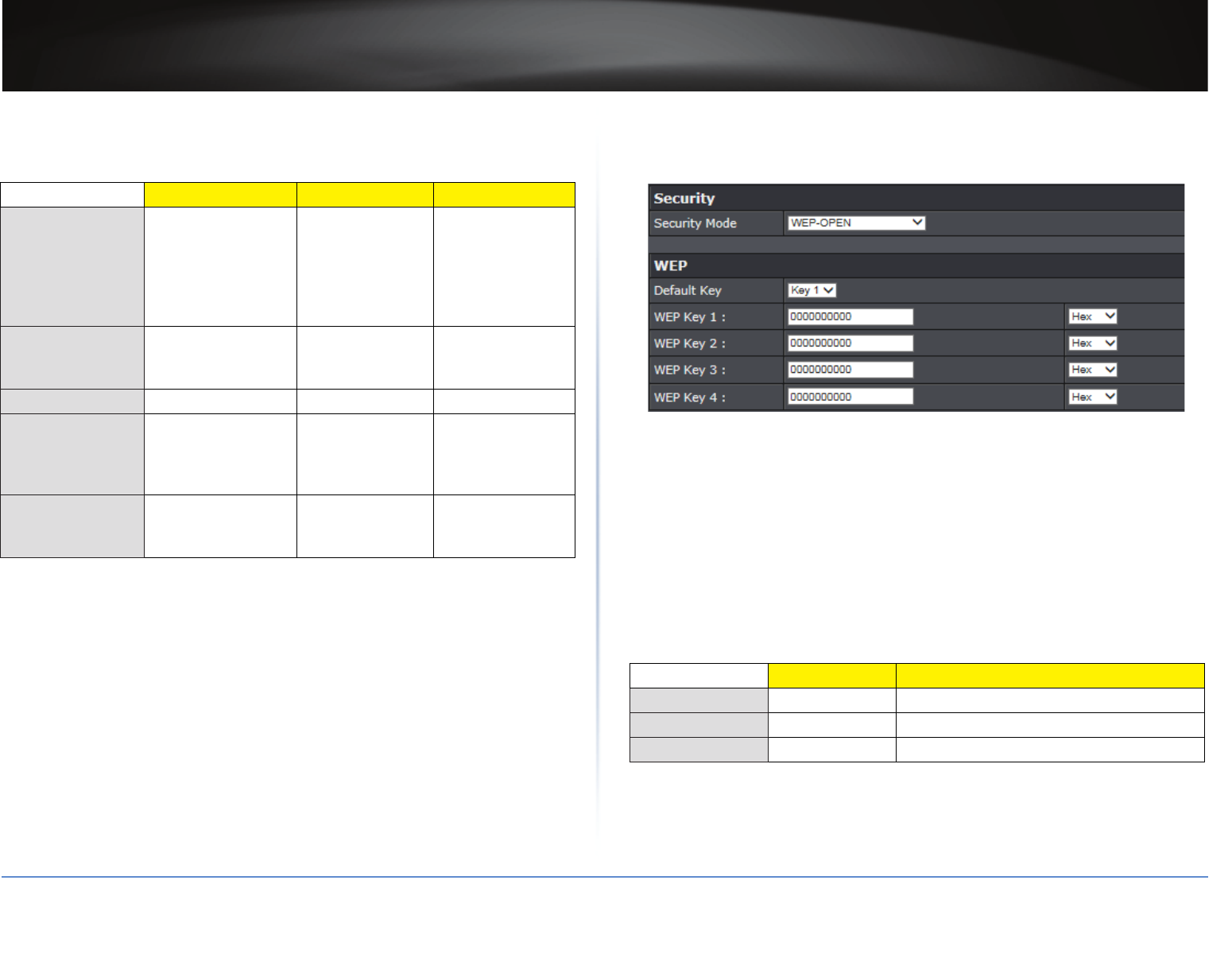
TRENDnet User’s Guide
TEW-823DRU
16
© Copyright 2014 TRENDnet. All Rights Reserved.
The following table is a brief comparison chart of the wireless security types and the
recommended conguraon depending on which type you choose for your wireless
network.
Security Standard WEP WPA WPA2
Compable
Wireless Standards
IEEE 802.11a/b/g
(802.11n devices will
operate at 802.11g
to connect using this
standard)
IEEE 802.11a/b/g
(802.11n devices
will operate
at 802.11g to
connect using this
standard)
IEEE 802.11a/b/
g/n/ac
Highest
Performance Under
This Seng
Up to 54Mbps Up to 54Mbps Up to 300Mbps
(11n) or 867Mbps
(11ac)
Encrypon Strength Low Medium High
Addional Opons Open System or
Shared Key,
HEX or ASCII,
Dierent key sizes
TKIP or AES,
Preshared Key or
RADIUS
TKIP or AES,
Preshared Key or
RADIUS
Recommended
Conguraon
Open System ASCII
13 characters
TKIP
Preshared Key
8-63 characters
AES
Preshared Key
8-63 characters
ÍNote: The compable wireless standard depends on the data rate supported by the
device:
• 802.11n: 150Mbps.
• 802.11ac: 433Mbps, 867Mbps.
Selecng WEP
If selecng WEP (Wired Equivalent Privacy), please review the WEP sengs to
congure and click Apply to save the changes.
ͫSecurity Mode: Choose WEP-OPEN, WEP-SHARED, or WEP-AUTO.
ÍNote: It is recommended to use Open because it is known to be more secure than
Shared Key.
ͫDefault Key: Enter the WEP key. This is the password or key that is used to connect
your computer to this router wirelessly. You can enter 64-bit or 128-bit key. You can
enter up to four keys but only the one chosen as the Default Key will be used.
ÍNote: It is recommended to use 128-bit because it is more secure to use a key that
consists of more characters.
ͫHex/ASCII: Enter the WEP key format. Refer to the table below for the acceptable
characters and lengths for each format.
WEP Key Format HEX ASCII
Character set 0-9 & A-F, a-f only Alphanumeric (a,b,C,?,*, /,1,2, etc.)
64-bit key length 10 characters 5 characters
128-bit key length 26 characters 13 characters
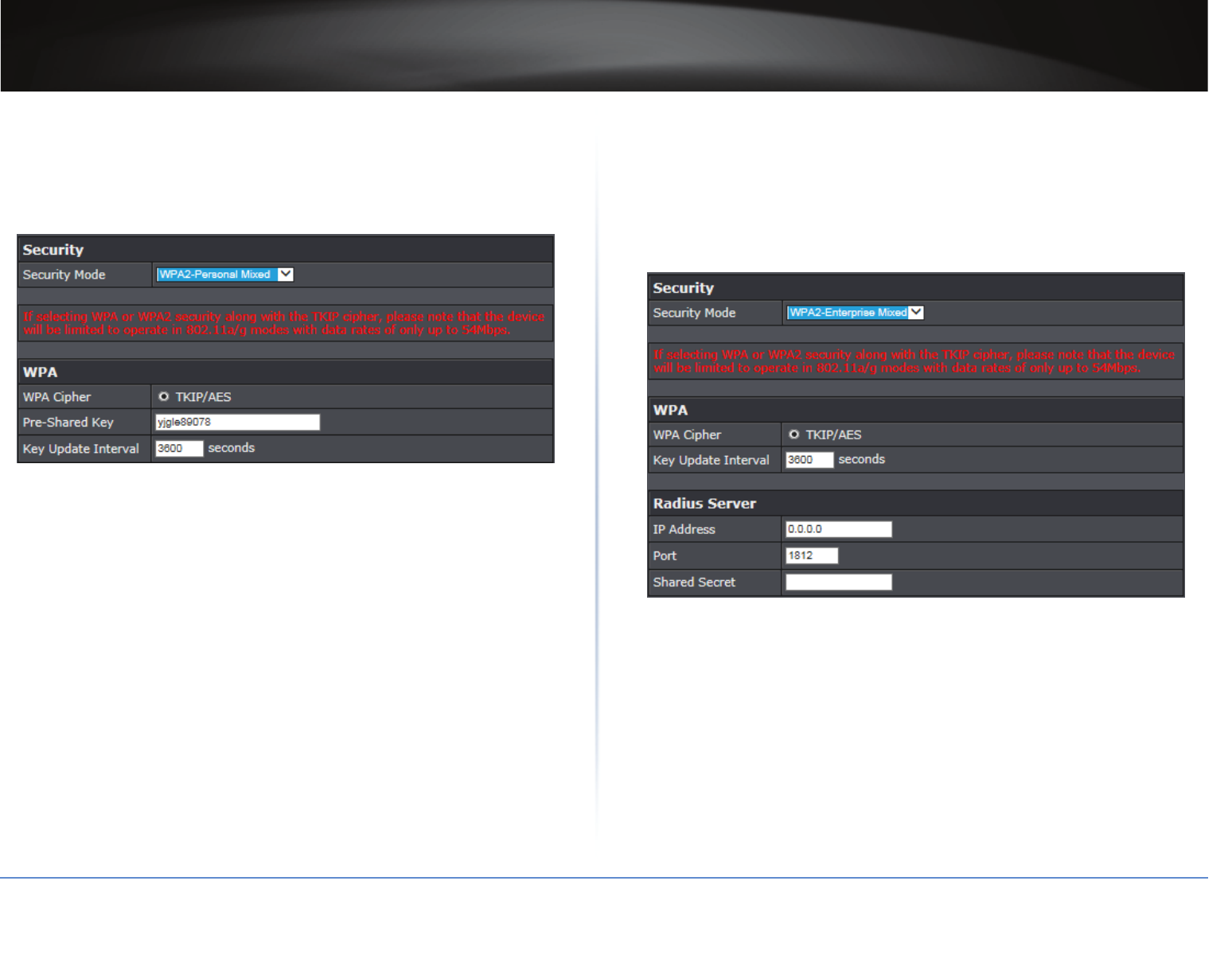
TRENDnet User’s Guide
TEW-823DRU
17
© Copyright 2014 TRENDnet. All Rights Reserved.
Selecng WPA-PSK / WPA2-PSK / WPA2-Personal Mixed
In the Security Mode drop-down list, select WPA-PSK, WPA2-PSK,or WPA2-Personal
Mixed. Please congure the sengs and click Apply to save the changes.
ÍNote: If selecng WPA or WPA2 security along with the TKIP cipher, the device will
be limited to operate in 802.11a/g modes with data rates up to 54Mbps.
The following secon outlines opons when selecng WPA-PSK, WPA2-PSK,or WPA2-
Personal Mixed,
ͫWPA Cipher: The available Cipher Type for WPA-PSK is TKIP and for WPA2-Personal
Mixed is TKIP/AES. For WPA2-PSK the default Cipher Type is AES but if you need the
backward-compability (so it would accept WPA connecons), choose TKIP/AES
ͫWPA Pre-Shared Key: Enter the passphrase.
ͳThis is the password or key that is used to connect your computer to this router
wirelessly.
Key Format: 8-63 alphanumeric characters (a,b,C,?,*, /,1,2, etc.).
ͫKey Update Interval: Enter the me interval (seconds) of when the network
passphrase will rotate.
ÍNote: It is recommended to use the default interval me. Your passphrase will not
change, rotaon of the key is part of the WPA protocol and designed to increase
security.
Selecng WPA / WPA2 / WPA2-Enterprise Mixed
In the Security Mode drop-down list, select WPA, WPA2, or WPA2-Enterprise Mixed.
Please congure the sengs and click Apply to save the changes.
ÍNote:
ͳIf selecng WPA or WPA2 security along with the TKIP cipher, the device will be
limited to operate in 802.11a/g modes with data rates up to 54Mbps.
ͳThis security type requires an external RADIUS server.
The following secon outlines opons when selecng WPA, WPA2, or WPA2-Enterprise
Mixed,
ͫWPA Cipher: The available Cipher Type for WPA is TKIP and for WPA2-Enterprise
Mixed is TKIP/AES. For WPA2 the default Cipher Type is AES but if you need the
backward-compability (so it would accept WPA connecons), choose TKIP/AES.
ͫKey Update Interval: Enter the me interval (seconds) of when the network
passphrase will rotate.
ÍNote: It is recommended to use the default interval me. Your passphrase will not
change, rotaon of the key is part of the WPA protocol and designed to increase
security.
ͫIP Address: Enter the IP address of the RADIUS server. For example, 192.168.10.250.
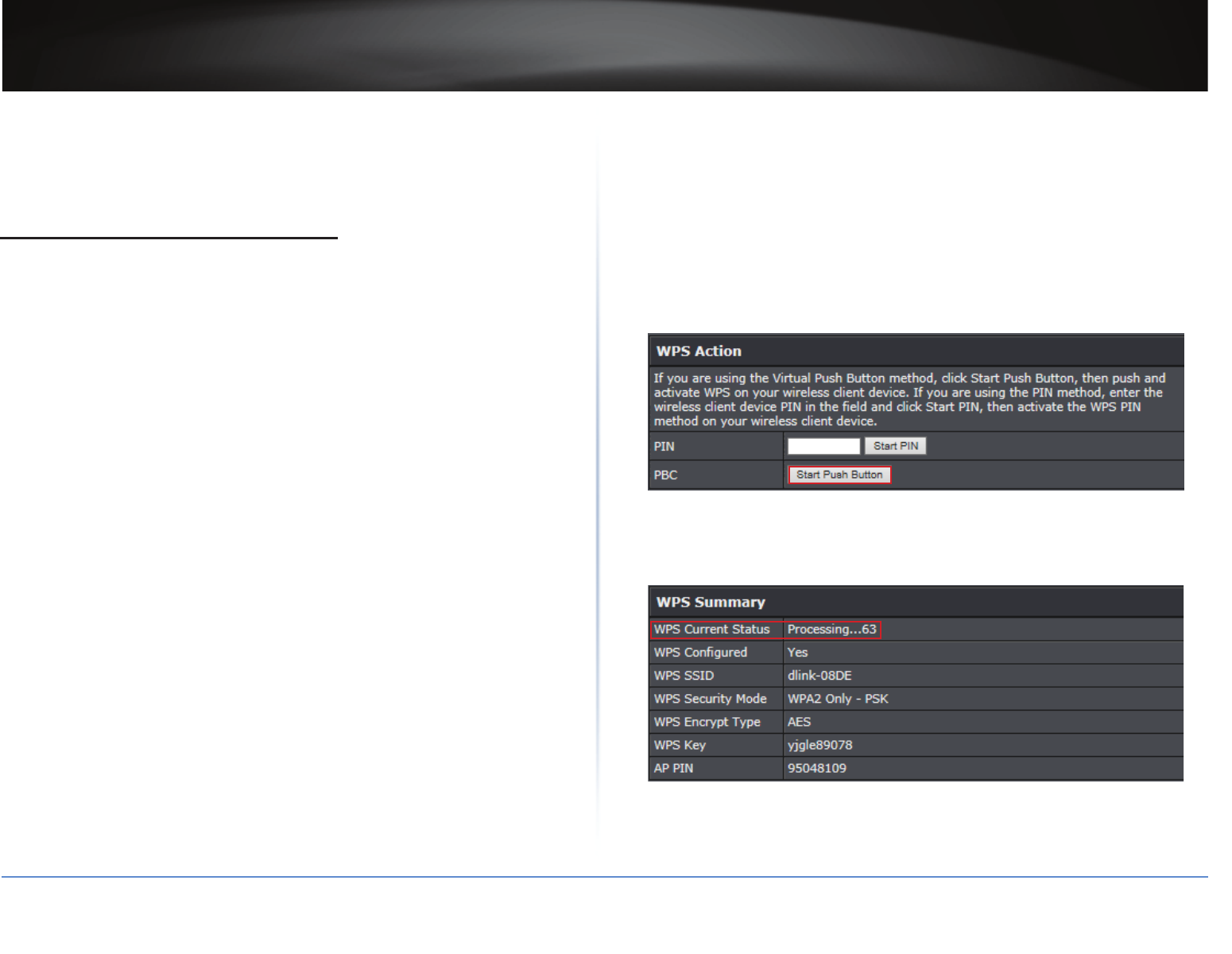
TRENDnet User’s Guide
TEW-823DRU
18
© Copyright 2014 TRENDnet. All Rights Reserved.
ͫPort: Enter the port your RADIUS server is congured to use for RADIUS authencaon.
ÍNote: It is recommended to use port 1812 which is the default RADIUS port.
ͫShared Secret: Enter the shared secret used to authorize your router with your
RADIUS server.
Connect Wireless Devices using WPS
WPS (Wi-Fi Protected Setup) is a feature that makes it easy to connect devices to your
wireless network. If your wireless devices support WPS, you can use this feature to easily
add wireless devices to your network.
ÍNote: You will not be able to use WPS if you set the SSID Broadcast seng to Disabled
or if you are using WEP security.
There are two methods the WPS feature can easily connect your wireless devices to your
network:
• Push Buon Conguraon (PBC) method:
ͳ Hardware Push Buon method–with an external buon located physically on
your router and on your client device (recommended).
ͳ WPS Soware/Virtual Push Buon - located on router management page.
• PIN (Personal Idencaon Number) Method - located on router management page.
ÍNote: Please refer to your wireless device documentaon for details on the operaon
of WPS.
Hardware Push Buon (PBC) Method (recommended)
It is recommended that a wireless key (passphrase or password) is created before
connecng clients using the PBC method. By default your router is precongured with a
wireless encrypon key. If no wireless key is dened when connecng via PBC, the router
will automacally create an encrypon key that is 64 characters long. This 64 character
key will then have to be used if one has to connect computers to the router using the
tradional connecon method.
To add a wireless device to your network, simply push the WPS buon on the wireless
device you are connecng (consult client device User’s Guide for length of me), then push
and hold the WPS buon located on your router for 3 seconds and release it. The WPS
LED will blink to indicate WPS has been acvated on your router. Please refer to “Product
Overview” on page 4.
For connecng addional WPS supported devices, repeat this process for each addional
device.
PBC (Soware/Virtual Push Buon)
Advanced > Wireless (2.4GHz or 5GHz) > WPS
In addion to the hardware push buon located physically on your router, the router
management page also has push buon which is a soware or virtual push buon you can
click to acvate WPS on your router.
1 Log into your router management page (refer to “Log in to Management Page” on page 8).
2 Click on Advanced > Wireless (2.4GHz or 5GHz) > WPS > WPS Acon.
3 To add a wireless device to your network, next to PBC, click the Start Push Buon buon.
Then push the WPS buon on the wireless device (consult wireless device’s User’s Guide
for length of me) you are connecng.
4 Wait for your router to nish the WPS process.
ÍNote: You should see a message on your WPS client device indicang the WPS was
successful.
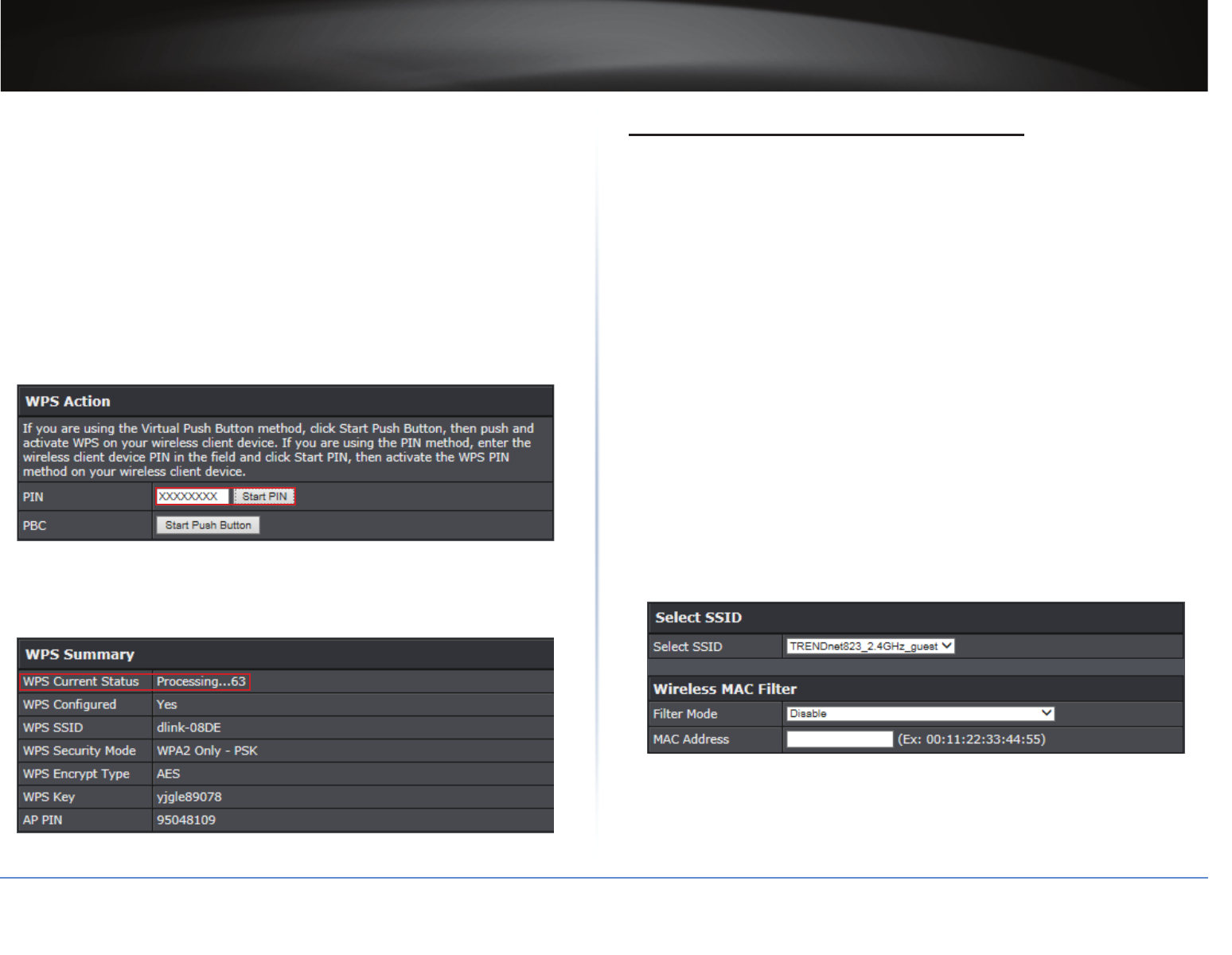
TRENDnet User’s Guide
TEW-823DRU
19
© Copyright 2014 TRENDnet. All Rights Reserved.
PIN (Personal Idencaon Number)
Advanced > Wireless (2.4GHz or 5GHz) > WPS
If your wireless device has WPS PIN (typically an 8-digit code printed on the wireless device
product label or located in the wireless device wireless soware ulity), you can use this
method.
1 Log into your router management page (refer to “Log in to Management Page” on page 8).
2 Click on Advanced > Wireless (2.4GHz or 5GHz) > WPS > WPS Acon.
3 To add a wireless device to your network, next to PIN, enter the 8-digit numeric PIN
number of the wireless client device and click Start PIN.
ÍNote: You may need to iniate the WPS PIN on your wireless device rst when
using this method. Please refer to your wireless device documentaon for details
on the operaon of WPS.
4 Wait for your router to nish the WPS process.
ÍNote: You should see a message on your WPS client device indicang the WPS was
successful.
Connect Wireless Devices Using MAC Filter
Advanced > Wireless (2.4GHz or 5GHz) > Security
This MAC lter is dedicated to lter on each band and each SSID. Every network device
has a unique, 12-digit MAC (Media Access Control) address. Every network device must
be assigned or congured with a specic IP address in order to communicate with your
network which is typically assigned by your router DHCP server automacally. Using access
rules, you can deny specic computers and other devices from using this router’s wired or
wireless network by specifying the MAC address or IP address.
1 Log into your router management page (refer to “Log in to Management Page” on page 8).
2 Click on Advanced > Wireless (2.4GHz or 5GHz) > Security > Wireless MAC Filter.
3 Review the MAC Filter opons. Click Apply to save changes.
Select SSID
ͫSelect SSID: If you have mulple SSIDs congured, click the drop-down list to select
which SSID to apply the MAC lter.
Wireless MAC Filter
ͫFilter Mode:
ͳDisabled: Disables MAC address lter.
ͳAllow (listed computes access and deny all others): Selecng this funcon allows
computers/devices with MAC addresses listed to access the local network (LAN/
WLAN), web management, and the Internet.
ͳDENY listed computes access and deny all others: Selecng this funcon denies
computers/devices with MAC addresses listed from access to the local network
(LAN/WLAN), web management, and the Internet.
ͫMAC Address: Enter the MAC address of the wireless device to apply to this lter.
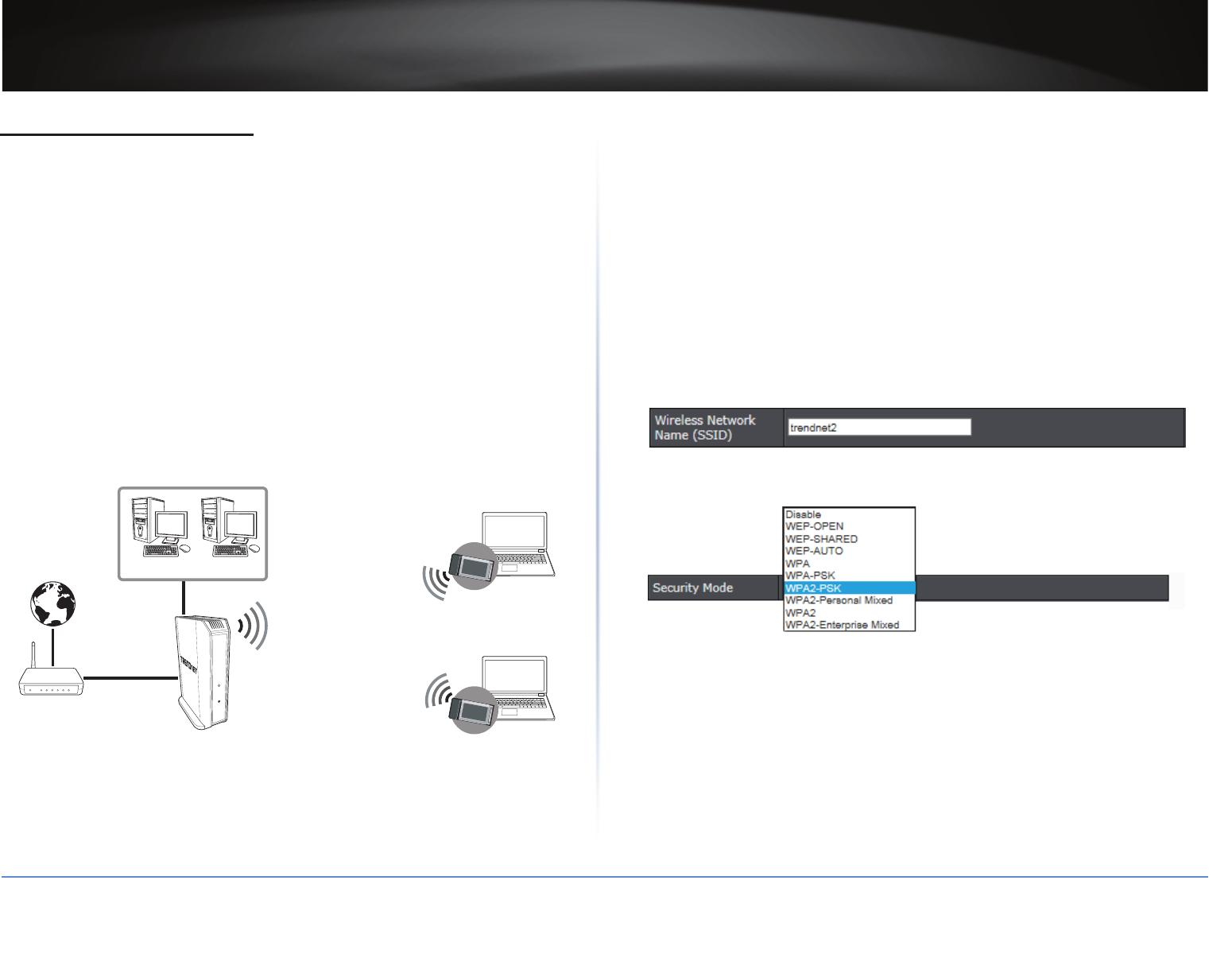
TRENDnet User’s Guide
TEW-823DRU
20
© Copyright 2014 TRENDnet. All Rights Reserved.
Advanced Wireless Sengs
The advanced wireless features provide can provide you with addional opons for seng
up your wireless network such as mulple SSID and WDS (Wireless Distribuon System) or
wireless bridging.
Mulple SSID Connecons
Advanced > Wireless (2.4GHz or 5GHz) > Security
The mulple SSID feature allows you to broadcast up to 2 SSIDs (or wireless network
names). When wireless devices are searching for available wireless networks to connect
to, the SSIDs (or wireless network names) will appear as separate and dierent wireless
networks. Since they appear as separate wireless networks, they are also referred to as
virtual APs (Access Points) since they appear as separate wireless access points but are
actually all being broadcasng and managed by a single wireless access point. Each virtual
AP can be congured each with a dierent SSID (or wireless network name), security type
and addional sengs for wireless devices to connect. You can use the mulple SSID
feature to setup guest wireless accounts with a dierent security type to keep your primary
wireless network security informaon private. The diagram shows an example of a client
connecng to SSID 1 and another client connecng to SSID 2.
LAN A
Client 1
Client 2
TEW-823DRU
Notebook with
Wireless N PC Card
Notebook with
Wireless N PC Card
Cable DSL
Modem
To congure mulple SSID on your router, do the following:
1 Log into your router management page (refer to “Log in to Management Page” on page 8).
2 Click on Advanced > Wireless (2.4GHz or 5GHz) > Mulple SSID.
3 In Mulple SSID1 or SSID2, congure the following parameters:
ͫRadio On/O: Check the checkbox to enable the addional SSID.
ͳNew Schedule: The schedule funcon allows you to dene a schedule when
the addional SSID should be turned on. To dene a new schedule, click New
Schedule and refer to “Create Schedules” on page 30. Aer you have created
a new schedule, click the drop-down list and the new schedule will be available
for selecon.
ÍNote: Before applying scheduling, please ensure your Time sengs are congured
correctly and you have dened a schedule. Please refer to “Set the Date and Time”
on page 42 and “Create Schedules” on page 30 to create a schedule.
ͫWireless Network Name (SSID): Enter the wireless name (SSID) for addional SSID.
4 In Security secon, click Security Mode drop-down list to apply a dierent wireless
security type and key to the guest network.
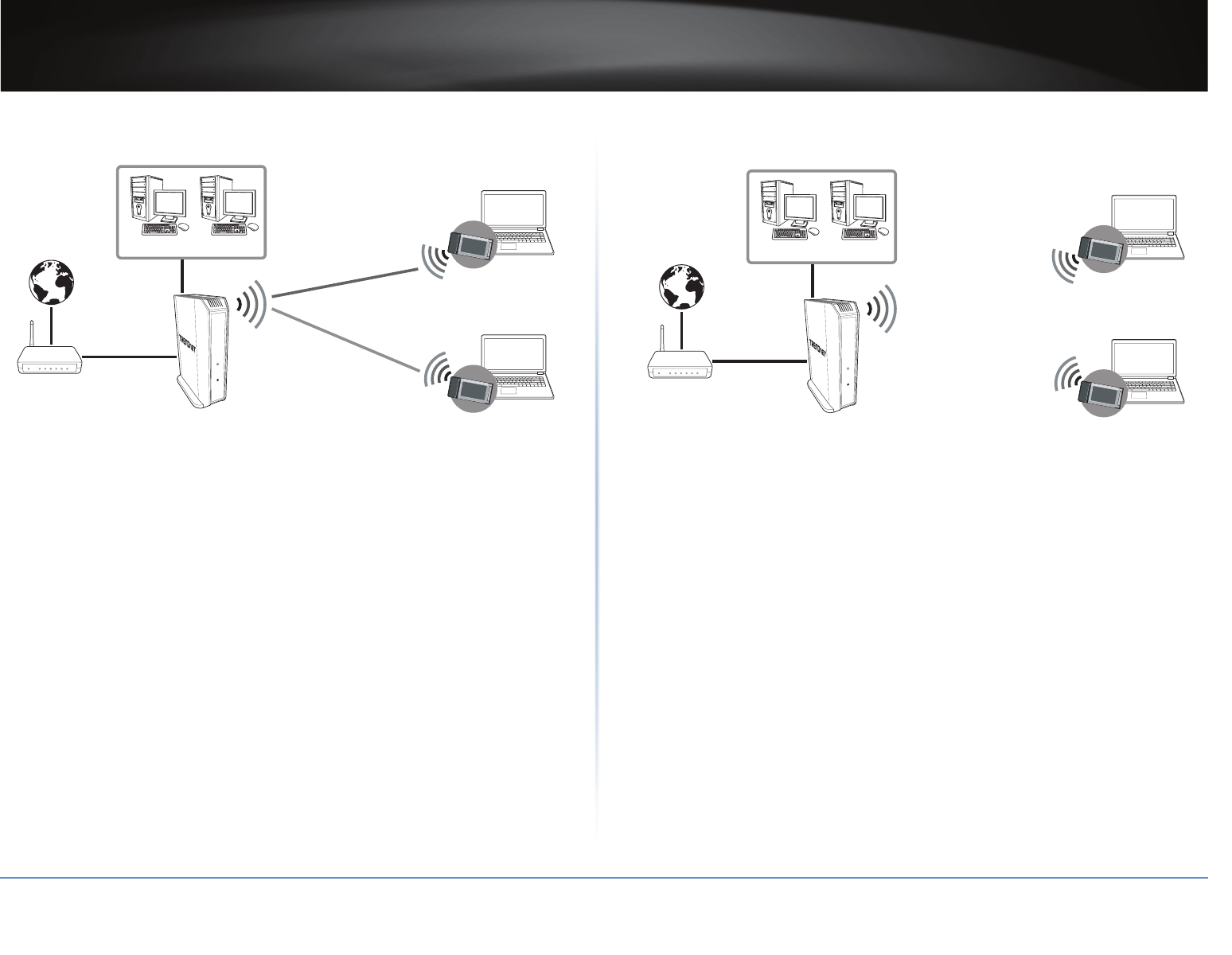
TRENDnet User’s Guide
TEW-823DRU
21
© Copyright 2014 TRENDnet. All Rights Reserved.
The following diagram shows an example of a client connecng to SSID 1 and another
client connecng to SSID 2.
LAN A
Client 1
Client 2
TEW-823DRU
Notebook with
Wireless N PC Card
Notebook with
Wireless N PC Card
Cable DSL
Modem
SSID 1: trendnet1
SSID 2: trendnet2
5 Click Apply to save the changes.
ÍNote: To discard the changes, click Cancel.
Wireless Bridging Using WDS
Advanced > Wireless (2.4GHz or 5GHz) > WDS
Wireless bridging using WDS allows the device to create a wireless bridge with other WDS
supported wireless routers and access points congured in WDS mode to bridge groups of
network devices together wirelessly. Simultaneously, the router will also funcon in access
point mode allowing wireless client devices such as computers, game consoles, mobile
phones, etc. to connect in order to access network resources from mulple groups of
network devices as well as the Internet.
ÍNote: You can create up to four WDS bridge connecons on each wireless band (2.4GHz
and 5GHz). WDS (Wireless Distribuon System) is not currently standardized and may
not connect to dierent model wireless routers or access points, therefore, when using
WDS, it is recommended to use the same model and version for wireless bridging.
By default, your router funcons in Access Point mode to allow wireless client devices to
connect and access your network resources and access the Internet.
The diagram below shows your router in Access Point mode and clients connecng to your
router.
LAN A
Client 1
Client 2
TEW-823DRU
Notebook with
Wireless N PC Card
Notebook with
Wireless N PC Card
Cable DSL
Modem
ÍNote: Before conguring WDS, please ensure the following rst:
ͳMake sure dierent IP addresses are assigned to each WDS supported device used
for bridging to avoid IP address conict. For example, 192.168.10.1; 192.168.10.2;
192.168.10.3. Refer to “Change the IP Address” on page 25 for changing the LAN
IP address.
ͳIf you are using more than one WDS supported router, ensure the LAN DHCP server
is enabled on only one router and disabled on all the others to avoid IP address
conict. Refer to “Congure the DHCP Server” on page 26 for DHCP server opons.
ͳCongure the same wireless channel and use the same on all WDS supported
wireless devices. Refer to “Wireless Sengs” on page 10 for conguring basic
wireless sengs.
ͳCongure the same wireless security and key on all WDS supported devices. Refer to
“Wireless Sengs” on page 11 for conguring wireless security sengs.
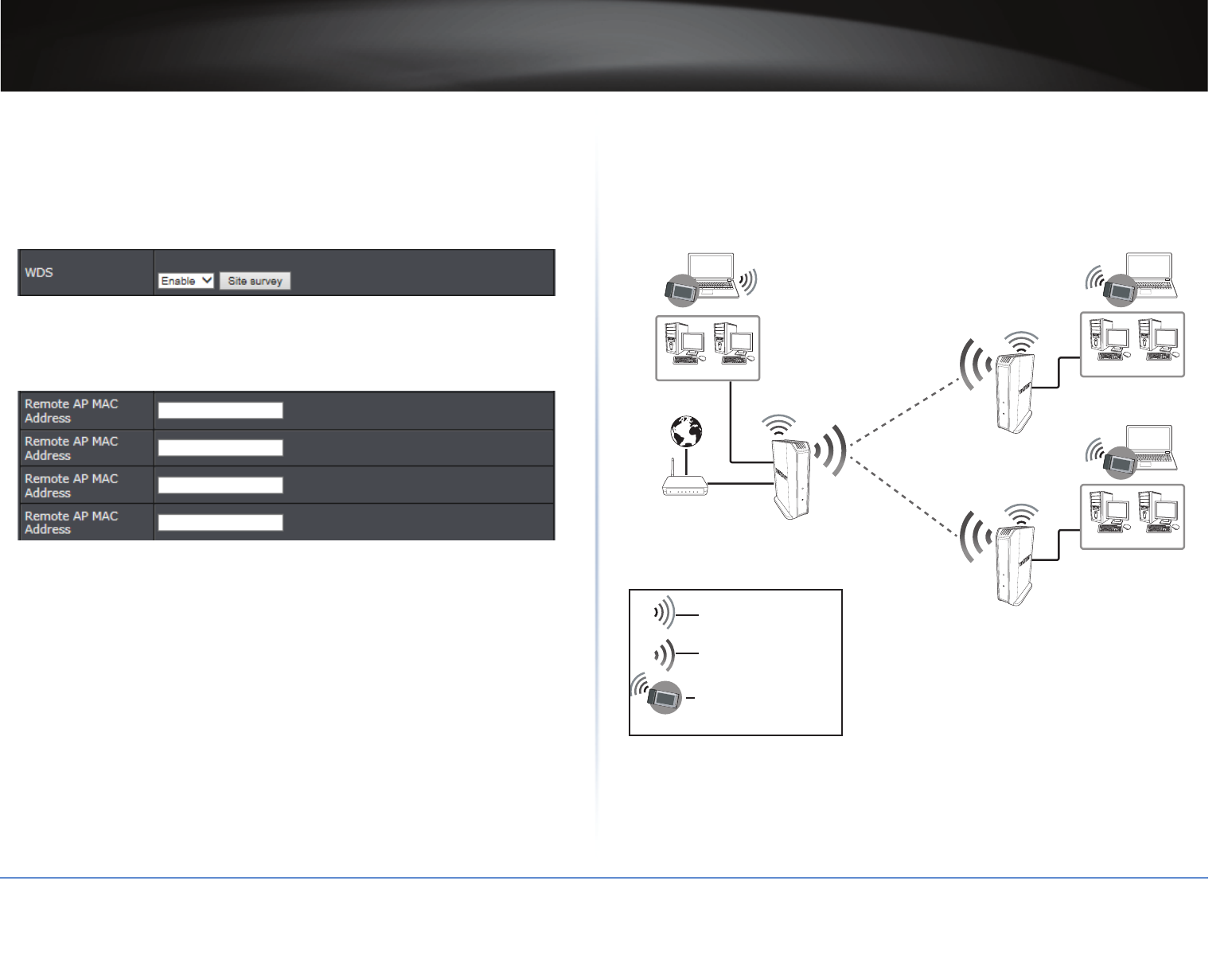
TRENDnet User’s Guide
TEW-823DRU
22
© Copyright 2014 TRENDnet. All Rights Reserved.
To congure WDS bridging between TEW-823DRU routers, do the following:
1 Log into your router management page (refer to “Log in to Management Page” on page 8).
2 Click on Advanced > Wireless (2.4GHz or 5GHz) > WDS.
3 Click on the WDS drop-down list and select Enable.
IMPORTANT: Ensure the basic wireless security (Basic > Wireless > Security) on router is set
to WEP or Disabled mode. WDS cannot funcon in WPA or WPA2 mode.
ÍNote: Click Site survey to search for Access Point’s MAC address to connect.
4 Enter the MAC address of the other WDS supported wireless device you are bridging. For
example, 00:11:22:AA:BB:CC.
5 Click Apply to save the changes.
ÍNote: To discard the changes, click Cancel.
For addional routers, make sure to disable the DHCP server rst on all addional routers
and congure the LAN IP address to be dierent on each router. You will connect devices to
the LAN ports 1-4 only on all addional routers and the WAN port is not used. Then, repeat
the steps for addional routers you are bridging.
The following illustraon shows the access point with WDS enabled connecon diagram.
Access point mode
connecon
Wireless bridged
connecon
Client 1 (AP2)
Client 1 (AP3)
Client 1 (AP1)
WDS Bridge 1
WDS Bridge 2
Cable DSL
Modem
LAN A LAN A
AP1
AP2
AP3
TEW-823DRU
TEW-823DRU
TEW-823DRU
(LAN DHCP Server Disabled)
(IP Address: 192.168.10.1)
(LAN DHCP Server Disabled)
(IP Address: 192.168.10.3)
LAN A
Network with Wireless
N PC Card
(LAN DHCP Server Disabled)
(IP Address: 192.168.10.2)
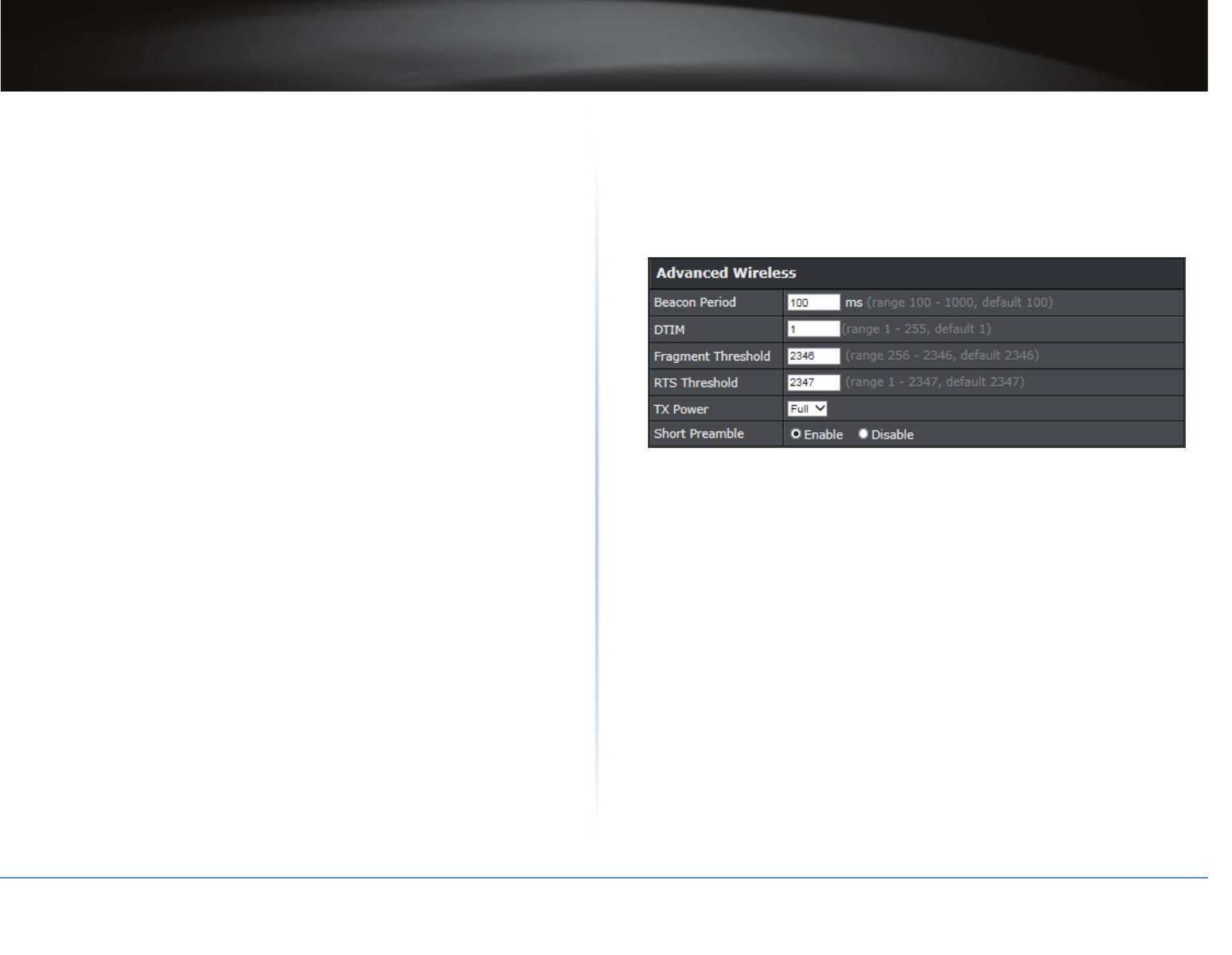
TRENDnet User’s Guide
TEW-823DRU
23
© Copyright 2014 TRENDnet. All Rights Reserved.
Advanced Sengs
Advanced > Wireless (2.4GHz or 5GHz) > Advanced
These sengs are advanced opons that can be congured to change advanced wireless
broadcast specicaons. It is recommended that these sengs remain set to their default
values unless you are knowledgeable about the eects of changing these values. Changing
these sengs incorrectly can degrade performance.
1 Log into your router management page (refer to “Log in to Management Page” on page 8).
2 Click on Advanced > Wireless (2.4GHz or 5GHz) > Advanced.
3 In Advanced Wireless secon, congure the following parameters:
ͫBeacon Period: A beacon is a management frame used in wireless networks that
transmied periodically to announce the presence and provide informaon on the
router’s wireless network. The interval is the amount me between each beacon
transmission.
Default Value: 100 milliseconds (range: 100-1000)
ͫDTIM: A DTIM is a countdown informing clients of the next window for listening to
broadcast and mulcast messages. When the wireless router has buered broadcast
or mulcast messages for associated clients, it sends the next DTIM with a DTIM
Interval value. Wireless clients detect the beacons and awaken to receive the
broadcast and mulcast messages. The default value is 1. Valid sengs are between
1 and 255.
ͫFragment Threshold: Wireless frames can be divided into smaller units (fragments)
to improve performance in the presence of RF interference and at the limits of RF
coverage. Fragmentaon will occur when frame size in bytes is greater than the
Fragmentaon Threshold. This seng should remain at its default value of 2346
bytes. Seng the Fragmentaon value too low may result in poor performance.
ͫRTS Threshold: The Request To Send (RTS) funcon is part of the networking protocol.
A wireless device that needs to send data will send a RTS before sending the data in
queson. The desnaon wireless device will send a response called Clear to Send
(CTS). The RTS Threshold denes the smallest data packet size allowed to iniate the
RTS/CTS funcon.
Default Value: 2347 (range: 1-2347).
ͫTX Power: This seng allows you to adjust the wireless transmit power to a lower
seng. In busy wireless environments, lowering the transmit power may improve
beer performance and connecvity and decrease interference with neighbouring
wireless networks.
ͫShort Preamble: Using a short preamble can potenally increase throughput as the
transfer me is 96 microseconds versus the more commonly used long preamble
192 microseconds. However, using a short preamble is not supported using 802.11b
legacy devices, in some cases cause wireless interoperability issues, and increase
the error rate in some installaons. The preamble is the informaon sent from the
wireless transmier to the receiver indicang when data is incoming.
4 In HT Physical Mode secon, congure the following parameters:
ͫ20/40 Coexistence (2.4GHz only): 20/40MHz Coexistence allows for the auto-fallback
from 40MHz to 20MHz channel width operaon when neighbouring 802.11 wireless
networks are detected.
ͫGuard Interval: Using a short (400ns) guard interval can increase throughput.
However, it can also increase error rate in some installaons, due to increased
sensivity to radio-frequency reecons.
ͫMCS: Allows you to lock down the wireless transmission rate.
ͫExtension channel: Allows you to assign either the upper or lower extension channels
to use for channel bonding when establishing connecvity at the higher channel
widths 40MHz and 80MHz.
ͫA-MPDU: Using Aggregate Mulple Protocol Data Unit will allow the all frames
transmied to be aggregated into larger size A-MPDU formaed frames before
sending and receiving potenally increasing the overall throughput.
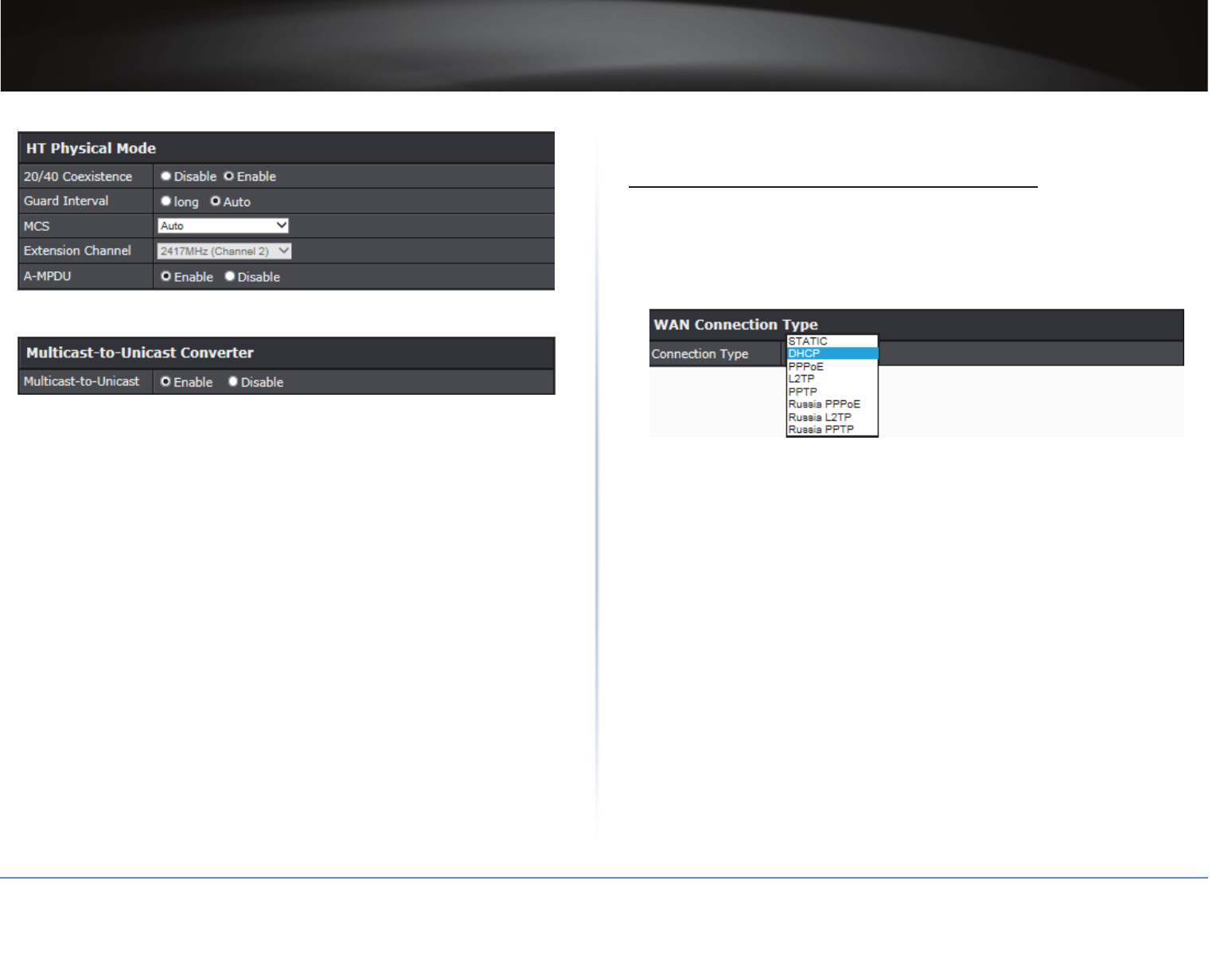
TRENDnet User’s Guide
TEW-823DRU
24
© Copyright 2014 TRENDnet. All Rights Reserved.
5 Next to Mulcast-to-Unicast Converter, select the opon to enable or disable.
6 Click Apply to save the changes.
ÍNote: To discard the changes, click Cancel.
Advanced Router Sengs
Congure Manually the Internet Connecon
Advanced > Setup > WANSengs
1 Log into your router management page (refer to “Log in to Management Page” on page 8).
2 Click on Advanced > Setup > WAN Sengs.
3 In WAN Connecon Type secon, click the drop-down list and select the type of Internet
connecon.
4 Enter the necessary network parameters.
5 Click Apply to save the changes.
ÍNote: If you are not sure which Internet connecon type you are using, please
contact your local Internet Service Provider (ISP).
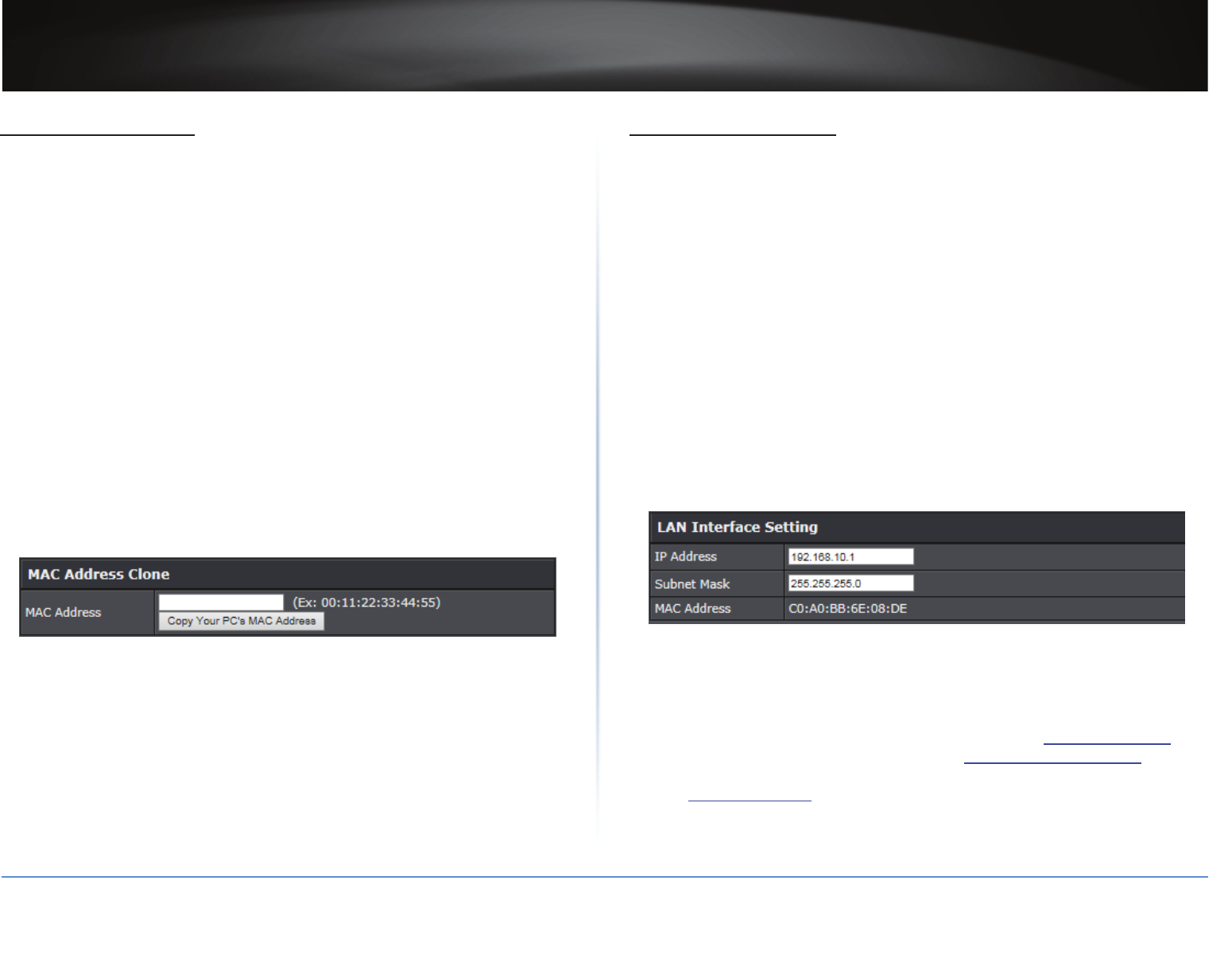
TRENDnet User’s Guide
TEW-823DRU
25
© Copyright 2014 TRENDnet. All Rights Reserved.
Clone a MAC address
Advanced > Setup > WANSengs
On any home network, each network device has a unique MAC (Media Access Control)
address. Some ISPs register the MAC address of the device (usually a router or a computer)
connected directly to the modem. If your computer MAC address is already registered
with your ISP and to prevent the re-provisioning and registraon process of a new MAC
address with your ISP, then you can clone the address (assign the registered MAC address
of your previous device to your new router). If you want to use the MAC address from the
previous device (computer or old router that directly connected to the modem, you should
rst determine the MAC address of the device or computer and manually enter it into your
router using the clone MAC address feature.
ÍNote: For many ISPs that provide dynamic IP address automacally, typically, the
stored MAC address in the modem is reset each me you restart the modem. To clear
your modem stored MAC address, typically the procedure is to disconnect power from
the modem for approximately for one minute, then reconnect the power. For more
details on this procedure, refer to your modem’s User Guide/Manual or contact your
ISP.
1 Log into your router management page (refer to “Log in to Management Page” on page 8).
2 Click on Advanced > Setup > WAN Sengs.
3 In MAX Address Clone secon, click Copy Your PC’s MAC Address to copy your computer’s
MAC address in the MAC Address eld.
4 Click Apply to save the changes.
ÍNote: To discard the changes, click Cancel.
Change the IP Address
Advanced > Setup > LANSengs
Usually, you do not need to change your router IP address sengs. Typically, the router IP
address sengs only need to be changed, if you plan to use another router in your network
with the same IP address sengs, if you are connecng your router to an exisng network
that is already using the IP address sengs your router is using, or if you are experiencing
problems establishing VPN connecons to your oce network through your router.
ÍNote: It is recommended to keep your router IP address sengs as default.
ͳDefault Router IP Address: 192.168.10.1
ͳDefault Router Network Address: 192.168.10.0 / 255.255.255.0
1 Log into your router management page (refer to “Log in to Management Page” on page 8).
2 Click on Advanced > Setup > LAN Sengs.
3 In LAN Interface Sengs secon, modify the following sengs:
ͫIP Address: Enter the new router IP address. For example, 192.168.200.1.
ͫSubnet Mask: Enter the new router subnet mask. For example, 255.255.255.0.
ÍNote: The DHCP address range will change automacally to your new router IP
address sengs, so you do not have to change the DHCP address range manually
to match your new router IP address sengs.
4 Click Apply to save the changes.
ÍNote:
ͳTo discard the changes, click Cancel.
ͳYou will need to access your router management page using your new router
IP address. For example, instead of using the default hp://192.168.10.0 your
new router IP address will use the format hp://(new.ipaddress.here) to access
the router management page. You can also connue using the default login URL
hp://tew-823DRU.
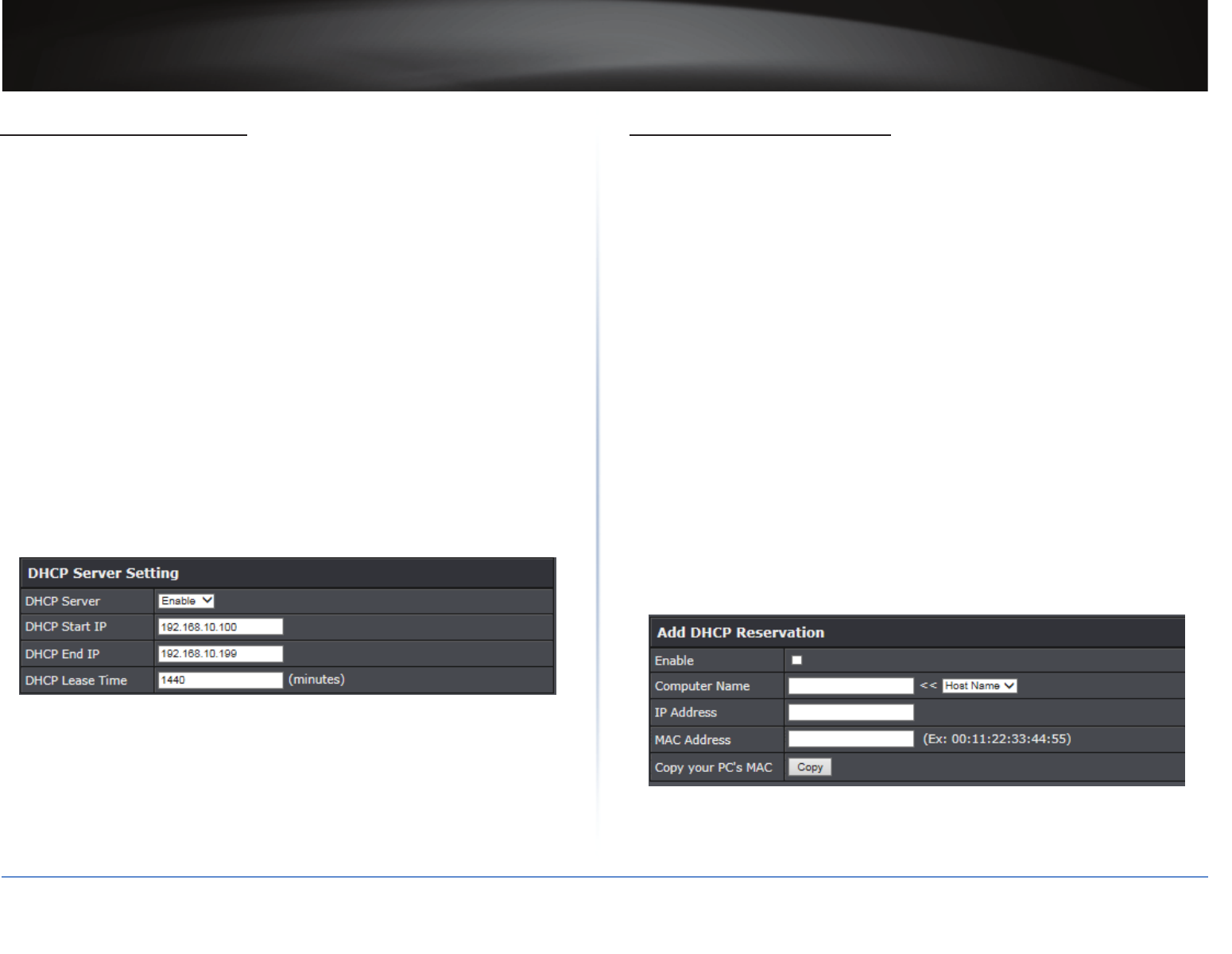
TRENDnet User’s Guide
TEW-823DRU
26
© Copyright 2014 TRENDnet. All Rights Reserved.
Congure the DHCP Server
Advanced > Setup > LANSengs
Your router can be used as a DHCP (Dynamic Host Conguraon Protocol) server to
automacally assign an IP address to each computer or device on your network. The DHCP
server is enabled by default on your router. If you already have a DHCP server on your
network, or if you do not want to use your router as a DHCP server, you can disable this
seng. It is recommended to leave this seng enabled.
1 Log into your router management page (refer to “Log in to Management Page” on page 8).
2 Click on Advanced > Setup > LAN Sengs.
3 In DHCP Server Sengs secon, review and modify the following sengs:
ͫDHCP Server: Enable or disable the DHCP server.
ͫDHCP Start IP: Change the starng address for the DHCP server range. For example,
192.168.10.20.
ͫDHCP End IP: Change the ending address for the DHCP server range. For example,
192.168.10.30.
ͫDHCP Lease Time: Enter the DHCP lease me in minutes.
ÍNote: The DHCP lease me is the amount of me a computer or device can
keep an IP address or assigned by the DHCP server. When the lease me
expires, the computer or device will renew the IP address lease with the DHCP
server, otherwise if there is no aempt to renew the lease, the DHCP server will
reallocate the IP address to be assigned to another computer or device.
4 Click Apply to save the changes.
ÍNote: To discard the changes, click Cancel.
Congure DHCP Reservaon
Advanced > Setup > LANSengs
DHCP (Dynamic Host Conguraon Protocol) reservaon (also called Stac DHCP) allows
your router to assign a xed IP address from the DHCP server IP address range to a specic
device on your network. Assigning a xed IP address can allow you to easily keep track of
the IP addresses used on your network by your computers or devices for future reference
or conguraon such as virtual server (also called port forwarding, refer to “Virtual
Server” on page 33) or special applicaons (also called port triggering, refer to “Special
Applicaons” on page 34).
1 Log into your router management page (refer to “Log in to Management Page” on page 8).
2 Click on Advanced > Setup > LAN Sengs.
3 In Add DHCP Reservaon secon, do the following:
ͫEnable: Enable or Disable the DHCP reservaon.
ͫComputer Name: Enter a name of the device you will assign the DHCP reservaon.
ÍNote: Next to the Computer Name eld, you can click the Host Name drop-down
list to select an available computer from the DHCP server lisng. Click on the
available computer to copy the computer’s name/IP address, and MAC address
informaon into the respecve elds.
ͫIP Address: Enter the IP address to assign to the reservaon. For example,
192.168.10.101.
ͫMAC Address: Enter the MAC (Media Access Control) address of the computer or
network device to assign to the reservaon. For example, 00:11:22:AA:BB:CC.
ͫCopy your PC’s MAC: To copy your current computer’s MAC address to the eld, click
Copy.
4 Click Add to save the reservaon.
ÍNote: To discard the changes, click Clear.
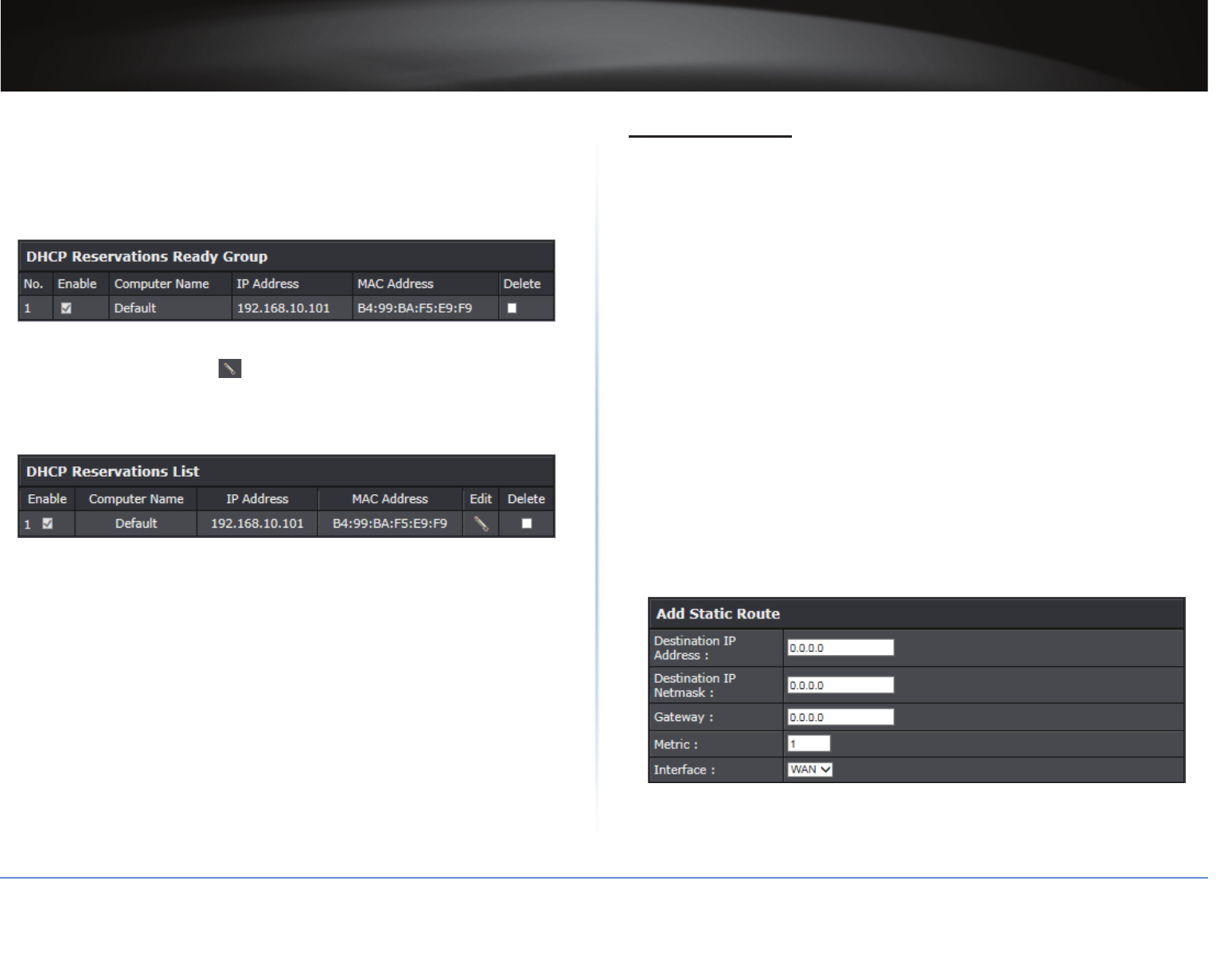
TRENDnet User’s Guide
TEW-823DRU
27
© Copyright 2014 TRENDnet. All Rights Reserved.
You will see the new reservaon added to the DHCP Reservaons Ready Group secon.
This is a temporary list unl you save changes by clicking Apply. You can connue to add
more DHCP reservaon entries which will appear in this list. Once you have saved the
sengs, the entries will appear under the DHCP Reservaons list. You can click Reset to
clear the entries in the list or check the Delete opon, next to the entry to remove and
click Delete.
5 In DHCP Reservaon List secon, do any of the following:
ͫ To edit the reservaon, click .
ͫ To delete the single reservaon, check the Delete checkbox.
ͫ To delete all the reservaons, click Delete All.
ÍNote: To discard the changes, click Clear.
Add Stac Routes
Advanced > Setup > Roung
You may want set up your router to route computers or devices on your network to other
local networks through other routers. Generally, dierent networks can be determined by
the IP addressing assigned to those networks. Generally speaking and for the case of an
example, your network may have 192.168.10.x IP addressing and another network may
have 192.168.20.x IP addressing and because the IP addressing of these two networks are
dierent, they are separate networks. In order to communicate between the two separate
networks, stac roung needs to be congured.
ÍNote: Conguring this feature assumes that you have some general networking
knowledge.
1 Log into your router management page (refer to “Log in to Management Page” on page 8).
2 Click on Advanced > Setup > Roung.
3 In Add Stac Route secon, modify the following sengs:
ͫDesnaon IP Address: Enter the IP network address of the desnaon network for
the route. For example, 192.168.20.0.
ͫDesnaon IP Netmask: Enter the subnet mask of the desnaon network for the
route. For example, 255.255.255.0.
ͫGateway: Enter the gateway to the desnaon network for the route. For example,
192.168.10.2.
ͫMetric: Enter the metric or priority of the route. The metric range is 1-15, the lowest
number 1 being the highest priority. For example, 1.
ͫInterface: Select the interface to assign the route.
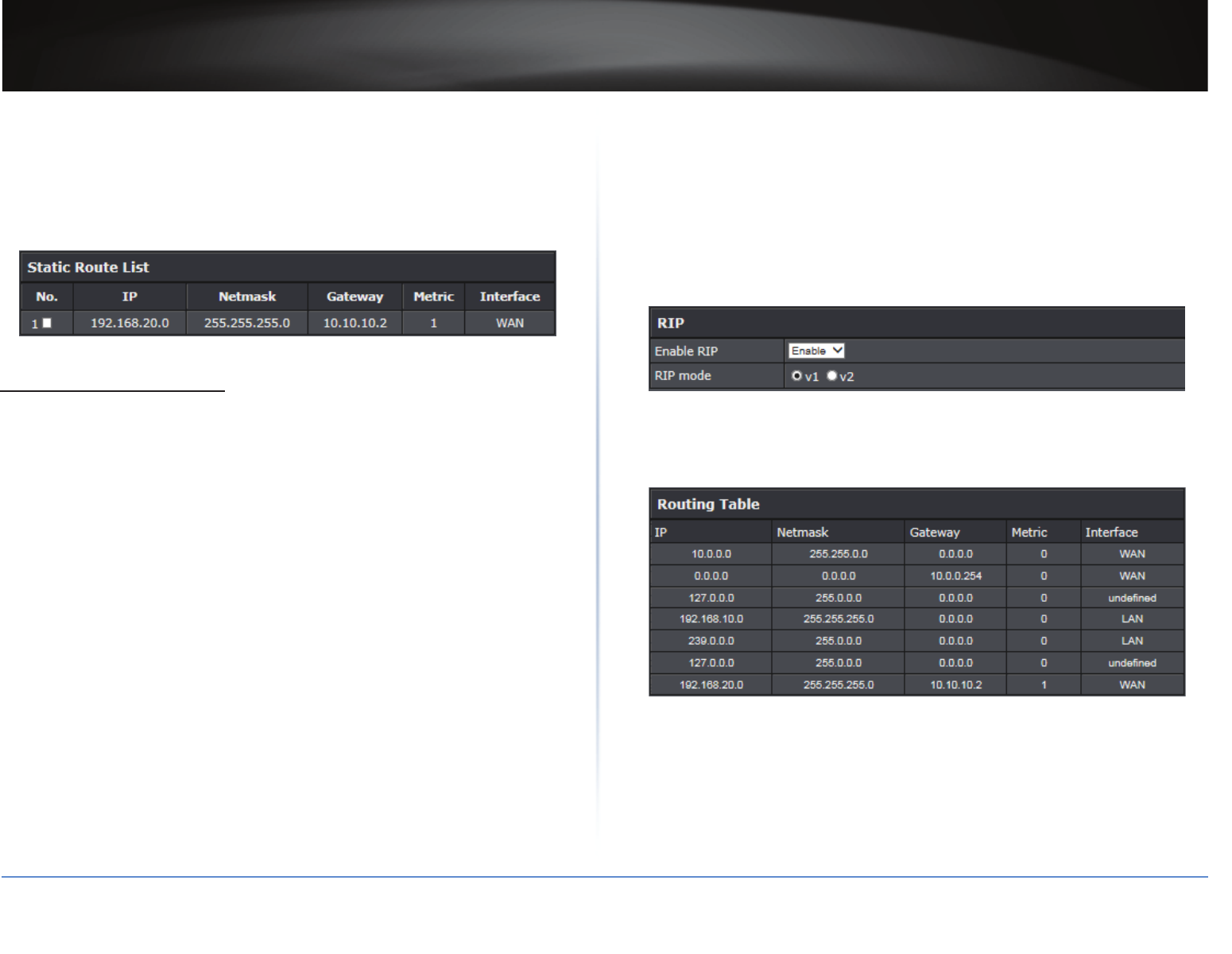
TRENDnet User’s Guide
TEW-823DRU
28
© Copyright 2014 TRENDnet. All Rights Reserved.
4 Click Add to add the stac route. The stac route informaon appears on the Stac
Route List secon.
ÍNote: To discard the changes, click Cancel.
Delete a Route
To delete a route, check the box in the No. column to select which routes to delete, then
click Delete.
Enable Dynamic Roung
Advanced > Setup > Roung
You may want set up your router to route computers or devices on your network to other
local networks through other routers. Generally, dierent networks can be determined by
the IP addressing assigned to those networks. Generally speaking and for the case of an
example, your network may have 192.168.10.x IP addressing and another network may
have 192.168.20.x IP addressing and because the IP addressing of these two networks are
dierent, they are separate networks. In order to communicate between the two separate
networks, stac roung needs to be congured. If you have other roung devices that
support dynamic roung protocol, you can enable these roung protocols on your router
to learn and automacally generate the routes needed between these networks.
ÍNote: Conguring this feature assumes that you have some general networking
knowledge.
1 Log into your router management page (refer to “Log in to Management Page” on page 8).
2 Click on Advanced > Setup > Roung.
3 In RIP secon, do the following:
ͫEnable RIP: Click the drop-down list to enable or disable RIP dynamic roung protocol.
ͫRIP mode: Depending on which RIP version dynamic roung protocols your other
roung devices support, click the appropriate version v1 or v2.
ÍNote: If selecng RIP v2, this requires basic password authencaon between
roung devices using this protocol. The password must match on all roung
devices connected in order successfully exchange roung informaon.
4 Click Apply to save the changes.
ÍNote: To discard the changes, click Cancel.
The current roung table is visible in Roung Table secon.
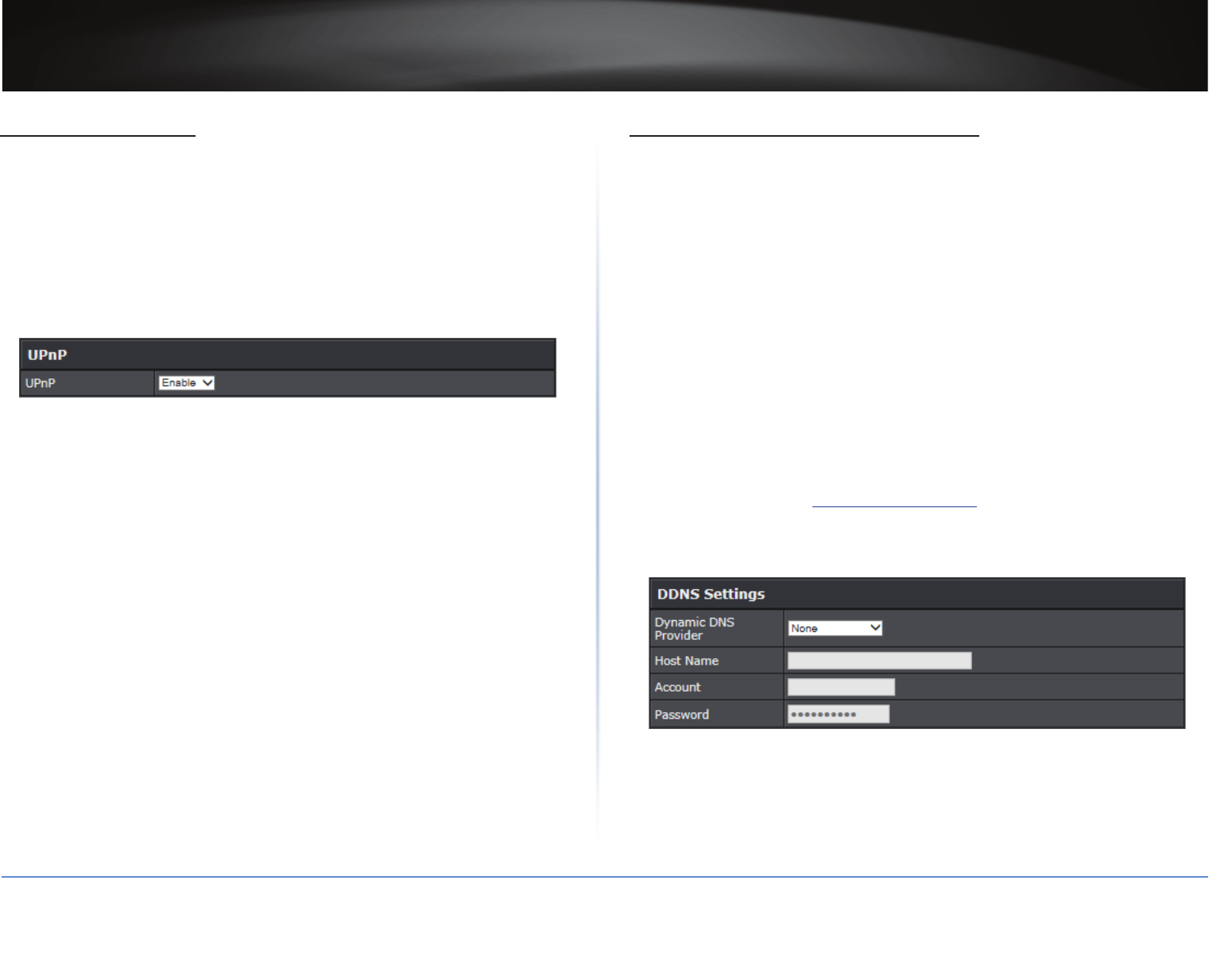
TRENDnet User’s Guide
TEW-823DRU
29
© Copyright 2014 TRENDnet. All Rights Reserved.
Enable/Disable UPnP
Advanced > Administrator > Advanced Network
UPnP (Universal Plug and Play) allows devices connected to a network to discover each
other and automacally open the connecons or services for specic applicaons (for
example, instant messenger, online gaming applicaons, etc.) UPnP is enabled on your
router by default to allow specic applicaons required by your computers or devices to
allow connecons through your router as they are needed.
1 Log into your router management page (refer to “Log in to Management Page” on page 8).
2 Click on Advanced > Administrator > Advanced Network.
3 In UPnP secon, enable or disable UPnP.
4 Click Apply to save the changes.
ÍNote: To discard the changes, click Reset.
Idenfy Your Network on the Internet
Advanced > Setup > Management
Since most ISPs constantly change your home IP address, providing access to devices on your
home or small oce Local Area Network (such as IP Cameras) from the Internet requires
seng up a Dynamic DNS service and entering the parameters into this management area.
Dynamic DNS services allow your router to conrm its locaon to the given Dynamic DNS
service, thereby providing the Dynamic DNS service with the ability to provide a virtual
xed IP address for your network. This means that even though your ISP is always changing
your IP address, the Dynamic DNS service will be able to idenfy your network using a xed
address—one that can be used to view home IP Camera and other devices on your local
area network.
ÍNote: First, you need to sign up for one of the DDNS service providers listed in the
Dynamic DNS Provider drop-down list.
1 Log into your router management page (refer to “Log in to Management Page” on page 8).
2 Click on Advanced > Setup > Management.
3 In DDNS Sengs secon, modify the following sengs:
ͫDynamic DNS Provider: Click the drop-down list to select your DDNS service.
ͫHost Name: Enter the personal URL provided to you by your Dynamic DNS service
provider. For example, www.trendnet.dyndns.biz.
ͫAccount: Enter the user name needed to log in to your Dynamic DNS service account.
ͫPassword: Enter the password to gain access to Dynamic DNS service for which you
have signed up to. (NOT your router or wireless network password).
4 Click Apply to save the changes.
ÍNote: To discard the changes, click Cancel.
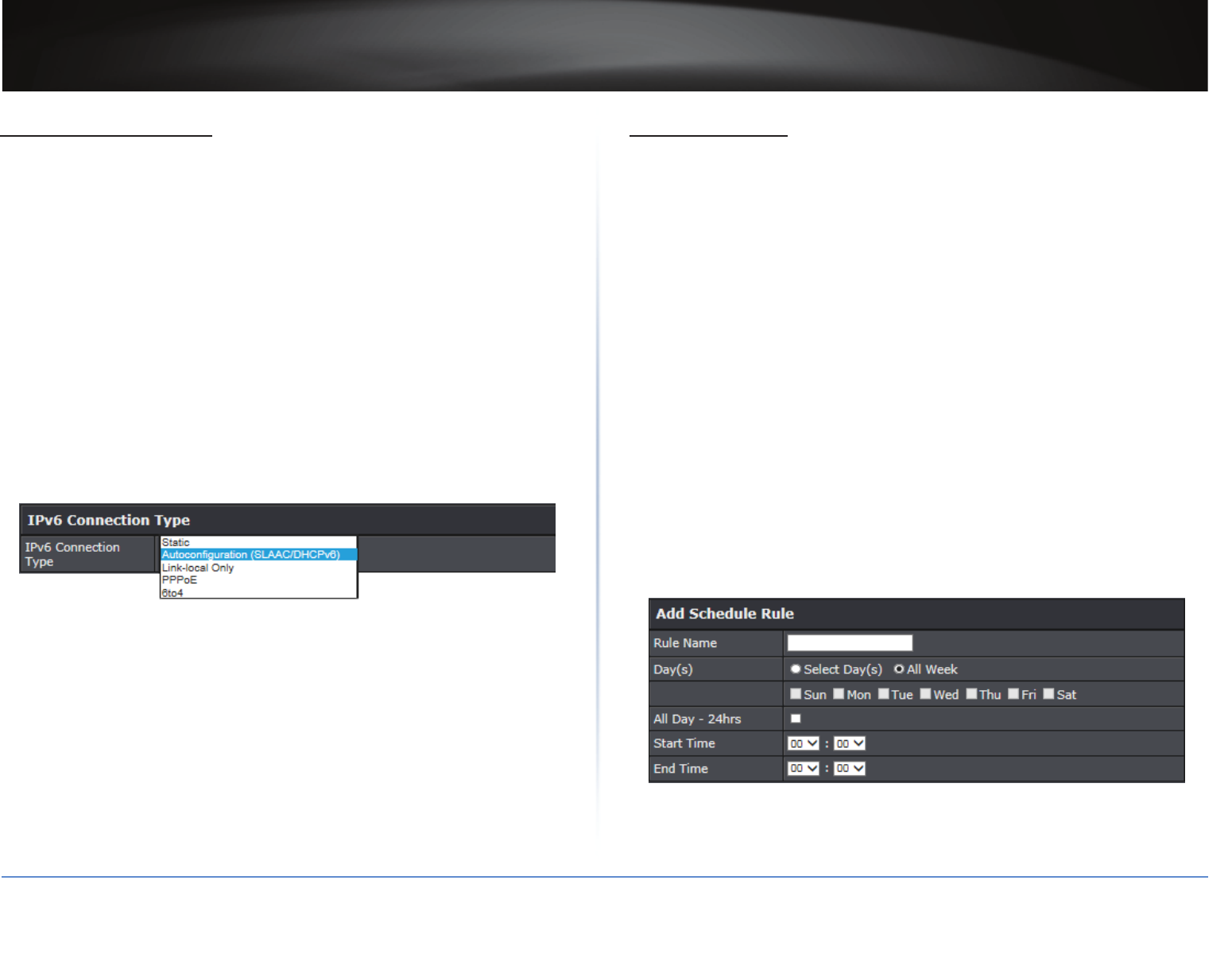
TRENDnet User’s Guide
TEW-823DRU
30
© Copyright 2014 TRENDnet. All Rights Reserved.
Congure IPv6 Sengs
Advanced > Setup > IPv6Sengs
IPv6 (Internet Protocol Version 6) is a new protocol that signicantly increases the number
of available Internet public IP addresses due to the 128-bit IP address structure versus IPv4
32-bit address structure. In addion, there are several integrated enhancements compared
to the most commonly used and well known IPv4 (Internet Protocol Version 4) such as:
• Integrated IPsec: Beer Security.
• Integrated Quality of Service (QoS): Lower latency for real-me applicaons.
• Higher Eciency of Roung: Less transmission overhead and smaller roung tables.
• Easier conguraon of addressing.
ÍNote: In order to use IPv6 Internet connecon sengs, it is required that your ISP
provide you with the IPv6 service. Please contact your ISP for available and more
informaon on the IPv6 service.
1 Log into your router management page (refer to “Log in to Management Page” on page 8).
2 Click on Advanced > Setup > IPv6 Sengs.
3 Review the IPv6 Internet Connecon sengs and enter informaon sengs specied
by your ISP.
ÍNote: Please contact your ISP for IPv6 service availability.
Select the IPv6 connecon type provided by your ISP.
4 Click Apply to save the changes.
ÍNote: To discard the changes, click Cancel.
Create Schedules
Advanced > Setup > Schedule
For addional security control, your router allows you to create schedules to specify a me
period when a feature on your router should be acvated and deacvated. Before you use
the scheduling feature on your router, ensure that your router system me is congured
correctly.
ÍNote: You can apply a predened schedule to the following features:
ͳ Wireless (2.4GHz and 5GHz)
ͳGuest Network
ͳ Parental Control (MAC/IP Filters)
ͳ Access Control (IP Protocol Filters)
ͳVirtual Server
ͳ Special Applicaons
ͳGaming
1 Log into your router management page (refer to “Log in to Management Page” on page 8).
2 Click on Advanced > Setup > Schedule.
3 In Add Schedule Rule secon, modify the following values:
ͫRule Name: Enter a name for the schedule you would like to apply.
ͫDay(s): Check Select Day(s) to select the specic days or select All Week to set the
schedule for all days.
ÍNote: Check the checkbox next to the day(s) when you want to run the schedule.
ͫAll Day – 24 Hours: Check the opon to set the schedule to 24 hours.
ͫStart/End Time: Select the start and end me you would like the schedule to follow.
4 Click Apply to save the changes.
ÍNote: To discard the changes, click Clear.
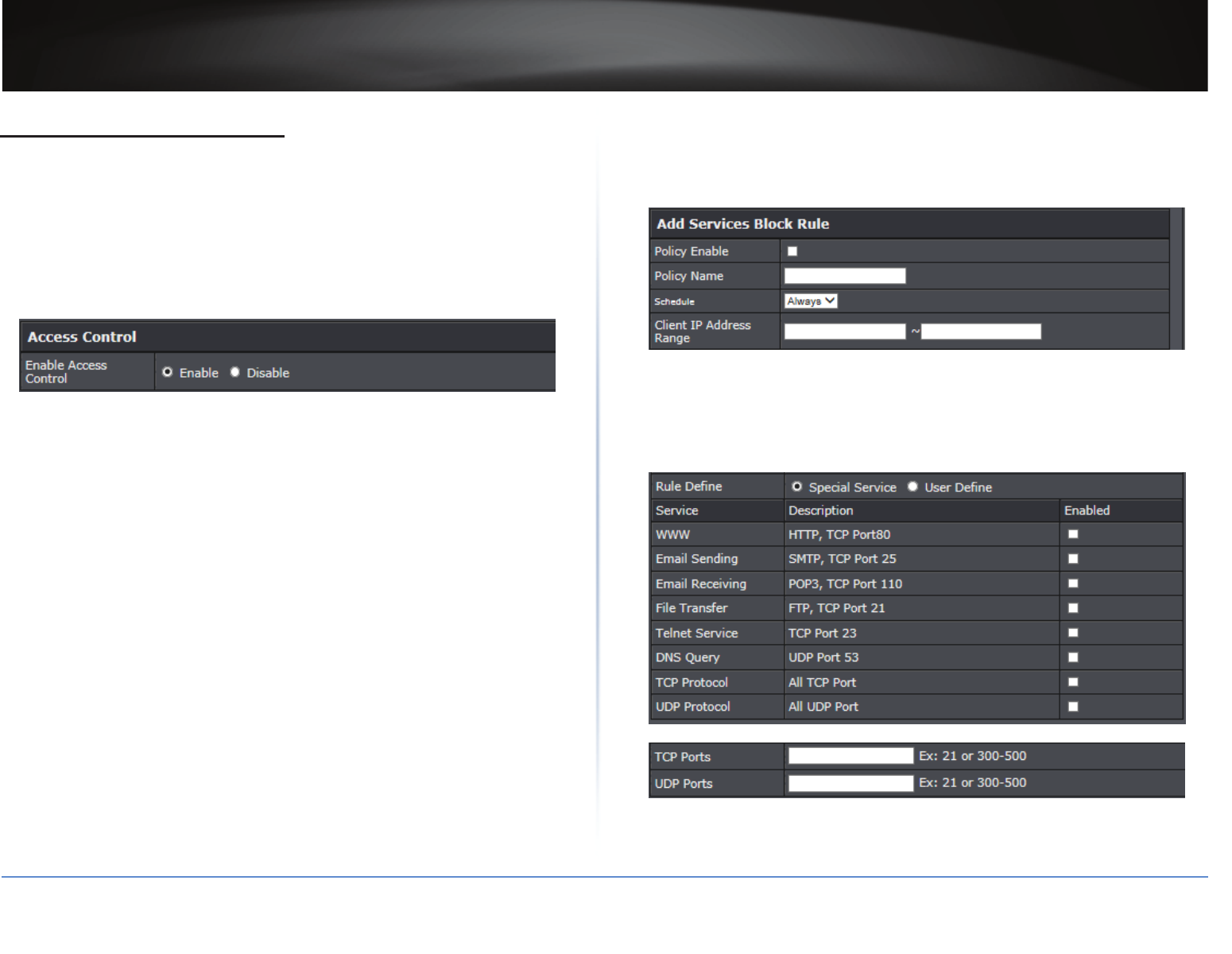
TRENDnet User’s Guide
TEW-823DRU
31
© Copyright 2014 TRENDnet. All Rights Reserved.
Congure Access Control Rules
Advanced > Security > Access Control
You may want to block computers or devices on your network access to specic ports (used
or required by a specic applicaon) to the Internet.
Block a specic service or mulple services
1 Log into your router management page (refer to “Log in to Management Page” on page 8).
2 Click on Advanced > Security > Access Control.
3 In Access Control secon, click the Enable opon.
4 In Add Services Block Rule secon, modify the following values:
ͫPolicy Enable: Checking this opon turns on the Protocol/IP Filter and unchecking
turns it o.
ͫPolicy Name: Enter a name for the Protocol/IP Filter.
ͫSchedule (Oponal): Select the pre-dened schedule to apply. The lter will only be
acve during the me period dened in the pre-dened schedule.
ÍNote: Before applying scheduling, please ensure your Time sengs are congured
correctly and you have dened a schedule. Refer to “Set the Date and Time” on
page 42 and “Create Schedules” on page 30 to create a schedule.
ͫClient IP Address Range: Enter the IP address or IP address range to apply the
protocol/IP lter. For example, 192.168.10.20-192.168.10.20 or 192.168.10.20-
192.168.10.30.
ÍNote: The lter will not be applied to IP addresses outside of the range specied.
To simplify conguraon, there is a list of commonly used pre-dened Protocol/IP
Filters to modify otherwise, you can choose to manually add a new Protocol/IP Filter.
ͫRule Dene: Select Special Service to select from the predened services listed or
select User Dene to specically enter the TCP or UDP port number or port range
numbers to block. For example, 80-80 or 20-21.
5 Click Add to save the rule.
ÍNote: To discard the changes, click Cancel.
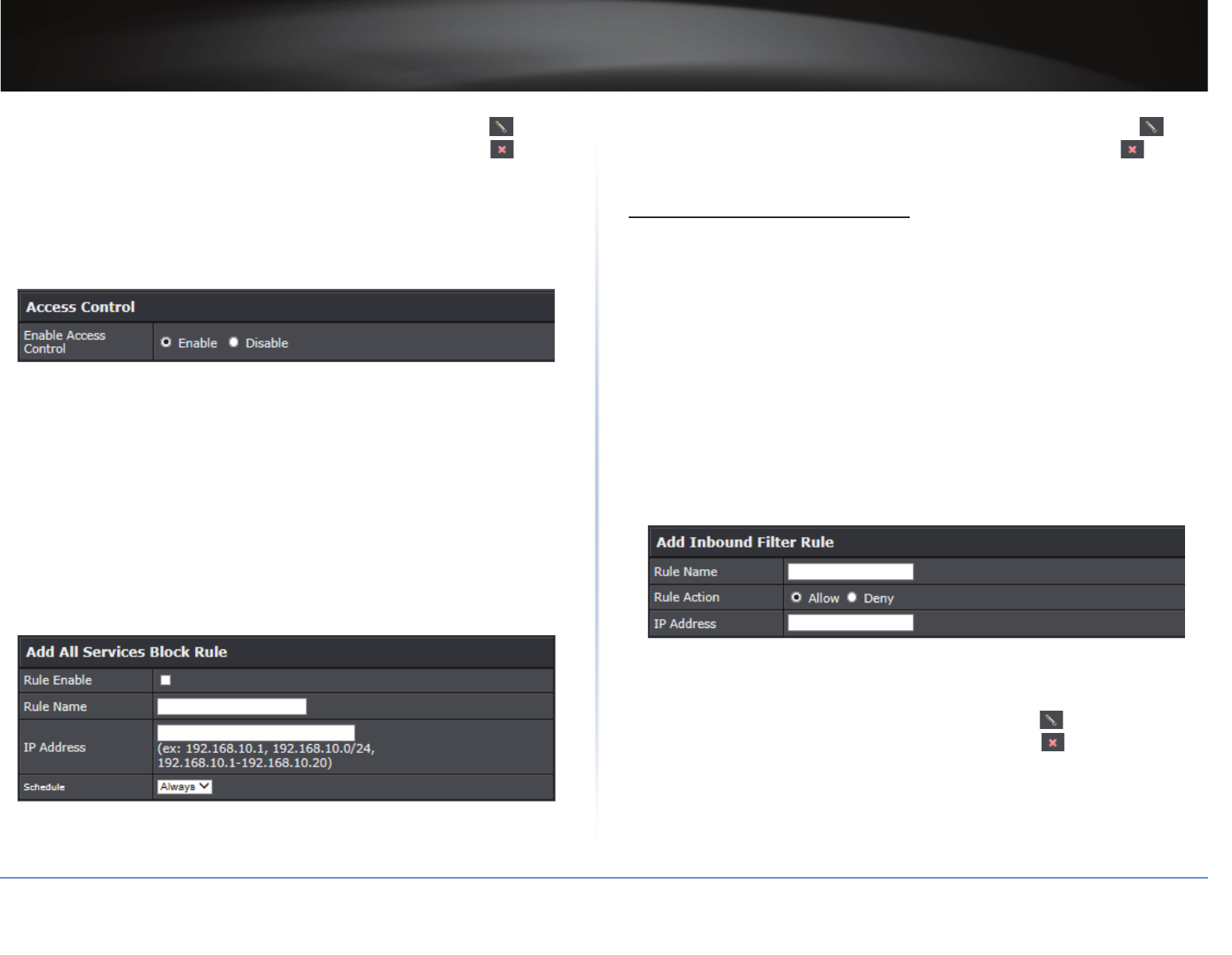
TRENDnet User’s Guide
TEW-823DRU
32
© Copyright 2014 TRENDnet. All Rights Reserved.
ÍNote: In the Services Block Rule List secon, you can edit a rule by clicking in the
Edit column next to the rule you would like to edit. To delete the rule, click in the
Delete column next to the rule you would like to delete.
Block All Services
1 Log into your router management page (refer to “Log in to Management Page” on page 8).
2 Click on Advanced > Security > Access Control.
3 In Access Control secon, click the Enable opon.
4 In Add Services Block Rule secon, modify the following values:
ͫRule Enable: Checking this opon turns on the Protocol/IP Filter and unchecking
turns it o.
ͫRule Name: Enter a name for the Protocol/IP Filter.
ͫIP Address: Enter the IP address or IP address range to apply the protocol/IP lter. For
example, 192.168.10.1, 192.168.10.0/24 or 192.168.10.1-192.168.10.30.
ÍNote: The lter will not be applied to IP addresses outside of the range specied.
ͫSchedule (Oponal): Select the pre-dened schedule to apply. The lter will only be
acve during the me period dened in the pre-dened schedule.
ÍNote: Before applying scheduling, please ensure your Time sengs are congured
correctly and you have dened a schedule. Refer to “Set the Date and Time” on
page 42 and “Create Schedules” on page 30 to create a schedule.
5 Click Add to save the rule.
ÍNote: To discard the changes, click Reset.
ÍNote: In the All Services Block Rule List secon, you can edit a rule by clicking in the
Edit column next to the rule you would like to edit. To delete the rule, click in the
Delete column next to the rule you would like to delete.
Congure Inbound Filter Rules
Advanced > Security > Inbound Filter
Inbound Filters allows you to allow or deny a specic range of IP addresses. You can create
a predened range of IP addresses to apply to a specic feature.
ÍNote: You can apply a predened inbound lter to the following features:
ͳVirtual Server
ͳGaming
ͳRemote Management
1 Log into your router management page (refer to “Log in to Management Page” on page 8).
2 Click on Advanced > Security > Inbound Filter.
3 In Add Inbound Filter Rule, modify the following values:
ͫFilter Name: Enter a name for the IP address range.
ͫRule Acon: Select Allow to allow the specied IP address range or Deny to deny the
specied IP address range.
ͫIP Address: Enter the IP address. For example, 192.168.1.20-192.168.1.30.
4 Click Add to save the Inbound Filter.
ÍNote: To discard the changes, click Clear.
ÍNote: In the Inbound Filter List, you can edit a rule by clicking in the Edit column
next to the rule you would like to edit. To delete the rule, click in the Delete column
next to the rule you would like to delete.
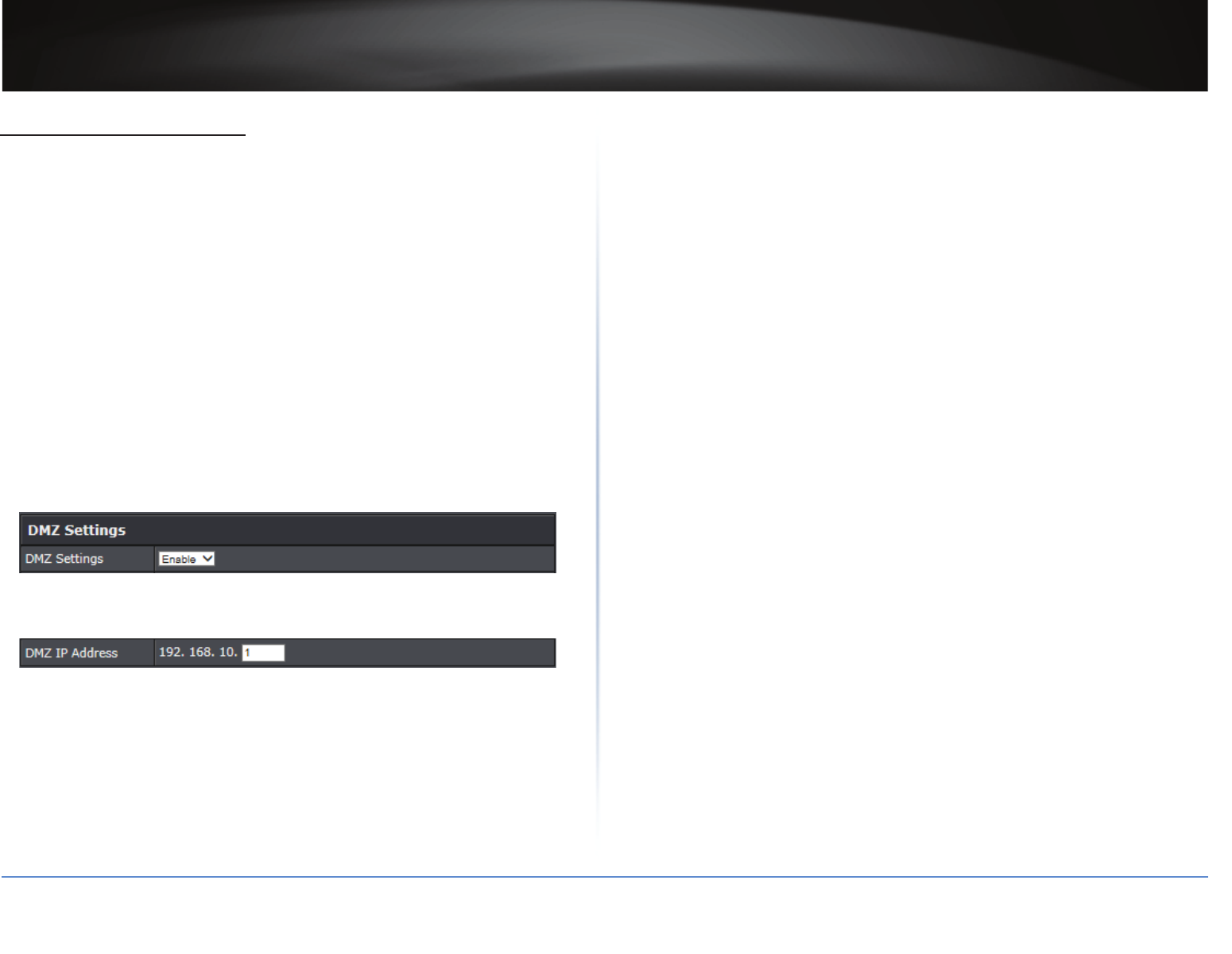
TRENDnet User’s Guide
TEW-823DRU
33
© Copyright 2014 TRENDnet. All Rights Reserved.
Congure Firewall Sengs
This router can provide access to devices on your local area network to the Internet using
the Virtual Server, Special Applicaon, method (DMZ NOT recommended).
DMZ
Advanced > Firewall > DMZ
You may want to expose a specic computer or device on your network to the Internet
to allow anyone to access it. Your router includes the DMZ (Demilitarized Zone) feature
that makes all the ports and services available on the WAN/Internet side of the router
and forwards them to a single IP address (computer or network device) on your network.
The DMZ feature is an easy way of allowing access from the Internet however, it is a very
insecure technology and will open local area network to greater threats from Internet
aacks.
It is strongly recommended to use Virtual Server (also called port forwarding, refer to
“Virtual Server” on page 33) to allow access to your computers or network devices from
the Internet.
1 Log into your router management page (refer to “Log in to Management Page” on page 8).
2 Click on Advanced > Firewall > DMZ.
3 In DMZ Sengs secon, select Enable from the DMZ Sengs drop-down list.
4 Enter the IP address you assigned to the computer or network device to expose to the
Internet.
5 Click Apply to save the changes.
ÍNote: To discard the changes, click Reset.
Virtual Server
Advanced > Firewall > Virtual Server
Virtual Server (also called port forwarding) allows you to dene specic ports (used or
required by a specic applicaon) and forward them to a single IP address (a computer or
device) on your network. Using this feature is more secure compared to using DMZ (refer
to “DMZ” on page 33) in which DMZ forwards all ports instead of only specic ports used
by an applicaon. An example would be forwarding a port to an IP camera (TRENDnet IP
cameras default to HTTP TCP port 80 for remote access web requests) on your network
to be able to view it over the Internet. To open several ports please refer to “Gaming” on
page 35.
Since most ISPs constantly change your home IP address, to be able to access the Virtual
Server port(s) from the Internet it is recommended to setup Dynamic DNS service (outlined
in “Idenfy Your Network on the Internet” on page 29).
1 Log into your router management page (refer to “Log in to Management Page” on page
8).
2 Click on Advanced > Firewall > Virtual Server.
3 In Add Virtual Server secon, modify the following sengs:
ͫRule Enable: Check the opon to enable the virtual server.
ͫRule Name: Enter a name for the virtual server.
ͫIP Address: Enter the IP address of the device to forward the port. For example,
192.168.10.101.
ͫProtocol: Select the protocol required for your device. TCP, UDP, or Both (TCP and
UDP).
ͫPublic Port: Enter the port number used to access the device from the Internet.
ͫPrivate Port: Enter the port number required by your device. Refer to the connecng
device’s documentaon for reference to the network port(s) required.
ÍNote: The Public Port can be assigned a dierent port number than the Private
Port (also known as port redirecon), however it is recommended to use the
same port number for both sengs. Please refer to the device documentaon to
determine which ports and protocols are required. It is recommended to assign a
stac IP address to the device or use DHCP reservaon to ensure the IP address of
the device does not change.
ͫInbound Filter: Select the dened IP address range to allow access.
ͫSchedule: Click New Schedule to select the pre-dened schedule to apply. The lter
will only be acve during the me period dened in the pre-dened schedule.
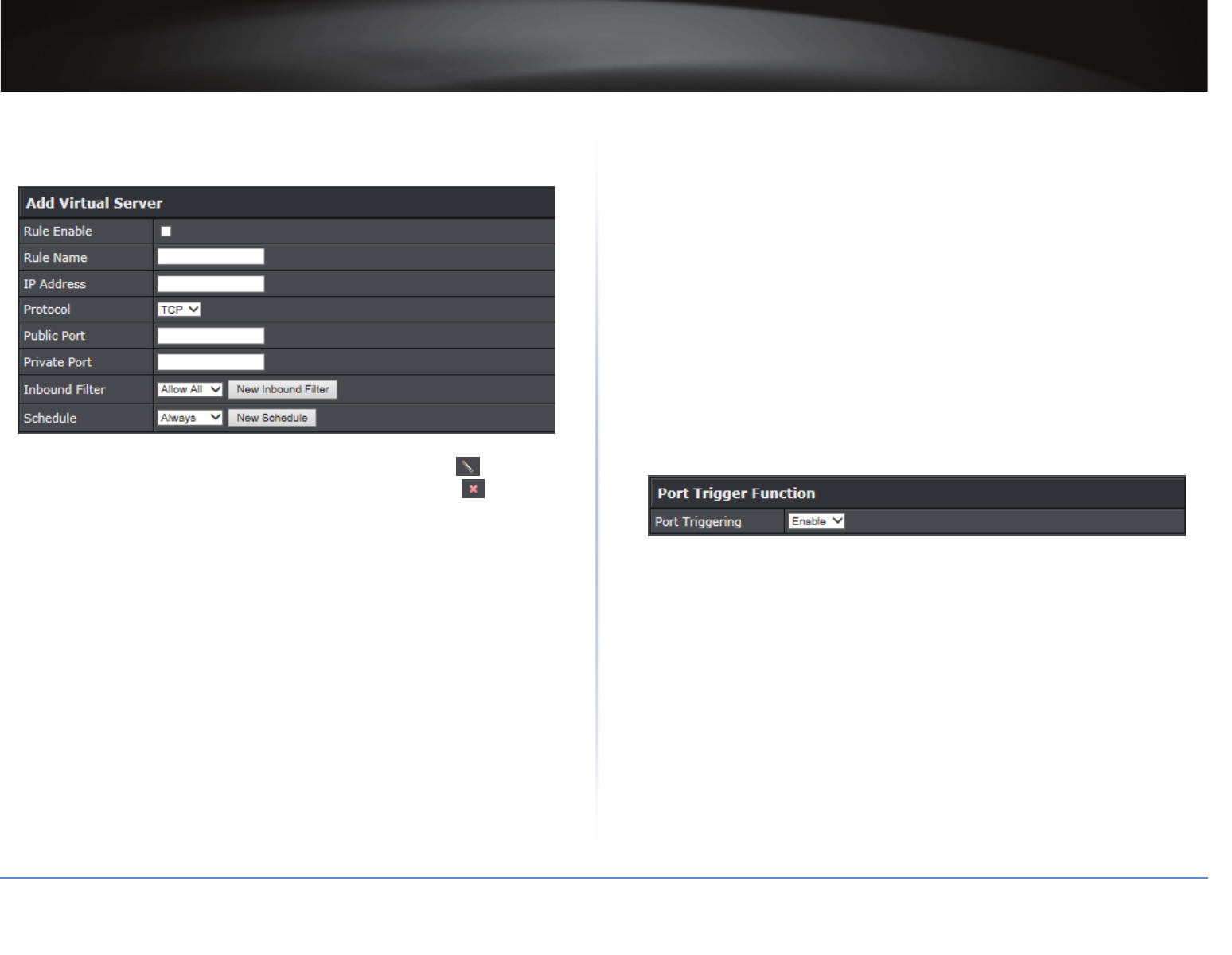
TRENDnet User’s Guide
TEW-823DRU
34
© Copyright 2014 TRENDnet. All Rights Reserved.
ÍNote: Before applying scheduling, please ensure your Time sengs are congured
correctly and you have dened a schedule. Refer to “Set the Date and Time” on
page 42 and “Create Schedules” on page 30 to create a schedule.
ÍNote: In the Virtual Server List secon, you can edit a rule by clicking in the Edit
column next to the rule you would like to edit. To delete the rule, click in the Delete
column next to the rule you would like to delete.
Example: To forward the TCP port 80 to your IP camera, you need to do the following:
1 Setup DynDNS service. Refer to “Idenfy Your Network on the Internet” on page 29.
2 Access TRENDnet IP Camera management page and forward Port 80 (refer to the product
documentaon).
3 Make sure to congure your network/IP camera to use a stac IP address.
ÍNote: You may need to reference your camera documentaon on conguring a
stac IP address.
4 Log into your router management page (refer to “Log in to Management Page” on page
8).
5 Click on Advanced > Firewall > Virtual Server.
6 Check the Rule Enable opon to enable the Virtual Server.
7 Enter the IP address of the camera. For example, 192.168.10.101.
8 Next to Protocol, make sure TCP is selected from the drop-down list.
9 The Private Port and Public Port, enter the port number 80 for both.
10 Click Add to save the sengs.
Special Applicaons
Advanced > Firewall > SpecialApplicaons
Applicaon rules (also called port triggering) is typically used for online gaming applicaons
or communicaon applicaons that require a range of ports or several ports to be
dynamically opened on request to a device on your network. The router will wait for a
request on a specic port or range of ports (or trigger port/port range) from a device on
your network and once a request is detected by your router, the router will forward a single
port or mulple ports (or incoming port/port range) to the device on your network. This
feature is not typically used as most devices and routers currently use UPnP (Universal Plug
and Play) to automacally congure your router to allow access for applicaons. Refer to
“Enable/Disable UPnP” on page 29.
IMPORTANT: Please refer to the device documentaon to determine if your device supports
UPnP rst, before conguring this feature.
1 Log into your router management page (refer to “Log in to Management Page” on page 8).
2 Click on Advanced > Firewall > Special Applicaons.
3 In Port Trigger Funcon secon, click the Port Triggering drop-down menu and choose
Enable.
4 Click Apply to save the changes.
5 In Add Port Trigger Rule secon, review and modify the following sengs:
ͫRule Enable: Check the opon to enable the port trigger rule.
ͫRule Name: Enter a name for the port trigger rule.
ͫMatch Protocol: Select the protocol for the rewall ports required for your device.
The available opons are TCP, UDP, or Any (TCP and UDP).
ͫMatch Port: Enter the ports or port range to be forwarded to the device. For example,
2000-2038,2200-2210.
ͫTrigger Protocol (Trigger): Select the trigger port protocol requested by the device.
The available opons are TCP, UDP, or Any.
ͫTrigger Port: Enter the port requested by the device. For example, 554-554 or 6112-
6112).
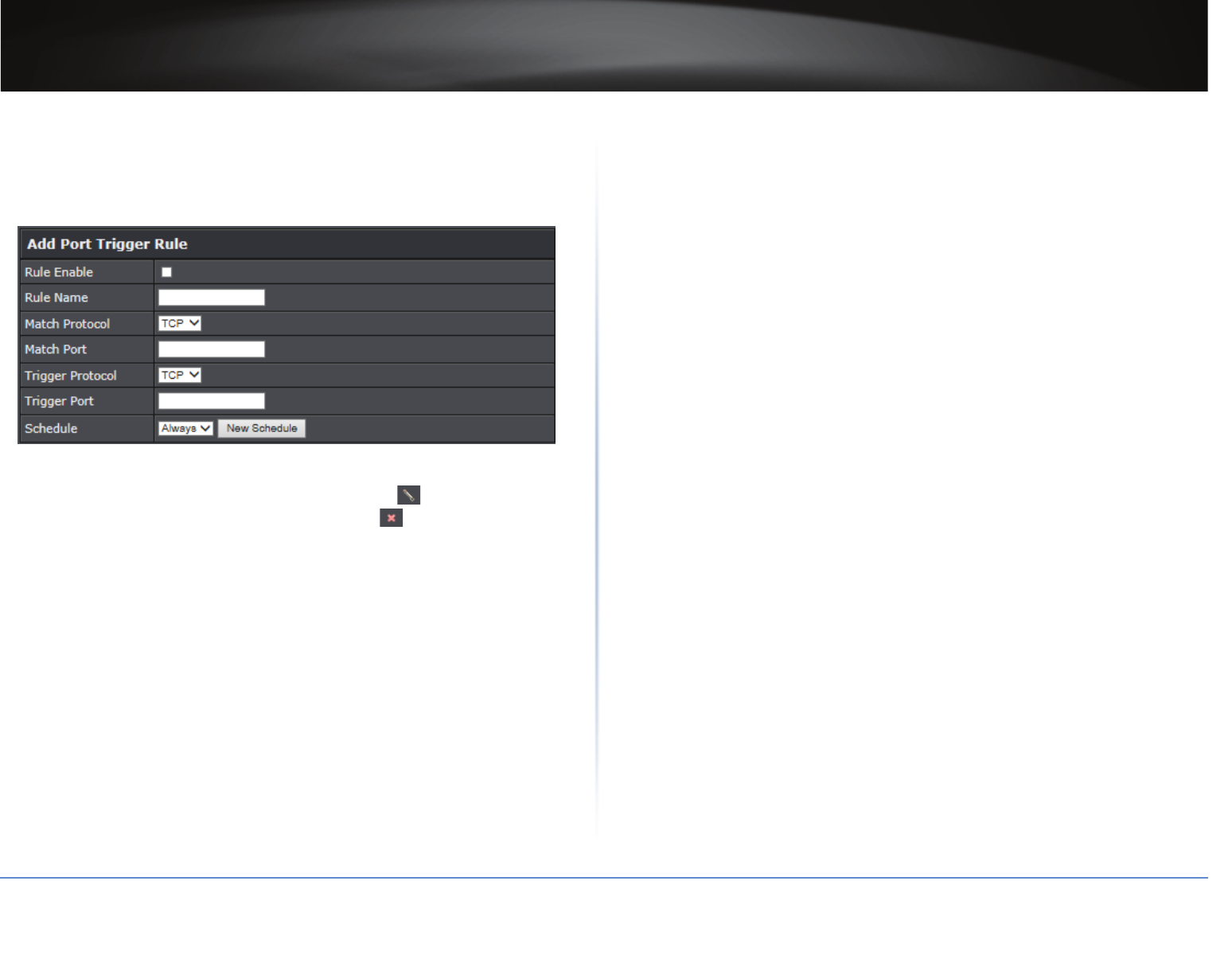
TRENDnet User’s Guide
TEW-823DRU
35
© Copyright 2014 TRENDnet. All Rights Reserved.
ͫSchedule: Click New Schedule to select the pre-dened schedule to apply. The lter
will only be acve during the me period dened in the pre-dened schedule.
ÍNote: Before applying scheduling, please ensure your Time sengs are congured
correctly and you have dened a schedule. Refer to “Set the Date and Time” on
page 42 and “Create Schedules” on page 30 to create a schedule.
6 Click Add to save the sengs.
ÍNote: In the Rule List secon, you can edit a rule by clicking in the Edit column next
to the rule you would like to edit. To delete the rule, click in the Delete column next
to the rule you would like to delete.
Gaming
Advanced > Firewall > Gaming
Gaming allows you to dene mulple ports (used or required by a specic applicaon or
game) and forward them to a single IP address (a computer or device) on your network.
Using this feature is more secure compared to using DMZ (refer to “DMZ” on page 33)
in which DMZ forwards all ports instead of only specic ports used by an applicaon.
Since most ISPs constantly change your home IP address, to be able to access the Virtual
Server port(s) from the Internet it is recommended to setup Dynamic DNS service (refer to
“Idenfy Your Network on the Internet” on page 29).
1 Log into your router management page (refer to “Log in to Management Page” on page 8).
2 Click on Advanced > Firewall > Gaming.
3 In Add Gaming Rule secon, modify the following values:
ͫRule Enable: Check the opon to enable the gaming rule.
ͫRule Name: Enter a name for the gaming rule.
ͫIP Address: Enter the IP address of the device to forward the ports. For example,
192.168.10.101.
ͫTCP Ports to Open: Enter the TCP port you would like to set.
ͫUDP Ports to Open: Enter the UDP port you would like to set.
ÍNote: Please refer to the device documentaon to determine which ports and
protocols are required. You should assign a stac IP address to the device or use
DHCP reservaon to ensure the IP address of the device does not change.
ͫInbound Filter: Select the dened IP address range to allow access.
ͫSchedule: Click New Schedule to select the pre-dened schedule to apply. The lter
will only be acve during the me period dened in the pre-dened schedule.
ÍNote: Before applying scheduling, please ensure your Time sengs are congured
correctly and you have dened a schedule. Refer to “Set the Date and Time” on
page 42 and “Create Schedules” on page 30 to create a schedule.
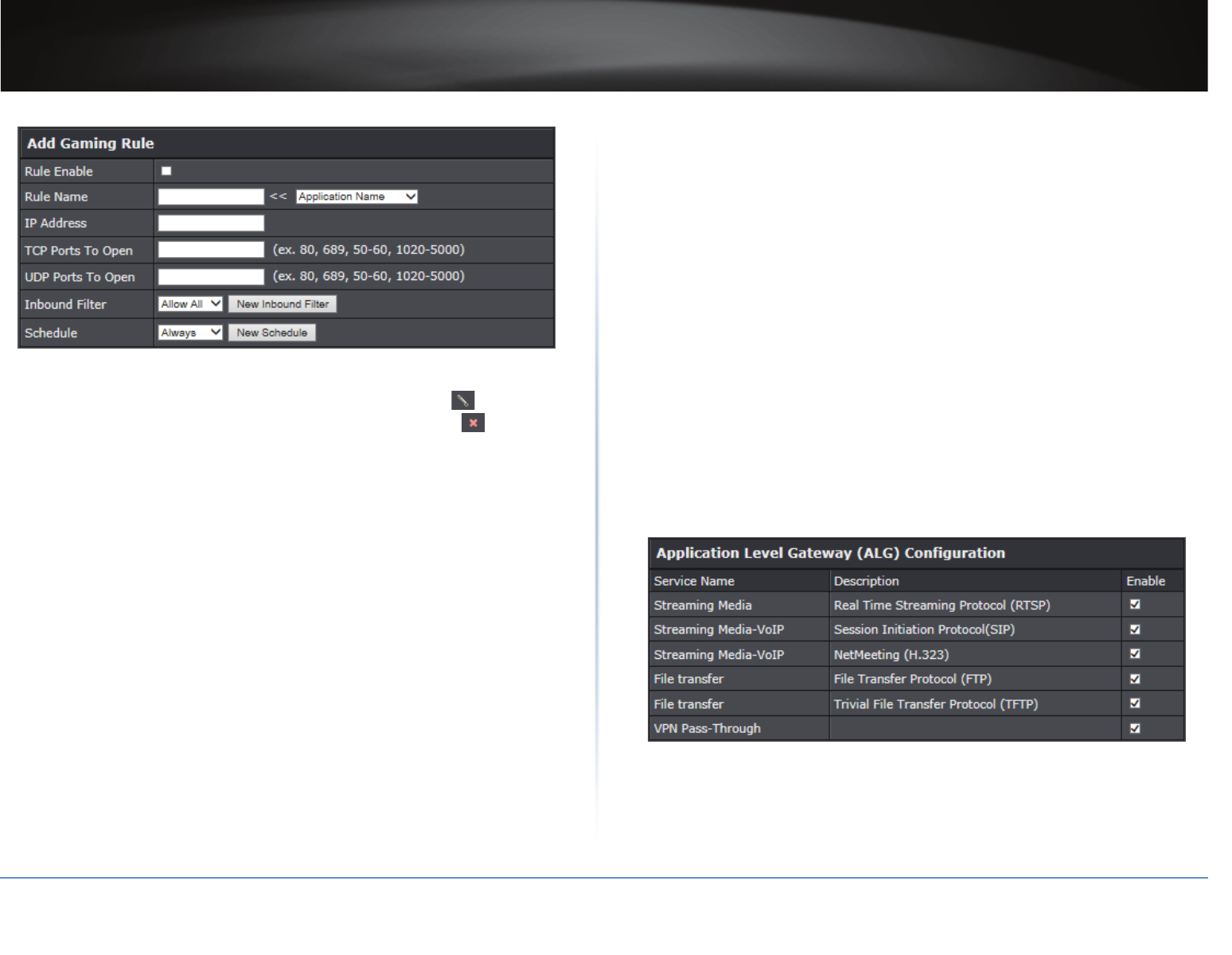
TRENDnet User’s Guide
TEW-823DRU
36
© Copyright 2014 TRENDnet. All Rights Reserved.
4 Click Add to save the sengs.
ÍNote: In the Gaming Rule List secon, you can edit a rule by clicking in the Edit
column next to the rule you would like to edit. To delete the rule, click in the Delete
column next to the rule you would like to delete.
ALG
Advanced > Firewall > ALG
You may want to congure your router to allow computers the use of specic high layer
applicaons or service sessions to pass through. Applicaon Layer Gateways (ALG) allows
you to easily enable or disable these applicaons to pass through your router.
ÍNote: It is recommended to leave these sengs enabled.
1 Log into your router management page (refer to “Log in to Management Page” on page 8).
2 Click on Advanced > Firewall > ALG.
3 In Applicaon Level Gateway (ALG) Conguraon secon, modify the following values:
ͫStreaming Media: Check this opon to allow RTSP protocol through your router
typically used in streaming media applicaons.
ͫStreaming Media-VoIP: Check this opon to allow SIP protocol through your router
typically used in VoIP applicaons.
ͫStreaming Media-VoIP: Check this opon to allow H.323 protocol through your
router typically used in video/audio conferencing applicaons.
ͫFile Transfer: Check this opon to allow FTP protocol through your router used for
le transfer over a network or the Internet.
ͫFile Transfer: Check this opon to allow TFTP protocol through your router used for
le transfer over a network or the Internet.
ͫVPN Pass-Through: Check this opon to allow client connecons through your router.
4 Click Save Status to save the sengs.
ÍNote: To discard the changes, click Cancel.
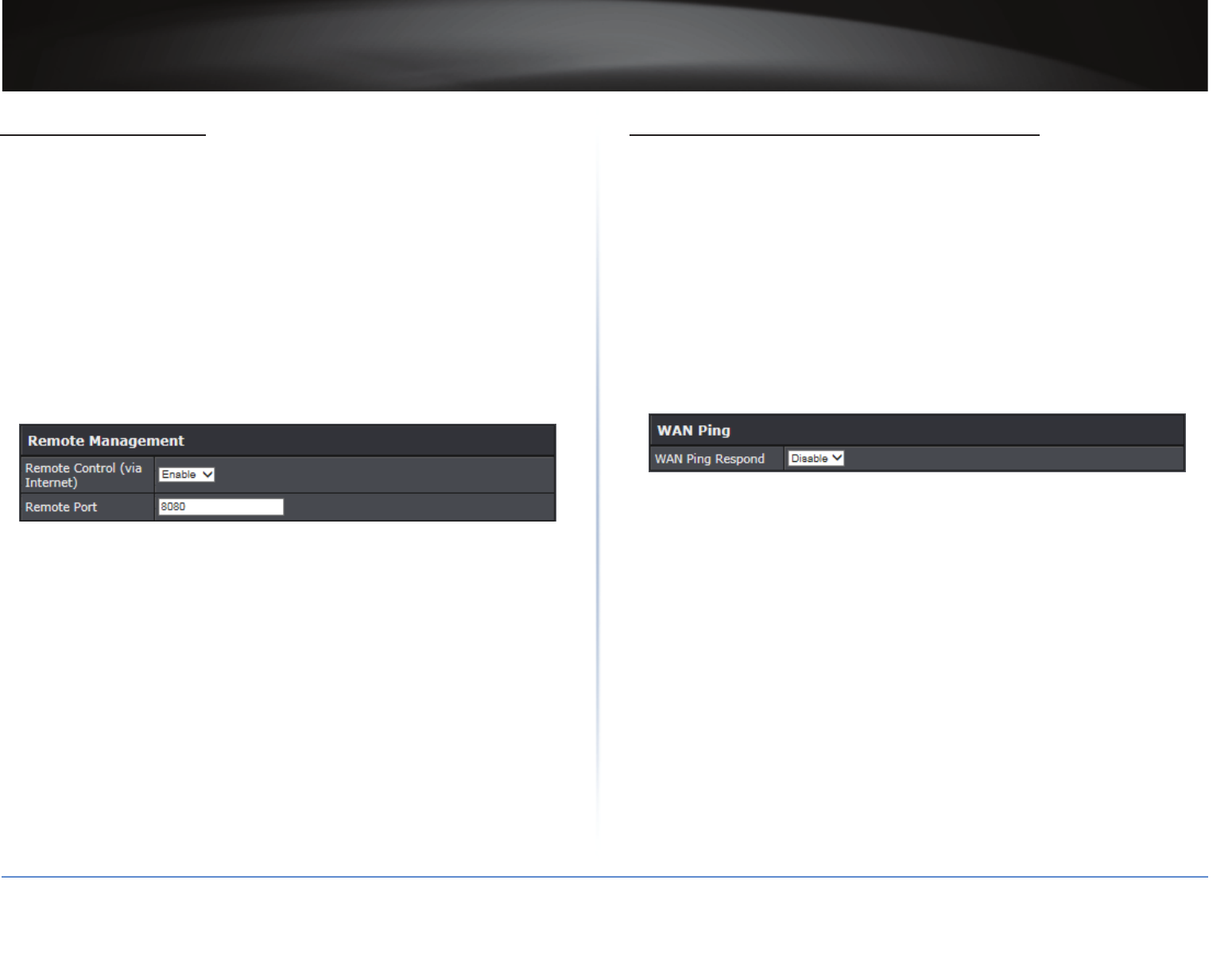
TRENDnet User’s Guide
TEW-823DRU
37
© Copyright 2014 TRENDnet. All Rights Reserved.
Enable Remote Access
Advanced > Setup > Management
You may want to make changes to your router from a remote locaon such at your oce
or another locaon while away from your home.
1 Log into your router management page (refer to “Log in to Management Page” on page 8).
2 Click on Setup > Management.
3 In Remote Management secon, modify the following values:
ͫRemote Control (via Internet): Click the drop-down list and select Enable to enable
remote management or Disable to disable remote management.
ͫRemote Port: Enter the port to assign remote access to the router. It is recommended
to leave this seng as 8080.
ÍNote: If you have congured port 8080 for another conguraon secon, such as
virtual server or special applicaon, please change the port to use. Recommended
port range is 1024 to 65534.
4 Click Apply to save the changes.
ÍNote: To discard the changes, click Reset.
Allow/Deny Ping Requests from the Internet
Advanced > Administrator > Advanced Network
To provide addional security, you may want to disable your router from responding to ping
or ICMP (Internet Control Message Protocol) requests from the Internet. A ping is network
communicaon test to check if a device with IP address is alive or exists on the network.
By disabling this feature, you can conceal your router’s IP address and existence on the
Internet by denying responses to ping requests from the Internet. You can addionally use
this feature as a tool for troubleshoong purposes.
1 Log into your router management page (refer to “Log in to Management Page” on page 8).
2 Click on Advanced > Administrator > Advanced Network
3 In WAN Ping secon, click the WAN Ping Respond drop-down list and select the desired
sengs.
ͫEnable to allow your router to respond to ping requests from the Internet.
ͫDisable to block WAN ping requests from the Internet.
4 Click Apply to save the changes.
ÍNote: To discard the changes, click Reset.
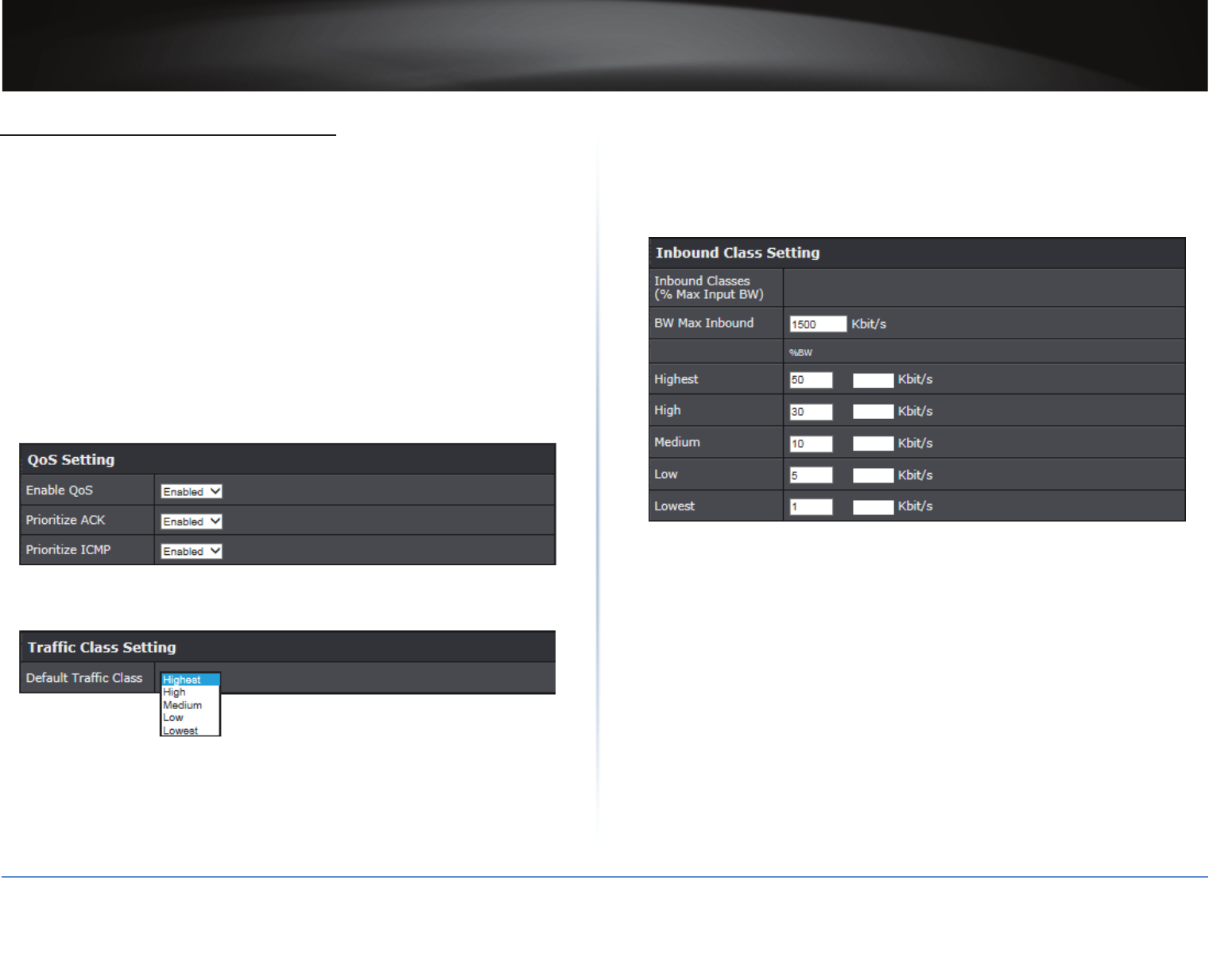
TRENDnet User’s Guide
TEW-823DRU
38
© Copyright 2014 TRENDnet. All Rights Reserved.
Congure Quality of Service Sengs
Advanced > Setup > QoS
QoS involves priorizaon of network trac. QoS can be targeted at a network interface,
toward a given server or router’s performance, or in terms of specic applicaons.
1 Log into your router management page (refer to “Log in to Management Page” on page 8).
2 Click on Advanced > Setup > QoS.
3 In QoS Seng secon, modify the following sengs:
ͫEnable QoS: Click Enabled to allow the Quality of service through the router. You can
also click Disable to disable the Quality of service through the router.
ͫPriorize ACK: Click Enabled to priorize the acknowledgment packets.
ͫPriorize ICMP: Click Enabled to priorize the ICMP requests. You can also click
Disabled if you do not want to priorize the ICMP requests.
ÍNote: The ICMP requests are basically ping requests. It is recommended to disable
it unless you wish to run a game server where it is important to maintain low level
of ping for players to determine the latency.
4 In Trac Class Seng secon, click the Default Trac Class drop-down list and select the
trac class you would like to congure for the QoS rule.
5 In Inbound Class Seng secon, modify the following sengs:
ͫBW Max Inbound: Enter the maximum download speed of your ISP (Internet Service
Provider).
ͫHighest/High/Medium/Low/Lowest: Enter the download speeds you would like to
apply on each state of download speeds. This seng is similar to seng the priority
speeds of each class.
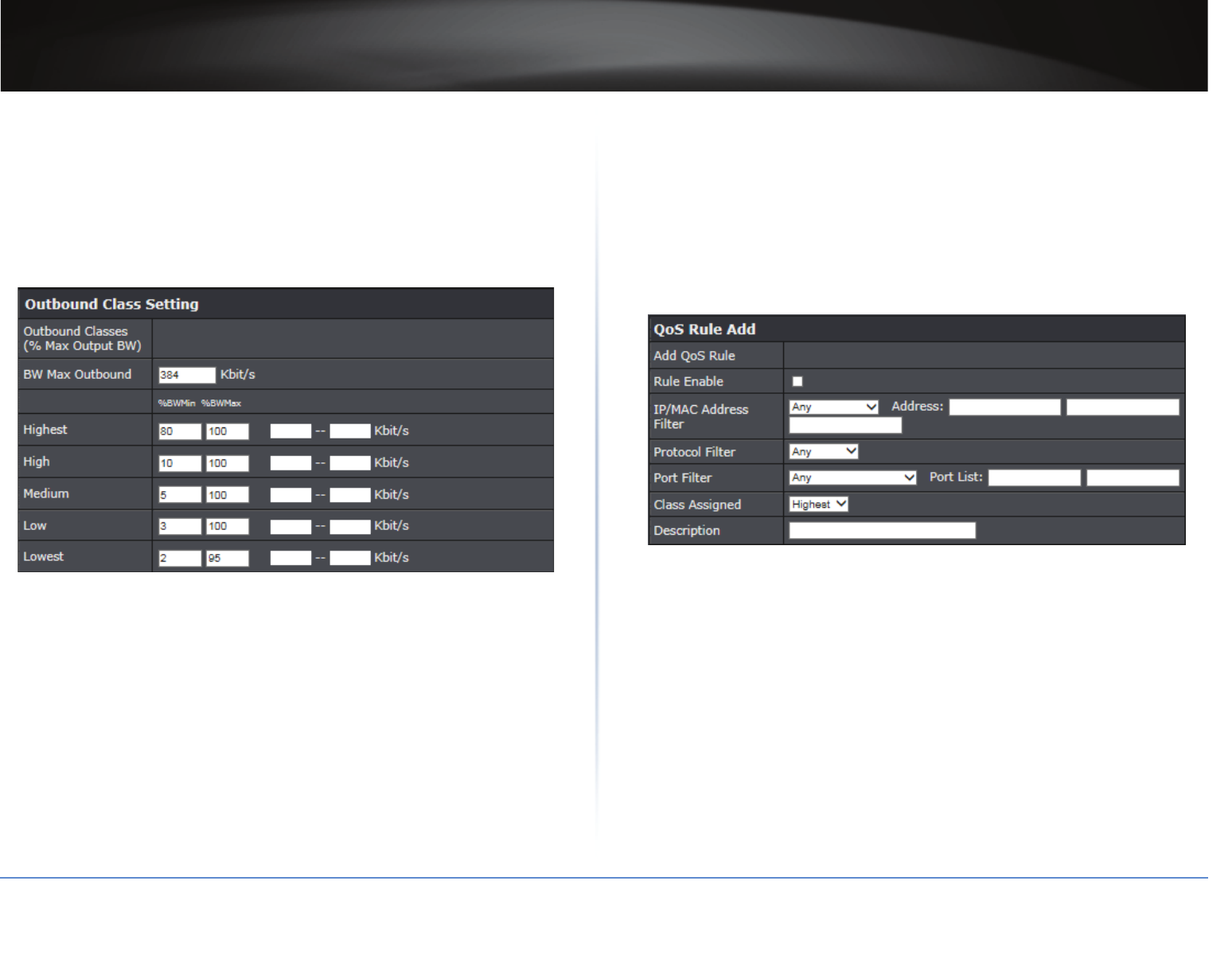
TRENDnet User’s Guide
TEW-823DRU
39
© Copyright 2014 TRENDnet. All Rights Reserved.
6 In Outbound Class Seng secon, modify the following sengs:
ÍNote: The elds will automacally populate when Inbound Class is congured but
you can also modify the sengs manually.
ͫBW Max Outbound: Enter the maximum upload speed of your ISP (Internet Service
Provider).
ͫHighest/High/Medium/Low/Lowest: Enter the upload speeds you would like to
apply on each state of download speeds. This seng is similar to seng the priority
speeds of each class.
7 Click Apply to save the changes.
ÍNote: To discard the changes, click Cancel.
8 In QoS Rule Add secon, modify the following values:
ͫRule Enable: Check this opon to enable the QoS rule.
ͫIP/MAC Address Filter: Click on the drop-down menu and choose the type of the
IP address or MAC address. Then enter the IP address and/or MAC address to the
Address eld(s).
ͫProtocol Filter: Select the protocol you would like to apply on the QoS rule.
ͫPort Filter: Select the port from the drop-down menu you would like to assign on the
QoS rule. Then enter the port number to the Port List eld.
ͫClass Assigned: Select the class that you have assigned to the QoS rule.
ͫDescripon: Enter the QoS descripon that best describes the rule.
9 Click Add to save the sengs.
ÍNote: To discard the changes, click Clear.
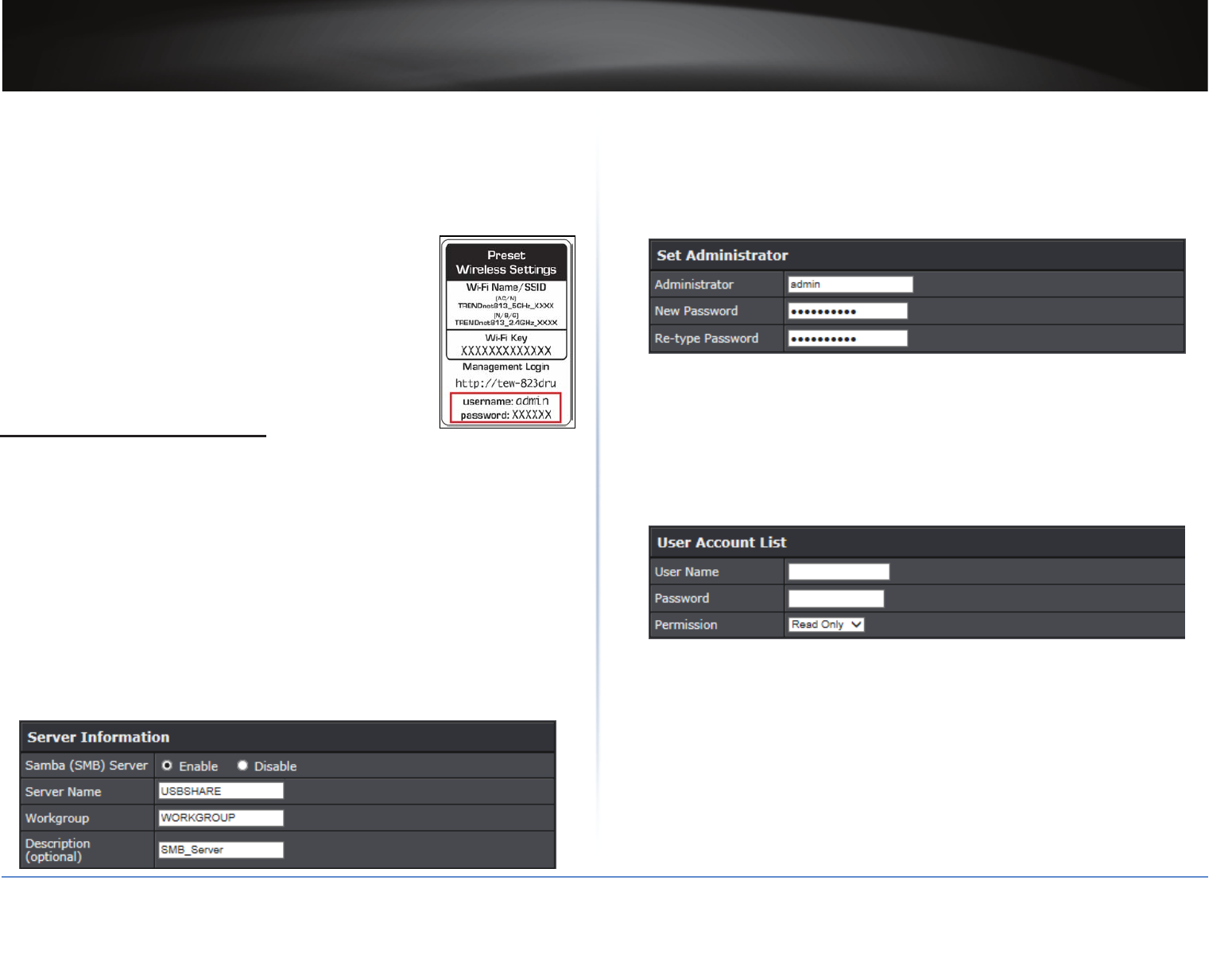
TRENDnet User’s Guide
TEW-823DRU
40
© Copyright 2014 TRENDnet. All Rights Reserved.
Using External USB Storage
Your router’s USB port can be used to share les through the network when a USB storage
device is connected on the back USB port. The router supports both FTP and SAMBA (SMB)
ling sharing protocols.
ÍNote:
ͳFor security purposes, the USB SMB and FTP sengs
on your router are disabled by default. You will need to
enable these sengs in order to allow access to your
USB storage devices.
ͳFor security purposes, the default USB SMB and FTP
admin password is congured to the same predened
password used to log into your router management
page.
Congure File Sharing Server
Advanced > USB > FileSharingServer
1 Log into your router management page (refer to “Log in to Management Page” on page 8).
2 Click on Advanced > USB > File Sharing Server.
3 In Server Informaon secon, modify the following values:
ͫSamba (SMB) Server: Select enable or disable for the feature.
ͫServer Name: You can change the name of your server which will be the name you
will when accessing your USB storage device.
ÍNote: You can also access the USB storage using the router IP address.
ͫWorkgroup: Enter the workgroup name. It is recommended to keep the standard
default “WORKGROUP”. If you change this seng, you will need to change the
workgroup name on all computers in your network that are allowed access to the
USB storage.
ͫDescripon (oponal): Enter a descripon of the server.
4 In Set Administrator secon, review the administrator sengs required for your File
Sharing (SMB) Server. Administrator will have read and write access to the les. To
dene user accounts, connue in the respecve secon.
ͫAdministrator: Modify the Administrator account user name.
ͫNew Password/Re-type Password: Enter the new password for the Administrator.
Re-type the password to conrm.
5 Click Apply to save the changes.
ÍNote: To discard the changes, click Clear.
6 In User Account List secon, you can add users to your File Sharing (SMB) Server.
ͫUser Name: Enter the user name to be used to access your les.
ͫPassword: Enter the password for the user name.
ͫPermission: Select the permission you will grant to the user. You can allow the user
Read Only or Read-Write access to the USB storage.
7 Click Add to add the account.
ÍNote:
ͳTo discard the changes, click Clear.
ͳUse Current User Account List to review all the user accounts. Click Delete to
delete the selected user account.
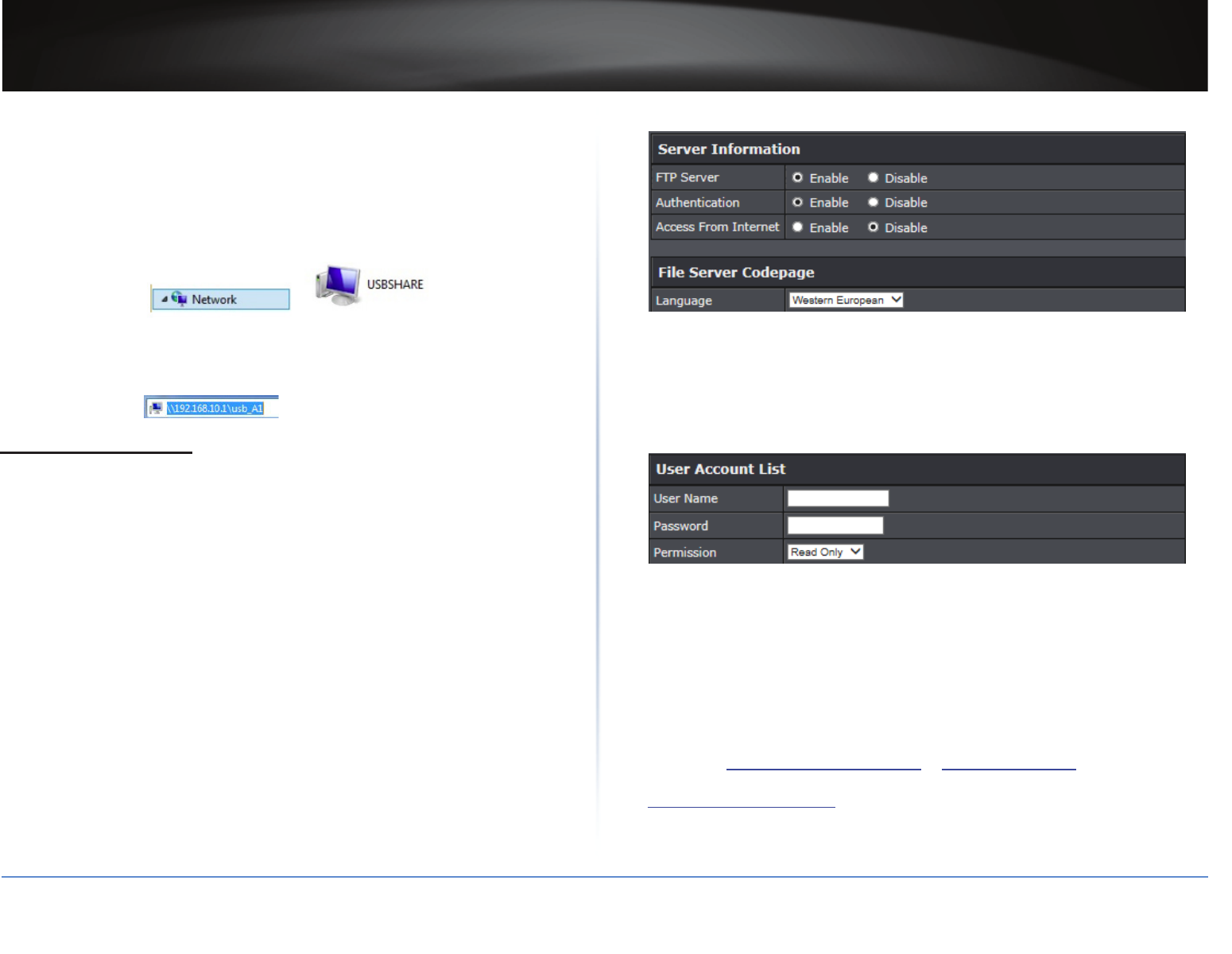
TRENDnet User’s Guide
TEW-823DRU
41
© Copyright 2014 TRENDnet. All Rights Reserved.
ÍNote:
ͳIn Windows® operang system, you can access the USB storage device on your
computer in the following path: Computer > Network > USBSHARE > usb_A1.
ͳYour computer will only be able to automacally discover the USB storage if you
are set to a workgroup under the default name “WORKGROUP”. Your computer
will not be able to automacally discover the USB storage if it is connected to a
domain or congured with a dierent workgroup name.
ͳIn Windows® operang system, if your computer cannot discover the USB storage
automacally, you can access the les in your server, using the network map or by
typing \\<routerIPaddress>\usb_A1 on your browser’s or le explorer address bar.
For example, .
Congure FTP Server
Advanced > USB > FTP Server
FTP (File Transfer Protocol) is used to access shared les through the Internet. In order to
share les, you will need to plug in a USB storage device on the USB port on the back of
the router.
1 Log into your router management page (refer to “Log in to Management Page” on page 8).
2 Click on Advanced > USB > FTP Server.
3 In Server Informaon secon, modify the following values:
ͫFTP Server: Select enable or disable for the feature.
ͫAuthencaon: Select Enable to acvate user name and password authencaon in
order to access the USB storage using FTP. Select Disable to let user to anonymously
access the USB storage using FTP.
ͫAccess From Internet: Select Enable to allow access to the USB storage using FTP
over the Internet (WAN) and local (LAN) networks. Select Disable to disable FTP
access over the Internet and allow LAN access only.
4 In File Server Codepage secon, you can dene which character set to use when
transferring data using FTP.
ÍNote: It is recommended to leave these sengs as default “Western European”.
5 Click Apply to save the changes.
6 In User Account List secon, you can add users to your FTP Server.
ͫUser Name: Enter the user name to be used to access your les.
ͫPassword: Enter the password for the user name.
ͫPermission: Select the permission you will grant to the user. You can allow the user
Read Only or Read-Write access to the USB storage.
7 Click Add to add the account.
ÍNote:
ͳTo discard the changes, click Clear.
ͳUse Current User Account List to review all the user accounts. Click Delete to
delete the selected user account.
ÍNote: Signing up for a Dynamic DNS service (outlined in “Idenfy Your Network
on the Internet” on page 29) will provide idencaon of the router’s network
from the Internet. You can access your shared les over the Internet by typing,
for example p://<router’sWANIPaddress> or p://myDDNSservice in your web
browser or le explorer address bar. You can access your share les locally by typing
p://<router’sLANIPaddress> in your web browser or le explorer address bar.
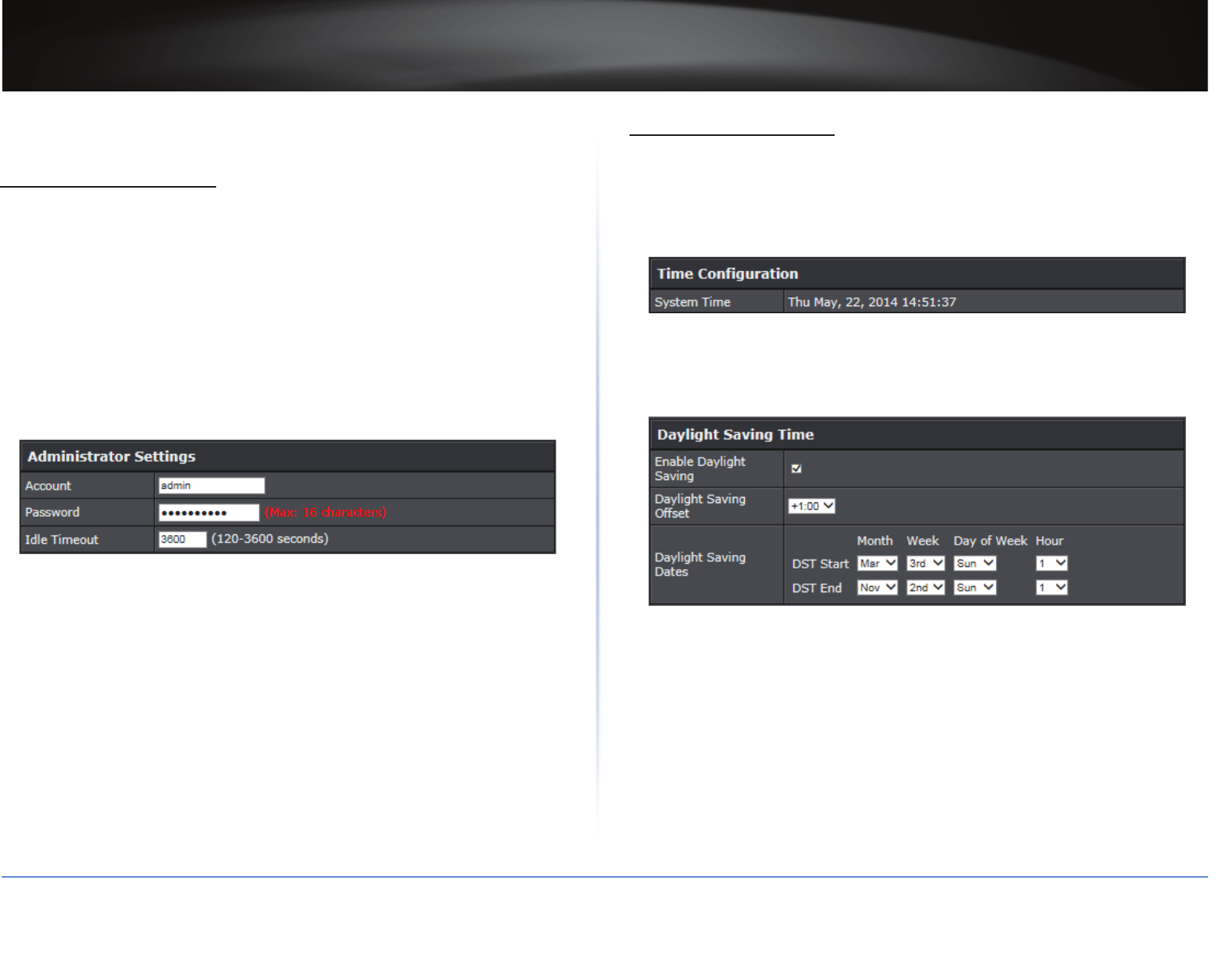
TRENDnet User’s Guide
TEW-823DRU
42
© Copyright 2014 TRENDnet. All Rights Reserved.
Maintenance
Change Login Password
Advanced > Setup > Management
1 Log into your router management page (refer to “Log in to Management Page” on page 8).
2 Click on Advanced > Setup > Management.
3 In Administrator Sengs secon, modify the following parameters:
ͫAccount: Enter the new user name for the router’s Administrator account.
ͫPassword: Enter the password.
ÍNote: The maximum password length is 16 characters.
ͫIdle Timeout: The idle meout seng is used to dene the period of inacvity in the
router management page before you are automacally logged out.
4 Click Apply to save the changes.
ÍNote: To discard the changes, click Cancel.
ÍNote: If you change the router login user name or password, you will need to access
the router management page using the new user name and new password instead
of the predened default password. If you reset the device to defaults, you will need
to access the router management page using the predened sengs on the side or
boom labels.
Set the Date and Time
Advanced > Administrator > Time
1 Log into your router management page (refer to “Log in to Management Page” on page 8).
2 Click on Advanced > Administrator > Time.
3 In Time Conguraon secon, review the system me.
ͫSystem Time: Displays the current device me and date informaon.
4 In Daylight Saving Time secon, modify the following:
ͫEnable Daylight Saving: Check the opon to enable daylight savings me.
ͫDaylight Saving Oset: Select the me zone oset in your locaon.
ͫDaylight Saving Dates: Select the daylight saving start and end dates.
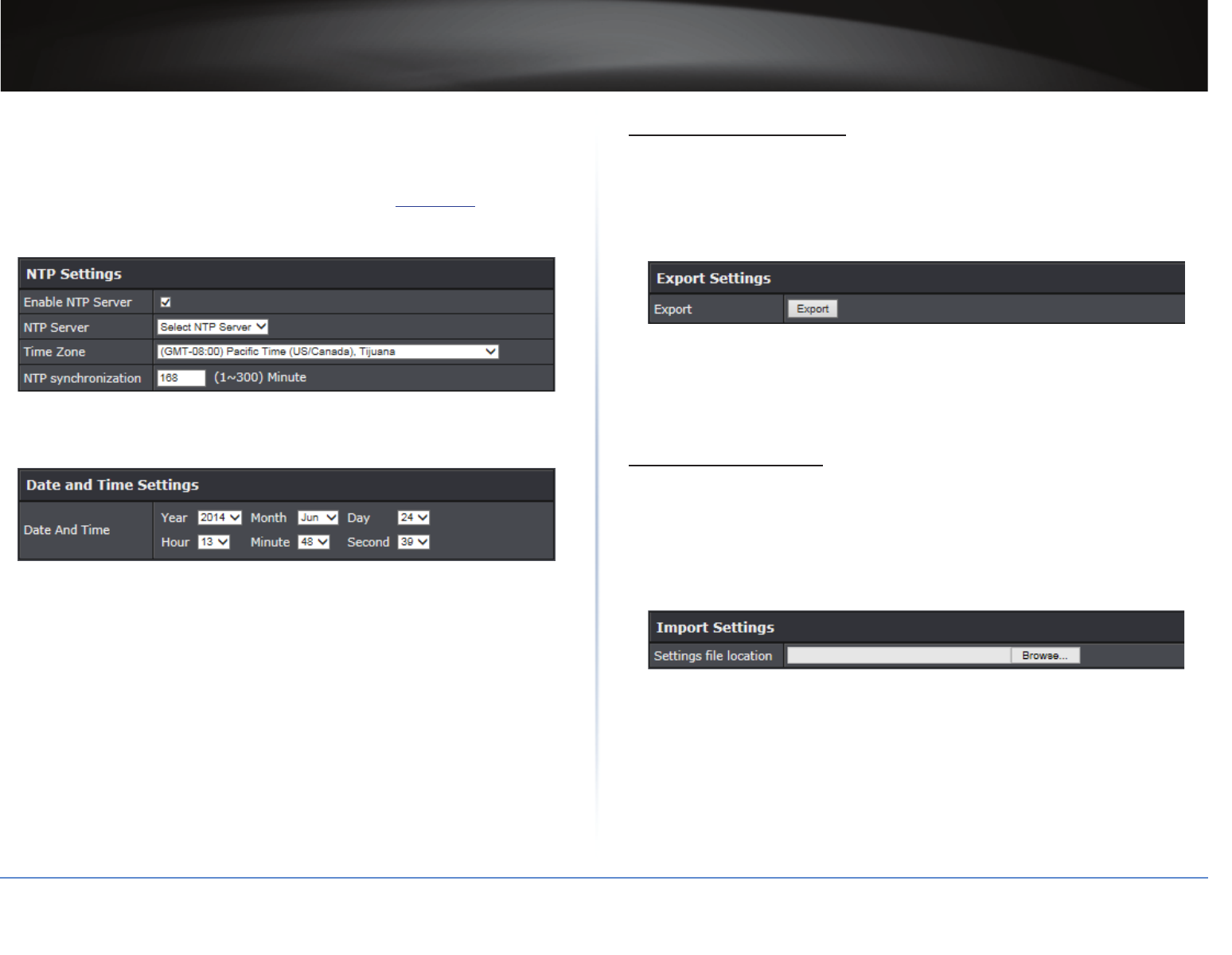
TRENDnet User’s Guide
TEW-823DRU
43
© Copyright 2014 TRENDnet. All Rights Reserved.
5 You can choose to set the device me and date automacally synchronize with the
Internet Time Server or manually set the me. Do one of the following:
ͫEnable NTP Server: Check to enable the NTP server opon. This opon lets you to
synchronize the me and date in router with an NTP (Network Time Protocol) server.
ͫNTP Server: Enter the NTP server address. For example, pool.ntp.org.
ͫTime Zone: Click to select the me zone from the drop-down list.
ͫNTP synchronizaon: Change the NTP synchronizaon period.
ͫ You can set the router’s me and date manually in Date and Time Sengs secon.
ÍNote: Time is specied in 24-hour format.
6 Click Apply to save the changes.
ÍNote: To discard the changes, click Cancel.
Backup System Sengs
Advanced > Administrator > SengsManagement
This opon allows you to backup your access point conguraon.
1 Log into your router management page (refer to “Log in to Management Page” on page 8).
2 Click on Advanced > Administrator > Sengs Management.
3 In Export Sengs secon, click Export.
ÍNote: Depending on your web browser sengs, you may be prompted to save a
le (specify the locaon) or the le may be downloaded automacally to the web
browser sengs default download folder. An example lename, TEW-823DRU_
cong.bin.
Load System Sengs
Advanced > Administrator > SengsManagement
This opon allows you to load the system sengs aer the rmware upgrade or reset to
factory defaults.
1 Log into your router management page (refer to “Log in to Management Page” on page 8).
2 Click on Advanced > Administrator > Sengs Management.
3 In Import Sengs secon, click Browse to load the sengs le.
4 A separate le navigaon window should open.
5 Select the router conguraon le to restore and click Import. The default lename is
TEW-823DRU_cong.bin. If prompted, click Yes or OK.
6 Wait for the router to restore the sengs.
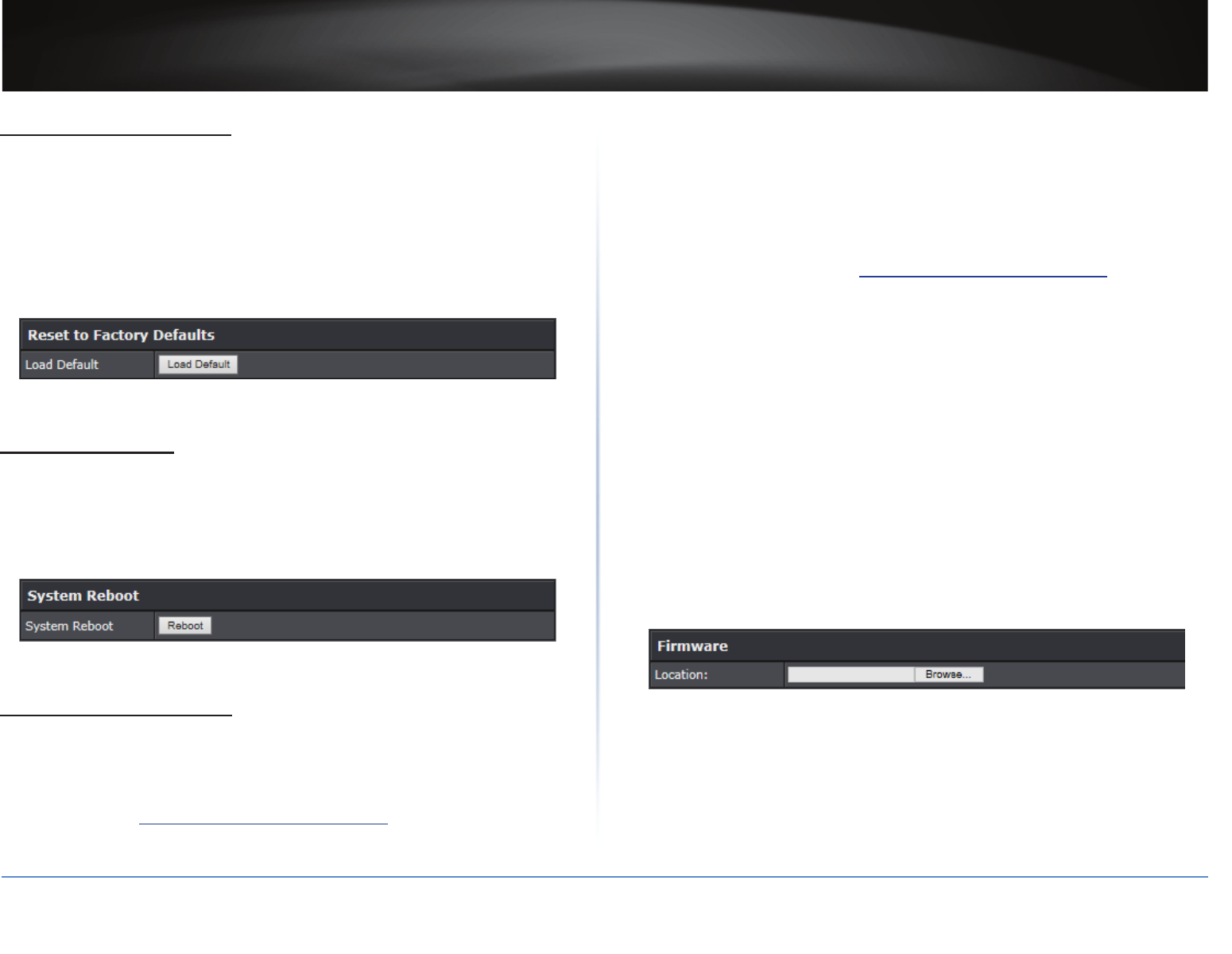
TRENDnet User’s Guide
TEW-823DRU
44
© Copyright 2014 TRENDnet. All Rights Reserved.
Reset to Factory Defaults
Advanced > Administrator > SengsManagement
You may want to reset your router to factory defaults if you are encountering dicules
with your router and have aempted all other troubleshoong. Before you reset your
router to defaults, if possible, you should backup your router conguraon rst, refer to
“Backup System Sengs” on page 43.
1 Log into your router management page (refer to “Log in to Management Page” on page 8).
2 Click on Advanced > Administrator > Sengs Management.
3 In Reset to Factory Defaults secon, click Load Default.
4 You are prompted to conrm to reset to factory default sengs. Click OK.
Reboot the System
Advanced > Administrator > SengsManagement
To reload the system parameters, you may need to reboot the router.
1 Log into your router management page (refer to “Log in to Management Page” on page 8).
2 Click on Advanced > Administrator > Sengs Management.
3 In System Reboot secon, click Reboot.
4 You are prompted to conrm to reboot the device. Click OK.
Update System Firmware
Advanced > Setup > Update Firmware
TRENDnet may periodically release rmware upgrades that may add features or x
problems associated with your TRENDnet router model and version. To check if there is
a rmware upgrade available for your device, please check your TRENDnet model and
version using the link hp://www.trendnet.com/downloads/.
In addion, it is also important to verify if the latest rmware version is newer than the
one your router is currently running. To idenfy the rmware that is currently loaded on
your router, log in to the router, click on the Administrator secon and then on the Status.
The rmware used by the router is listed at the top of this page. If there is a newer version
available, also review the release notes to check if there were any new features you may
want or if any problems were xed that you may have been experiencing.
To download the rmware, do the following:
1 Enter the web browser URL eld hp://www.trendnet.com/downloads/ and download
the rmware to your computer.
2 Unzip the le to a folder on your computer.
ÍNote:
ͳDo not interrupt the rmware upgrade process.
ͳDo not turn o the device during the upgrade.
ͳIf you are upgrading the rmware, using a laptop computer, ensure that the
laptop is connected to a power source or ensure that the baery is fully charged.
ͳDisable sleep mode on your computer as this may interrupt the rmware upgrade
process.
IMPORTANT: Do not interrupt the rmware upgrade process as it may damage your device.
Please wait unl the rmware upload has fully completed and the device has
successfully rebooted.
To start the rmware upgrade, do the following:
1 Log into your router management page (refer to “Log in to Management Page” on page 8).
2 Click on Advanced > Setup > Update Firmware.
3 In Firmware secon, click Browse to load the upgrade le.
4 Navigate to the folder on your computer where the unzipped rmware le (*.bin) is
located and select it.
5 Click Apply. If prompted, click Yes or OK.
ÍNote: To discard the changes, click Cancel.
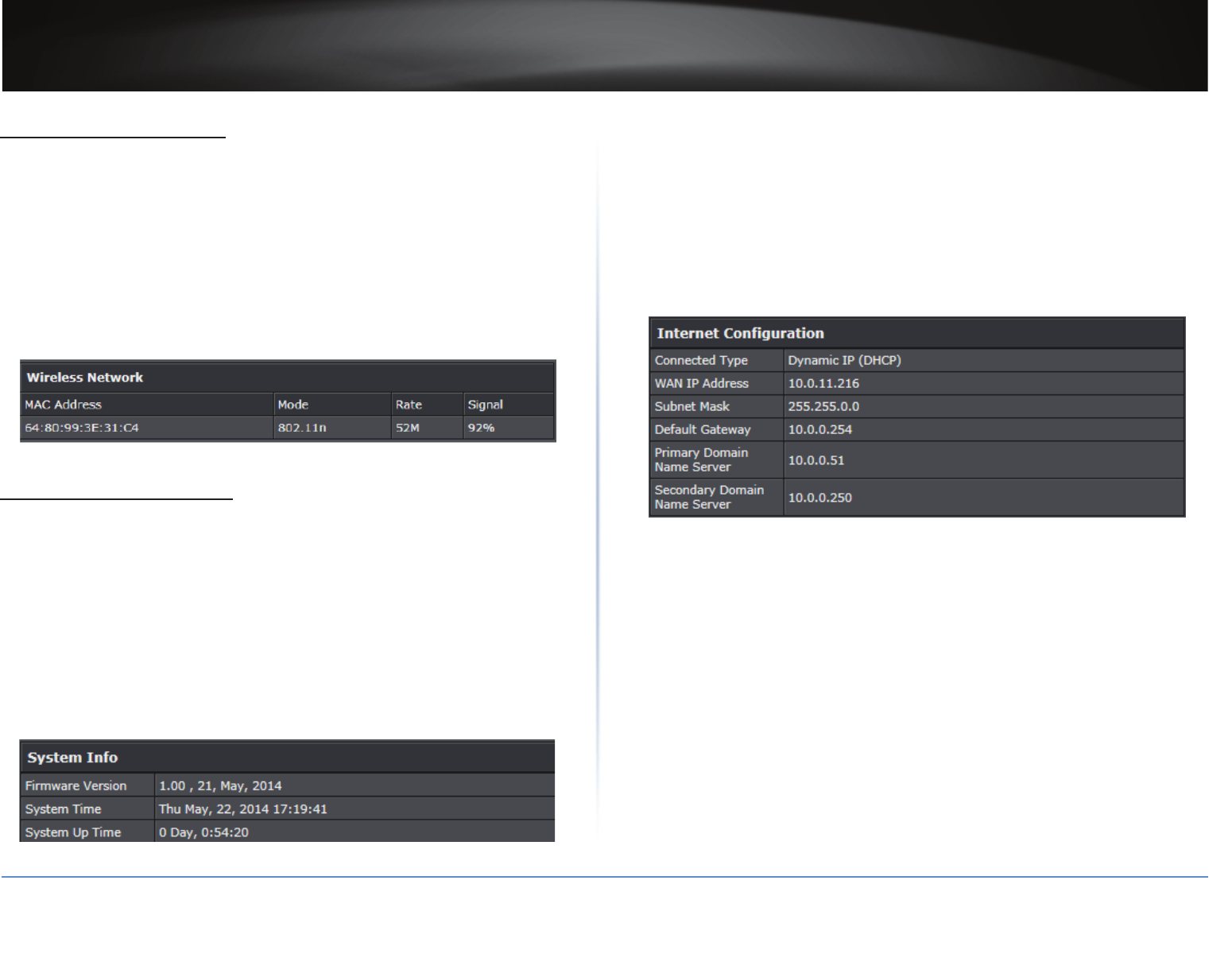
TRENDnet User’s Guide
TEW-823DRU
45
© Copyright 2014 TRENDnet. All Rights Reserved.
View Wireless Client List
Advanced > Wireless (2.4GHz or 5GHz) > StaonList
You can view the list of acve wireless devices currently connected to your router.
1 Log into your router management page (refer to “Log in to Management Page” on page 8).
2 Click on Advanced > Wireless (2.4GHz or 5GHz) > Staon List.
3 In Wireless Network secon, review the connected devices.
ͫMAC Address: Display the current MAC address of your 2.4GHz or 5GHz wireless
client.
ͫMode: Display the 802.11 mode associated with the client.
ͫRate: Display the esmated data rate established with the client.
ͫSignal: Display the esmated signal strength associated with the client.
View System Informaon
Advanced > Administrator > Status
You may want to check the system informaon of your router such as WAN (Internet)
connecvity, wireless and wired network sengs, router MAC address, and rmware
version.
1 Log into your router management page (refer to “Log in to Management Page” on page 8).
2 Click on Advanced > Administrator > Status.
3 In System Info secon, view the following values:
ͫFirmware Version: Display the current rmware version your router is running.
ͫSystem Time: Display the current me set on your router.
ͫSystem Up Time: Display the duraon your router has been running connuously
without a restart/power cycle (hard or so reboot) or reset.
4 In Internet Conguraon secon, view the following values:
ͫConnected Type: Display the current WAN connecon type applied.
ͫWAN IP Address: Display the current IP address assigned to your router WAN port or
interface conguraon.
ͫSubnet Mask: Display the current subnet mask assigned to your router WAN port or
interface conguraon.
ͫDefault Gateway: Display the current gateway assigned to your router WAN port or
interface conguraon.
ͫPrimary/Secondary DNS (Domain Name System) Server: Display the current DNS
address(es) assigned to your router port or interface conguraon.
ÍNote:
ͳRenew/Release buons will be available only for DHCP WAN type. The
Renew buon allows to renew your WAN IP address and Release buon
allows you to release the WAN IP address of your router.
ͳConnect/Disconnect buons will be available only for PPPoE DHCP WAN type.
The Connect buon allows the connecon to your DSL ISP and Disconnect
buon allows to disconnect from your DSL ISP.
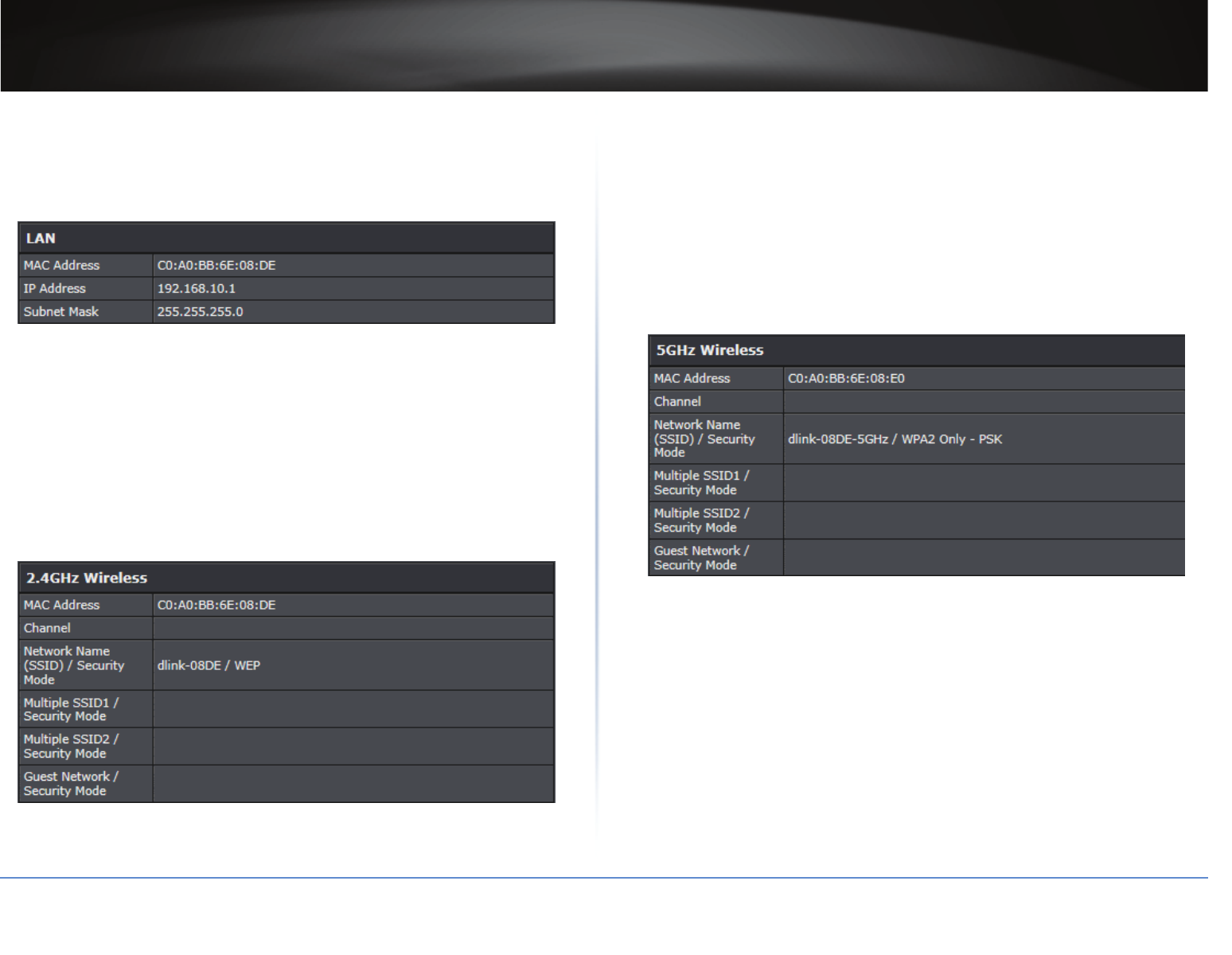
TRENDnet User’s Guide
TEW-823DRU
46
© Copyright 2014 TRENDnet. All Rights Reserved.
5 In LAN secon, view the following values:
ͫMAC Address: Display the current MAC address of your router’s wireless or interface
conguraon.
ͫIP Address: Display your router’s current IP address.
ͫSubnet Mask: Display your router’s current subnet mask.
6 In 2.4HGz Wireless secon, view the following values:
ͫMAC Address: Display the MAC address of your router’s 2.4GHz wireless LAN
interface conguraon.
ͫNetwork Name (SSID) / Security Mode: The displays the current 2.4GHz primary
wireless network name and security mode assigned to your router.
ͫMulple SSID1 / Security Mode: Display the current 2.4GHz wireless network name
and security mode of mulple SSID1 assigned to your router.
ͫMulple SSID2 / Security Mode: Display the current 2.4GHz wireless network name
and security mode of mulple SSID2 assigned to your router.
ͫGuest Network / Security Mode: Display the current 2.4GHz wireless network name
and security mode of the guest network assigned to your router.
7 In 5HGz Wireless secon, view the following values:
ͫMAC Address: Display the MAC address of your router’s 5GHz wireless LAN interface
conguraon.
ͫNetwork Name (SSID) / Security Mode: Display the current 5GHz primary wireless
network name and security mode assigned to your router.
ͫMulple SSID1 / Security Mode: Display the current 5GHz wireless network name
and security mode of mulple SSID1 assigned to your router.
ͫMulple SSID2 / Security Mode: Display the current 5GHz wireless network name
and security mode of mulple SSID2 assigned to your router.
ͫGuest Network / Security Mode: Display the current 5GHz wireless network name
and security mode of the guest network assigned to your router.
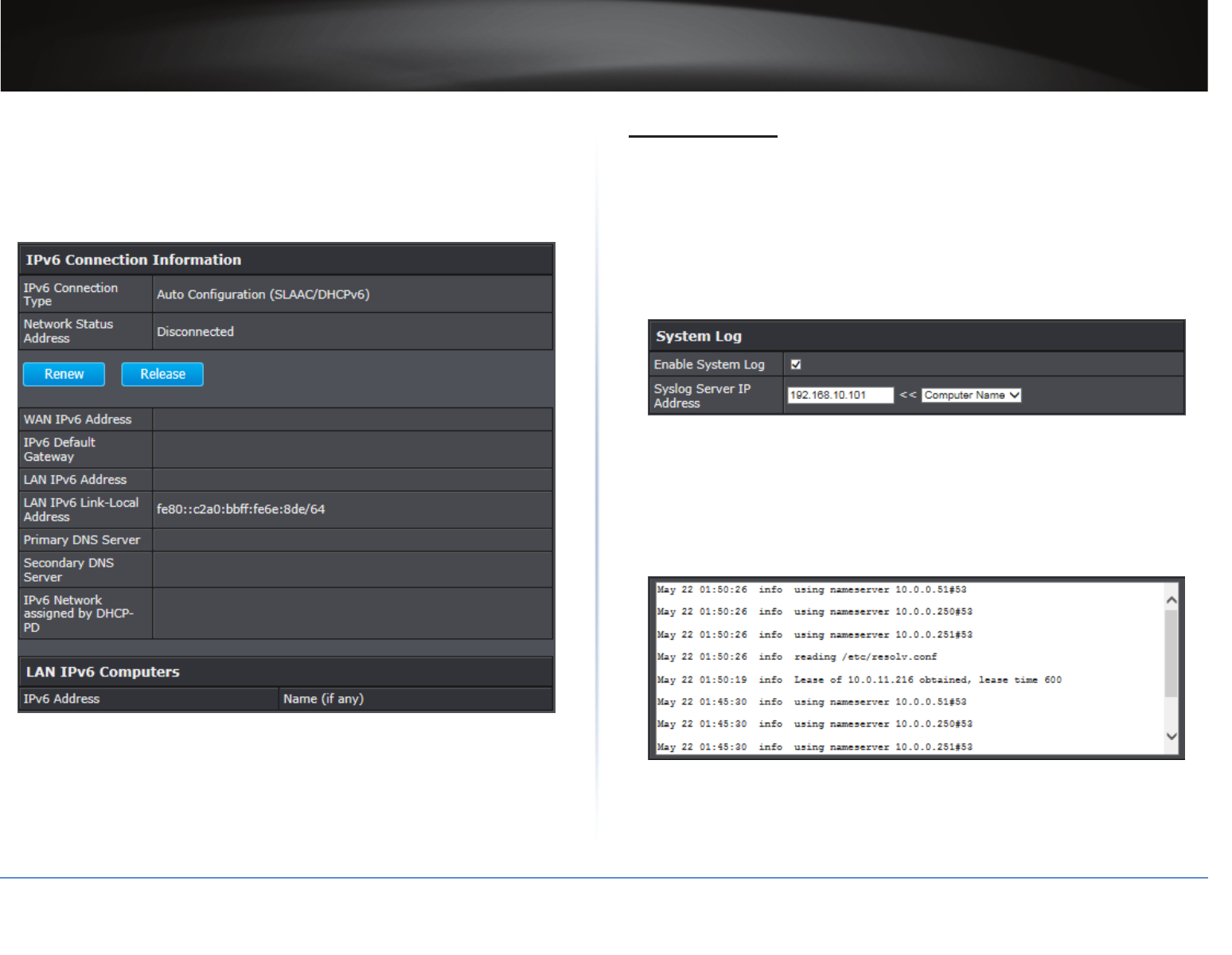
TRENDnet User’s Guide
TEW-823DRU
47
© Copyright 2014 TRENDnet. All Rights Reserved.
IPv6 Status
Advanced > Administrator > IPv6 Status
You can view the current IPv6 status on your router.
1 Log into your router management page (refer to “Log in to Management Page” on page 8).
2 Click on Advanced > Administrator > IPv6 Status.
View Events Log
Advanced > Administrator > SystemLog
Your router log can be used to obtain acvity informaon on the funconality of your
router or for troubleshoong purposes.
1 Log into your router management page (refer to “Log in to Management Page” on page 8).
2 Click on Advanced > Administrator > System Log.
3 In System Log secon, check the Enable System Log opon to enable logging. The logging
will display in the log window.
4 Enter the system log server IP address to Syslog Server IP Address eld.
5 Do any of the following:
ͫClick Apply buon to save the changes.
ͫClick Refresh buon to refresh the log window to ensure the most recent logging
informaon is displayed.
ͫClick Clear buon to clear and delete all of the current logging informaon.
Log Window:
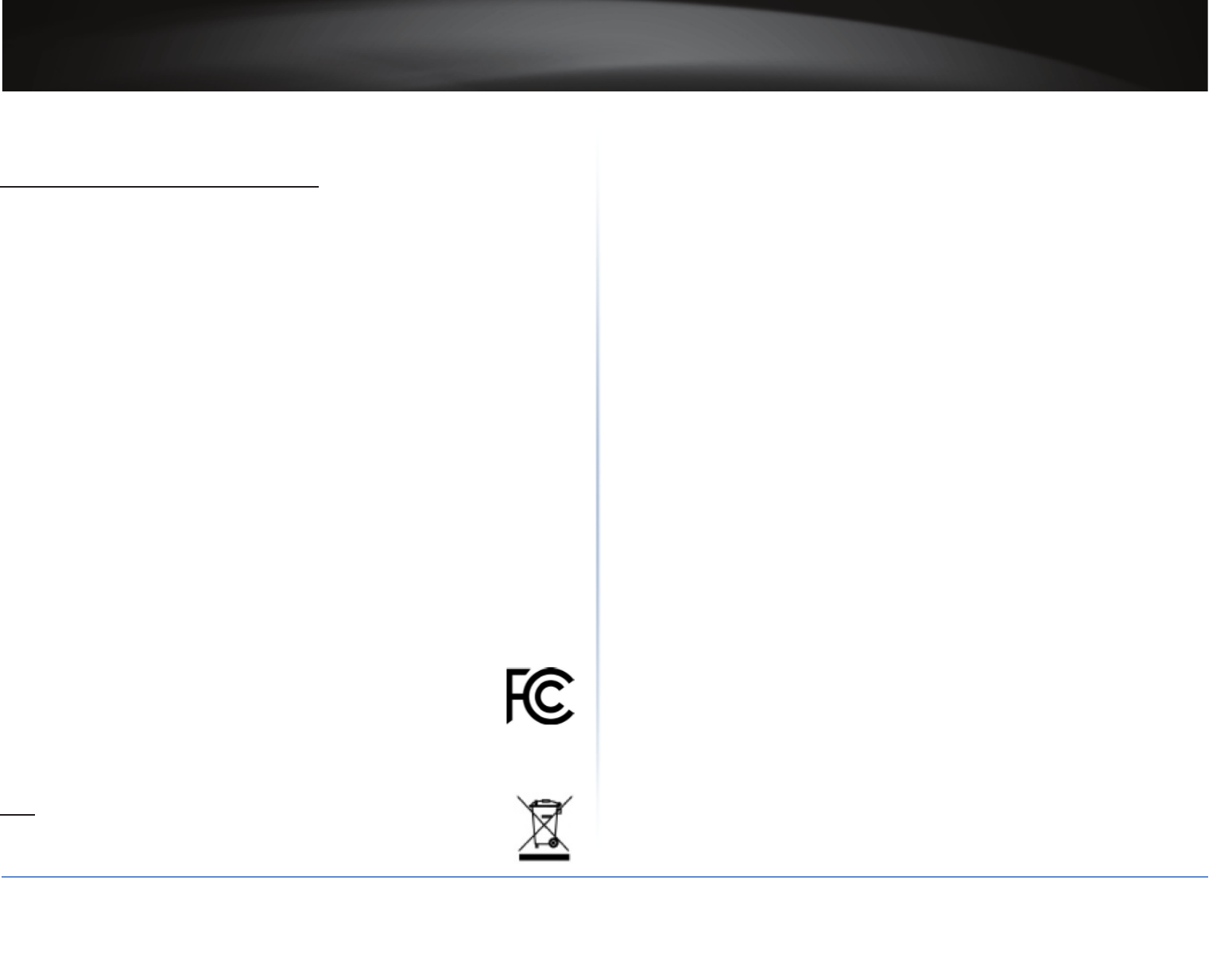
TRENDnet User’s Guide
TEW-823DRU
48
© Copyright 2014 TRENDnet. All Rights Reserved.
Appendix
Regulatory and Safety Informaon
Federal Communicaon Commission Interference Statement
This device complies with Part 15 of the FCC Rules. Operaon is subject to the following
two condions: (1) This device may not cause harmful interference, and (2) this device
must accept any interference received, including interference that may cause undesired
operaon. This equipment has been tested and found to comply with the limits for a
Class B digital device, pursuant to Part 15 of the FCC Rules. These limits are designed to
provide reasonable protecon against harmful interference in a residenal installaon.
This equipment generates, uses and can radiate radio frequency energy and, if not
installed and used in accordance with the instrucons, may cause harmful interference
to radio communicaons. However, there is no guarantee that interference will not occur
in a parcular installaon. If this equipment does cause harmful interference to radio or
television recepon, which can be determined by turning the equipment o and on, the
user is encouraged to try to correct the interference by one of the following measures:
• Reorient or relocate the receiving antenna.
• Increase the separaon between the equipment and receiver.
• Connect the equipment into an outlet on a circuit dierent from that to which the
receiver is connected.
• Consult the dealer or an experienced radio/TV technician for help.
FCC Cauon: Any changes or modicaons not expressly approved by the party responsible
for compliance could void the user’s authority to operate this equipment.
Operaons in the 5.15-5.25GHz band are restricted to indoor usage only.
This transmier must not be co-located or operang in conjuncon with any other antenna
or transmier.
IMPORTANT NOTE:
Radiaon Exposure Statement: This equipment complies with FCC radiaon exposure
limits set forth for an uncontrolled environment. This equipment should be installed and
operated with minimum distance 20cm between the radiator & your body.
RoHS
This product is RoHS compliant.
Europe – EU Declaraon of Conformity
This device complies with the essenal requirements of the R&TTE Direcve 1999/5/EC,
2006/95/EC and 2009/125/EC.
Regulaon (EC) No. 1275/2008
Regulaon (EC No. 278/2009
EN60950-1 : 2006 + A11 : 2009 + A1: 2010 + A12: 2011
Safety of Informaon Technology Equipment.
EN 62311: 2008
Assessment of electronic and electrical equipment related to human exposure restricons for
electromagnec elds (0 Hz-300 GHz).
EN 300 328 V1.8.1 : (2012-06) Class B
Electromagnec compability and Radio spectrum Maers (ERM); Wideband Transmission
systems; Data transmission equipment operang in the 2,4 GHz ISM band and using spread
spectrum modulaon techniques; Harmonized EN covering essenal requirements under
arcle 3.2 of the R&TTE Direcve.
EN 301 489-1 V1.9.2 : (2011-09)
Electromagnec compability and Radio Spectrum Maers (ERM); ElectroMagnec
Compability (EMC) standard for radio equipment and services; Part 1: Common technical
requirements.
EN 301 489-17 V2.2.1 : (2012-09)
Electromagnec compability and Radio spectrum Maers (ERM); ElectroMagnec Compability
(EMC) standard for radio equipment; Part 17: Specic condions for 2,4 GHz wideband
transmission systems, 5 GHz high performance RLAN equipment and 5,8 GHz Broadband Data
Transming Systems.
EN 301 893 V1.7.1 : (2012-06)
Broadband Radio Access Networks (BRAN);5 GHz high performance RLAN;Harmonized EN
covering the essenal requirements of arcle 3.2 of the R&TTE Direcve This device is a 2.4/5G
GHz wideband transmission system (transceiver), intended for use in all EU member states and
EFTA countries, except in France and Italy where restricve use applies.
In Italy the end-user should apply for a license at the naonal spectrum authories in order to
obtain authorizaon to use the device for seng up outdoor radio links and/or for supplying
public access to telecommunicaons and/or network services.
This device may not be used for seng up outdoor radio links in France and in some areas
the RF output power may be limited to 10 mW EIRP in the frequency range of 2454 – 2483.5
MHz. For detailed informaon the end-user should contact the naonal spectrum authority in
France.
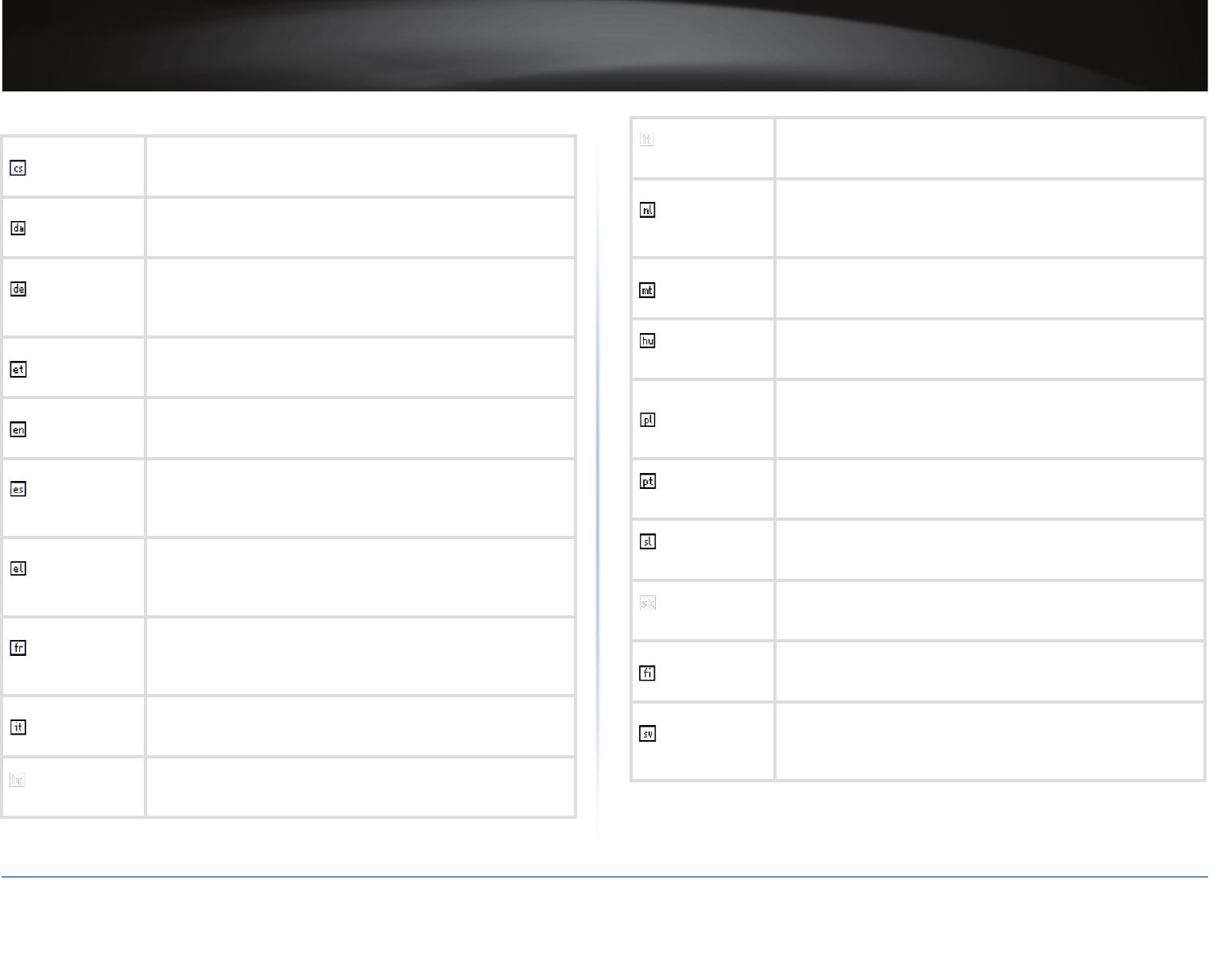
TRENDnet User’s Guide
TEW-823DRU
49
© Copyright 2014 TRENDnet. All Rights Reserved.
Česky [Czech]
TRENDnet mto prohlašuje, že tento TEW-823DRU je ve shodě se
základními požadavky a dalšími příslušnými ustanoveními směrnice
1999/5/ES, 2006/95/ES, a 2009/125/ES.
Dansk [Danish]
Undertegnede TRENDnet erklærer herved, at følgende udstyr TEW-
823DRU overholder de væsentlige krav og øvrige relevante krav i
direkv 1999/5/EF, 2006/95/EF, og 2009/125/EF.
Deutsch
[German]
Hiermit erklärt TRENDnet, dass sich das Gerät TEW-823DRU in
Übereinsmmung mit den grundlegenden Anforderungen und den
übrigen einschlägigen Besmmungen der Richtlinie 1999/5/EG,
2006/95/EG und 2009/125/EG bendet.
Ees [Estonian]
Käesolevaga kinnitab TRENDnet seadme TEW-823DRU vastavust
direkivi 1999/5/EÜ, 2006/95/EÜ ja 2009/125/EÜ põhinõuetele ja
nimetatud direkivist tulenevatele teistele asjakohastele sätetele.
English
Hereby, TRENDnet, declares that this TEW-823DRU is in compliance
with the essenal requirements and other relevant provisions of
Direcve 1999/5/EC, 2006/95/EC, and 2009/125/EC.
Español
[Spanish]
Por medio de la presente TRENDnet declara que el TEW-823DRU
cumple con los requisitos esenciales y cualesquiera otras
disposiciones aplicables o exigibles de la Direcva 1999/5/CE,
2006/95/CE, 2009/125/CE y.
Ελληνική
[Greek]
ΜΕ ΤΗΝ ΠΑΡΟΥΣΑTRENDnet ΔΗΛΩΝΕΙ ΟΤΙTEW-
823DRUΣΥΜΜΟΡΦΩΝΕΤΑΙ ΠΡΟΣ ΤΙΣ ΟΥΣΙΩΔΕΙΣ ΑΠΑΙΤΗΣΕΙΣ ΚΑΙ
ΤΙΣ ΛΟΙΠΕΣ ΣΧΕΤΙΚΕΣ ΔΙΑΤΑΞΕΙΣ ΤΗΣ ΟΔΗΓΙΑΣ 1999/5/ΕΚ, 2006/95/
ΕΚ, 2009/125/ΕΚ και.
Français
[French]
Par la présente TRENDnet déclare que l’appareil TEW-823DRU est
conforme aux exigences essenelles et aux autres disposions
pernentes de la direcve 1999/5/CE, 2006/95/CE, 2009/125/CE
et.
Italiano[Italian]
Con la presente TRENDnet dichiara che questo TEW-823DRU è
conforme ai requisi essenziali ed alle altre disposizioni pernen
stabilite dalla direva 1999/5/CE, 2006/95/CE e 2009/125/CE.
Latviski
[Latvian]
AršoTRENDnetdeklarē, ka TEW-823DRU atbilstDirekvas 1999/5/
EK, 2006/95/EK, un 2009/125/EK būskajāmprasībām un ciemar
to saistajiemnoteikumiem.
Lietuvių
[Lithuanian]
Šiuo TRENDnet deklaruoja, kad šis TEW-823DRU anka esminius
reikalavimus ir kitas 1999/5/EB, 2006/95/EB ir 2009/125/EB
Direktyvos nuostatas.
Nederlands
[Dutch]
Hierbij verklaart TRENDnet dat het toestel TEW-823DRU in
overeenstemming is met de essenële eisen en de andere
relevante bepalingen van richtlijn 1999/5/EG, 2006/95/EG, en
2009/125/EG.
Mal [Maltese]
Hawnhekk, TRENDnet, jiddikjara li dan TEW-823DRU jikkonforma
mal-ħġijiet essenzjali u ma provvedimen oħrajn relevan li
hemm d-Dirreva 1999/5/KE, 2006/95/KE, u 2009/125/KE.
Magyar
[Hungarian]
Alulíro, TRENDnet nyilatkozom, hogy a TEW-823DRUmegfelel a
vonatkozó alapvetõ követelményeknek és az 1999/5/EK irányelv, a
2006/95/EK és a 2009/125/EK irányelv egyéb elõírásainak.
Polski [Polish]
Niniejszym TRENDnet oświadcza, że TEW-823DRU jest zgodny
z zasadniczymi wymogami oraz pozostałymi stosownymi
postanowieniami Dyrektywy 1999/5/WE, 2006/95/WE i 2009/125/
WE.
Português
[Portuguese]
TRENDnet declara que este TEW-823DRU está conforme com os
requisitos essenciais e outras disposições da Direcva 1999/5/CE,
2006/95/CE e 2009/125/CE.
Slovensko
[Slovenian]
TRENDnet izjavlja, da je ta TEW-823DRU v skladu z bistvenimi
zahtevami in ostalimi relevantnimi določili direkve 1999/5/ES,
2006/95/ES in 2009/125/ES.
Slovensky
[Slovak]
TRENDneýmtovyhlasuje, že TEW-
823DRUspĺňazákladnépožiadavky a všetkypríslušnéustanoveniaSm
ernice 1999/5/ES, 2006/95/ES, a 2009/125/ES.
Suomi [Finnish]
TRENDnet vakuuaa täten eä TEW-823DRU tyyppinen laite on
direkivin 1999/5/EY, 2006/95/EY ja 2009/125/EY oleellisten
vaamusten ja sitä koskevien direkivin muiden ehtojen mukainen.
Svenska
[Swedish]
Härmed intygar TRENDnet a denna TEW-823DRU står I
överensstämmelse med de väsentliga egenskapskrav och övriga
relevanta bestämmelser som framgår av direkv 1999/5/EG,
2006/95/EG och 2009/125/EG.

TRENDnet User’s Guide
TEW-823DRU
50
© Copyright 2014 TRENDnet. All Rights Reserved.
Specicaons
Item Specicaons
Standards • IEEE 802.11b/g/n Wireless LAN 2.4GHz
• IEEE 802.11a/n/ac Wireless LAN 5GHz
• IEEE 802.3/IEEE 802.3z Gigabit Ethernet
• ANSI/IEEE 802.3 Auto negoaon
Radio Technology • IEEE 802.11g / IEEE 802.11n / IEEE 802.11a/n/ac
Orthogonal Frequency Division Mulplexing (OFDM)
• IEEE 802.11b: Direct Sequence Spread Spectrum (DSSS)
Transmission Rate • 802.11ac: up to 1300Mbps
• 802.11an: up to 450Mbps
• 802.11a: up to 54Mbps
• 802.11n: up to 450Mbps
• 802.11g: up to 54Mbps
• 802.11b: up to 11Mbps
Receiver Sensivity • 11ac VHT80 MCS9: Typical - 51dBm @ 10% PER
• 11ac VHT40 MCS9: Typical - 54dBm @ 10% PER
• 11ac VHT20 MCS9: Typical - 57dBm @ 10% PER
• 11a/n HT40 MCS7/15/23: Typical - 61dBm @ 10% PER
• 11a/n HT20 MCS7/15/23: Typical - 64dBm @ 10% PER
• 11a/g 54Mbps: Typical - 65dBm @ 10% PER
• 11b 11Mbps: Typical - 83dBm @ 8% PER
Wireless LAN Frequency
Range
• 2.4GHz: 2412 ~ 2472 MHz ISM band (channels 1 ~ 13)
• 5GHz: 5180 ~ 5825 MHz ISM band (channels 36 ~ 165)
Modulaon Schemes • DBPSK/DQPSK/CCK for DSSS technique
• BPSK/QPSK/16-QAM/64-QAM/256-QAM for OFDM
technique
Media Access Protocol CSMA/CA with ACK
Item Specicaons
Transmit Power
(RF Output Power at each
RF chain)
2.4GHz Mode
• FCC:18dBm,ETSI:16dBm (max) @ 802.11b
• FCC:22dBm,ETSI:15dBm (max) @ 802.11g
• FCC:22dBm,ETSI:15dBm (max) @ 802.11n HT20
• FCC:18dBm,ETSI:16dBm (max) @ 802.11n HT40
5GHz Mode
• FCC:20dBm,ETSI:20dBm (max) @ 802.11a
• FCC:20dBm,ETSI:20dBm (max) @ 802.11n HT20 /
802.11ac VHT20
• FCC:20dBm,ETSI:20dBm (max) @ 802.11n HT40 /
802.11ac VHT40
• FCC:14dBm,ETSI:20dBm (max) @ 802.11ac VHT80
Antenna Type • 2.4 GHz: 3 x 2dBi (Peak) PCB Antenna’s internal
• 5 GHz: 3 x 3dBi (Peak) PCB Antenna’s internal
Protocol TCP/IP
Interface • LAN: 4 x 10/100/1000Mbps Auto-MDIX Gigabit
Ethernet ports
• WAN: 1 x 10/100/1000Mbps Auto-MDIX Gigabit
Ethernet port
• Reset buon
• WPS buon
• On/o power switch
• Power Jack
Supported Network
Protocols
• TCP/IP
• NAT
• PPPoE/PPTP/L2TP
• HTTP
DHCP Server/Client
Network Management
Web base conguraon ulity via Ethernet
Channel • 2.4GHz: Channel 1 ~ 11(FCC), Channel 1 ~ 13(ETSI)
• 5 GHz: 36, 40, 44, 48, 149, 153, 157, 161 and 165 (FCC),
36, 40, 44, 48,52,56, 60, 64, 100, 104, 108, 112, 116,
120, 124, 128, 132, 136, 140 (ETSI)
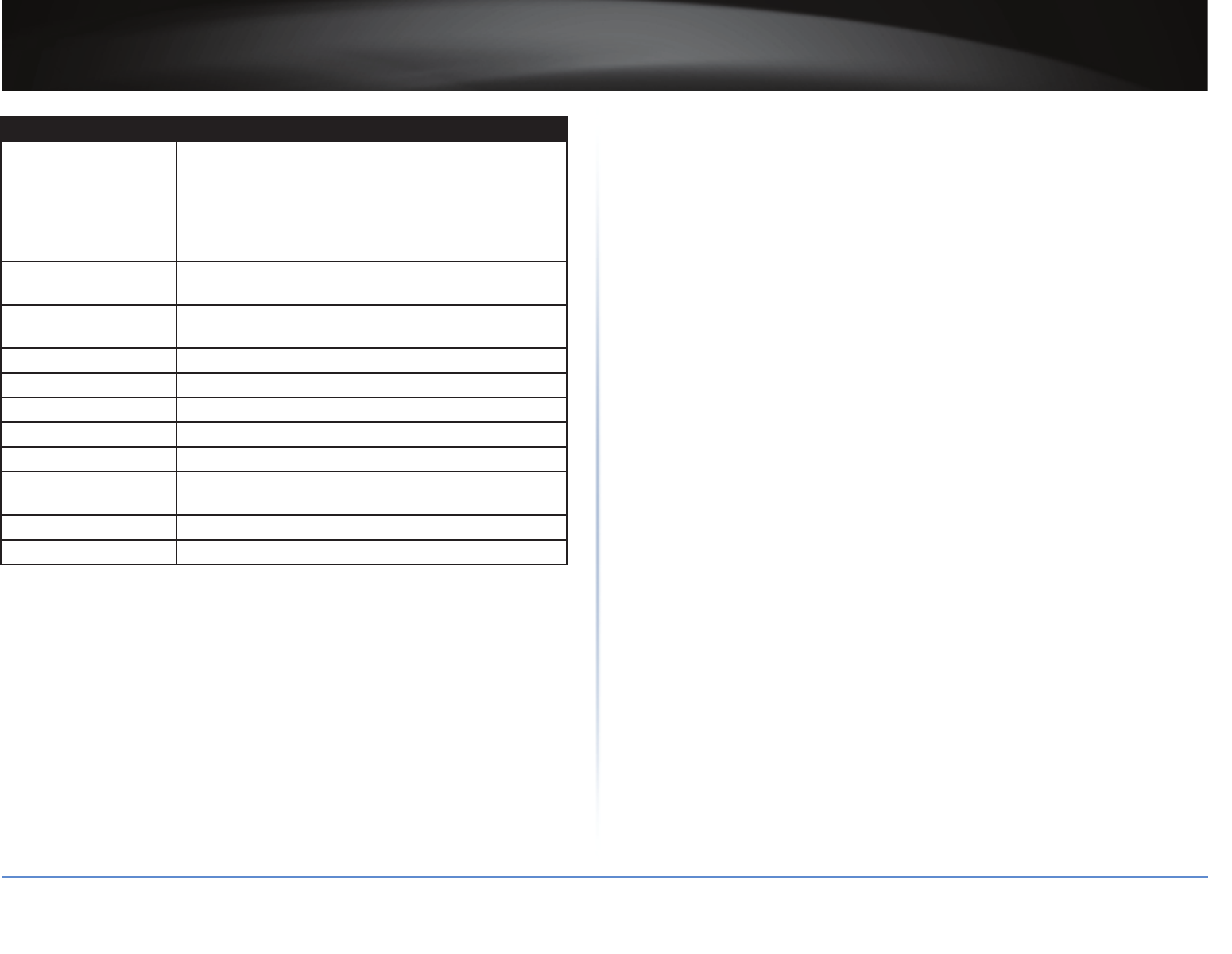
TRENDnet User’s Guide
TEW-823DRU
51
© Copyright 2014 TRENDnet. All Rights Reserved.
Item Specicaons
Security • 64/128-bits WEP Encrypon
• WPA, WPA2
• WPA-PSK, WPA2-PSK
• MAC address ltering (Up to 24 entries)
• Protocol ltering
• Domain ltering
Range Coverage • Indoor: Up to 100 meters (depends on environment)
• Outdoor: Up to 300 meters (depends on environment)
Diagnosc LEDs • Power
• Internet (WAN port)
Power Adapter 12VDC / 2A external power adapter
Power Consumpon 1500 mA(max.)
Operaon Temperature 0 ~ 40°C
Storage Temperature -10 ~ 70°C
Humidity 10% ~ 95% RH, no condensaon
Cercaons • FCC cercate for USA
• CE cercate for Europe
Dimensions (W x H x D) 151 x 191 x 45.5 mm
Weight 413g
*Maximum wireless signal rates are referenced from IEEE 802.11 theorecal specicaons. Actual
data throughput and coverage will vary depending on interference, network trac, building
materials and other condions.

Product Warranty Registration
Please take a moment to register your product online.
Go to TRENDnet’s website at http://www.trendent.com/register
TRENDnet
20675 Manhattan Place
Torrance, CA 90501. USA
Copyright ©2014. All Rights Reserved.TRENDnet.